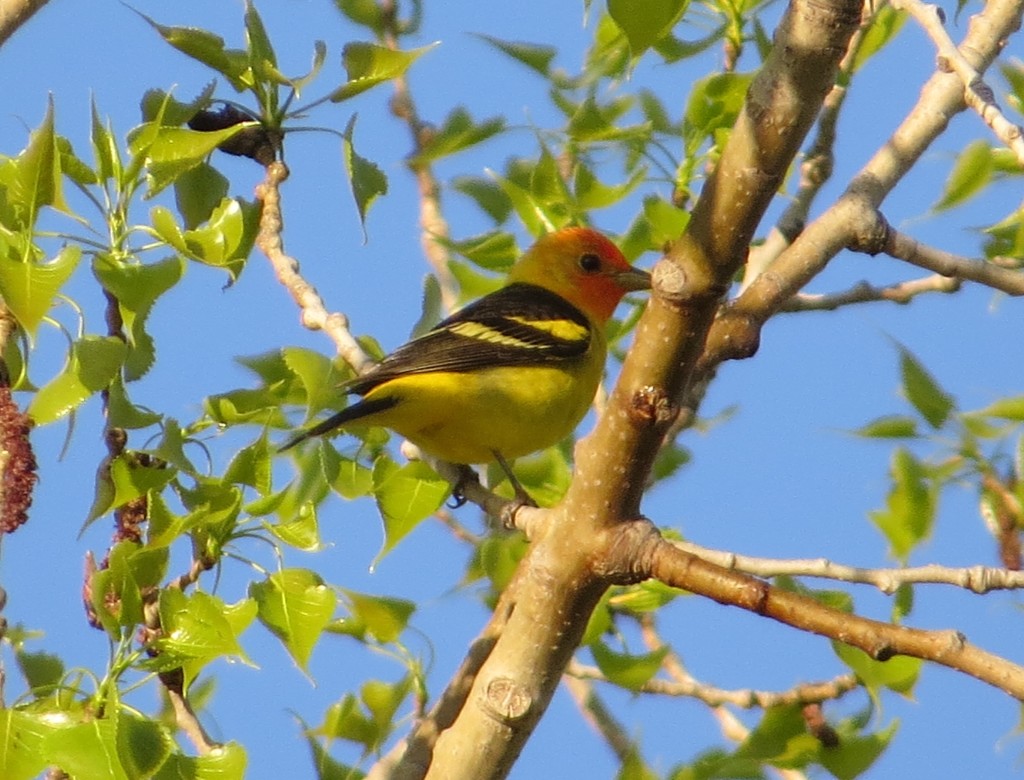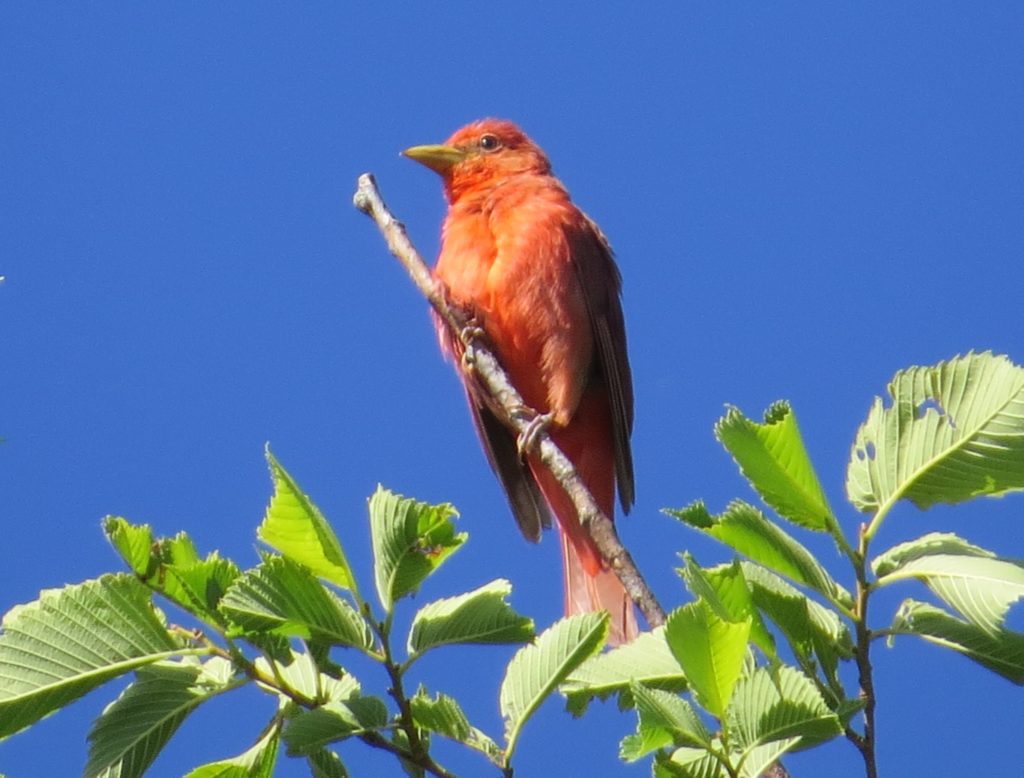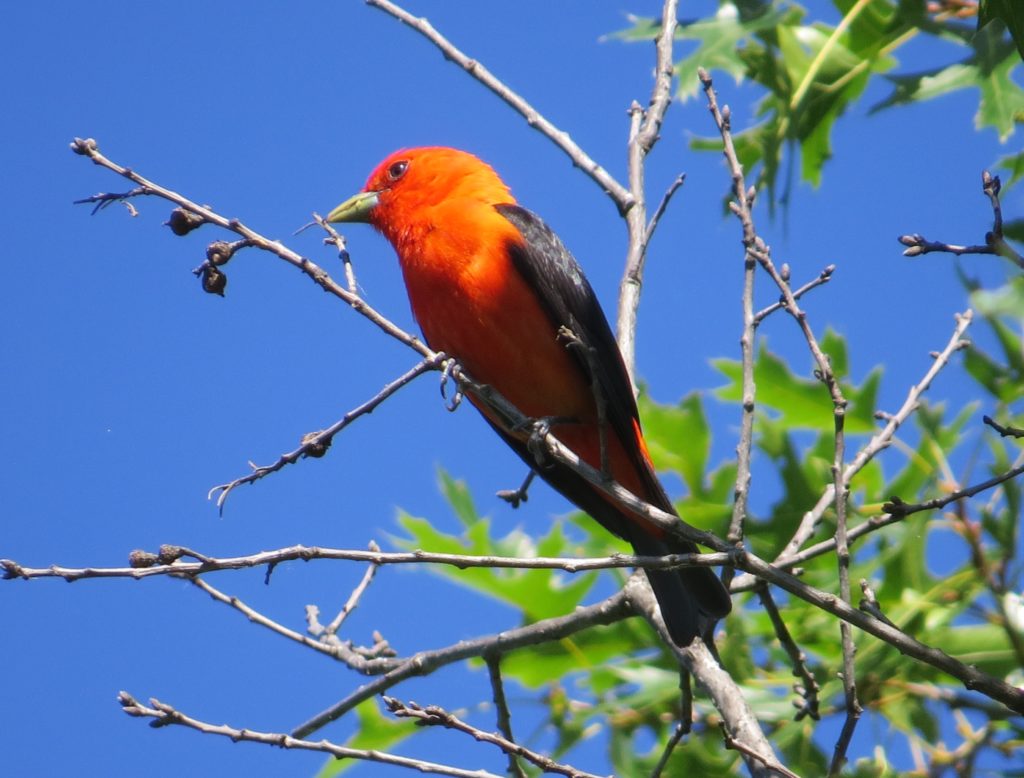Birding has been intense this past migration. County birds and new life birds have not waited for me to write up trip reports this past April to SE AZ or even this past February to Duluth! It has been non-stop action which is great for birding and listing but not so great for blogging and documenting. Needless to say, there is a backlog of photos, tales, etc that need to be shared, and frankly, I find the task daunting. So I will chew this elephant one bite at a time by giving a relatively brief run-down of 5, yes 5!, genuine life birds I have seen in MINNESOTA over the span of four weeks. In the last couple years I have tried to scale back on my chasing by only going after true life birds. I have given up on making long distance chases for mere state birds. Even under these new self-imposed rules, I have been super busy…
On April 29th, I chased a female/1st year male Painted Bunting that showed up at Paul Suchanek’s farm near Owatonna, an unseemly mecca for all kinds of rarities. Seeing PABU was one of my main birding goals for 2018, though I was kind of holding out for the more splashy adult male. But as they say, beggars can’t be choosers. At least I could choose a cute companion for part of my chase–Marin joined me on the trip for a 1/3 of the way so she could hang out with her grandparents in Hutch while I continued on. It was nice to have the company, however brief.
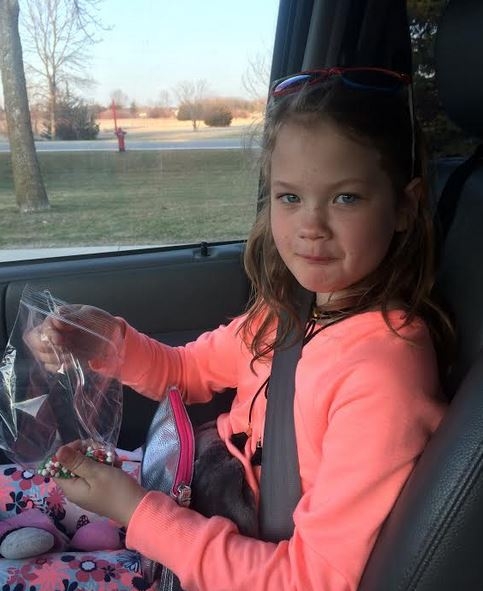
I was expecting this to be a 5-hour round trip dip, honestly. The wind was ferocious that whole day, something I was sure that would move the little vagrant along. Apparently Paul’s set-up was just too bird friendly because the PABU persisted giving me a bittersweet lifer (I wish it was a male).
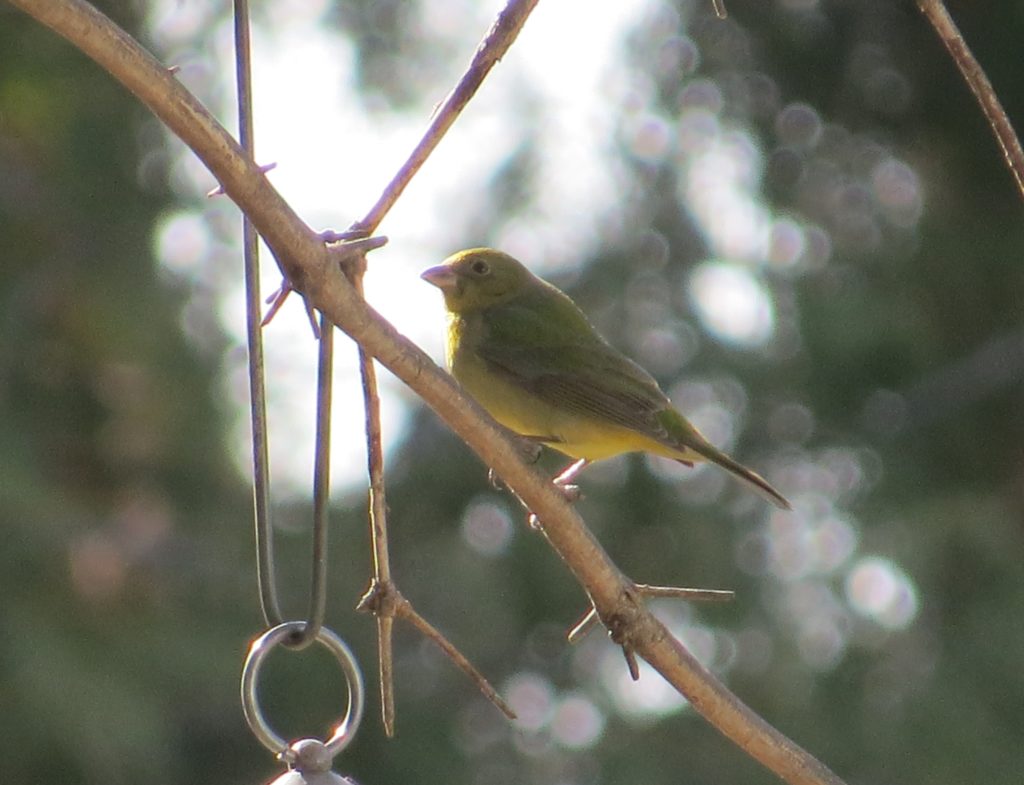
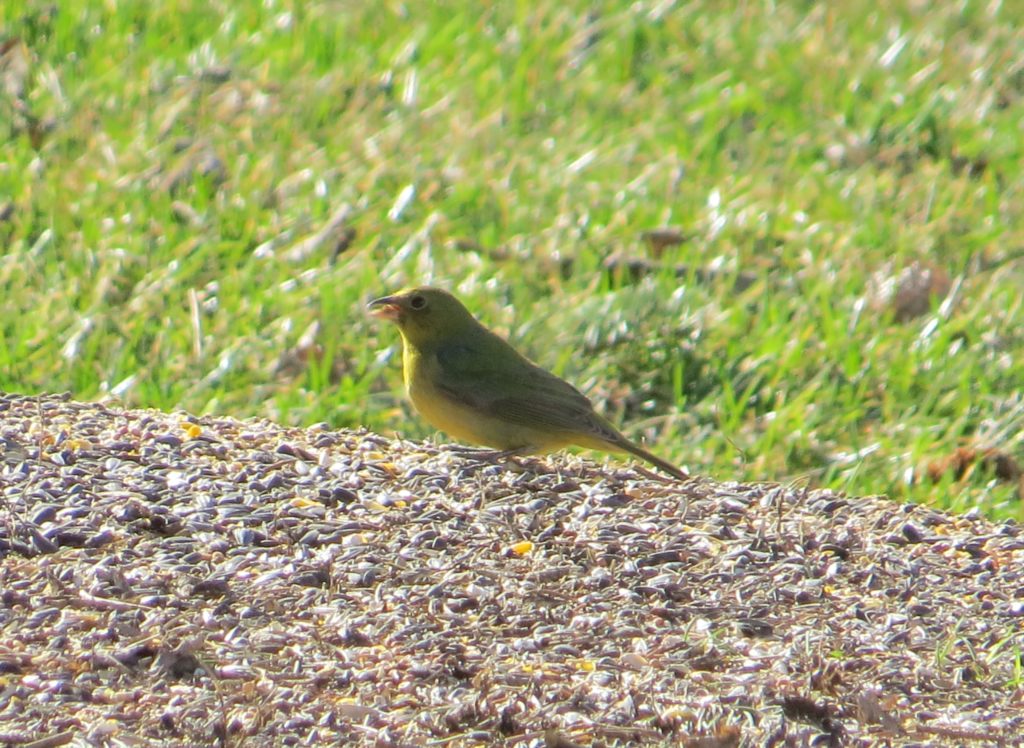
On May 5th, the kids and I chased a Kentucky Warbler in Northfield, MN. Despite a solid effort, we came up short. So here’s a picture of a Barred Owl we saw in the place of a Kentucky Warbler. Despite their cool factor, Barred Owls do little to sooth the pain of a half-day dip.
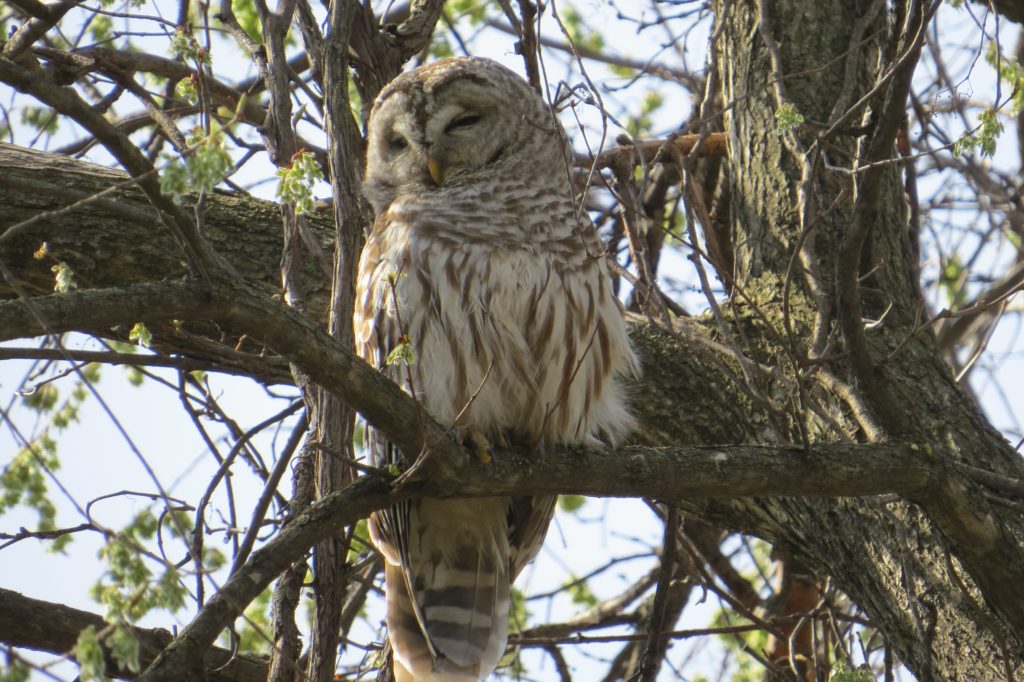
On May 8th, birding phenom and fresh college grad, Garrett Wee, sent shock waves through the Minnesota birding community with the discovery of the state’s fifth ever Curlew Sandpiper. Since this bird was a mere hour away at Lone Tree Lake by Cottonwood, it was an easy chase to make. Steve Gardner and I headed down there immediately after work. Garrett was still there, like a proud papa, greeting all the guests that came to see his baby. It was a stunning find that Garrett picked out from the nearly 2,000 shorebirds feeding in the shallow lake. Wind and distance made for very difficult viewing and photography conditions. I’m not complaining, though. How can I when I got to see a shorebird I never thought I would see?
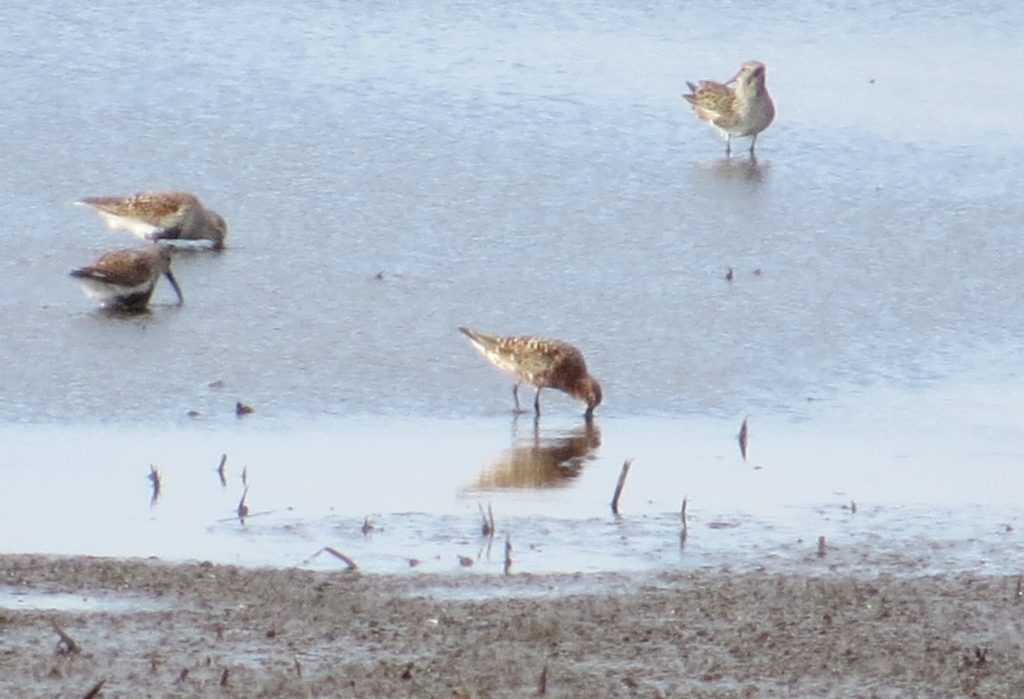
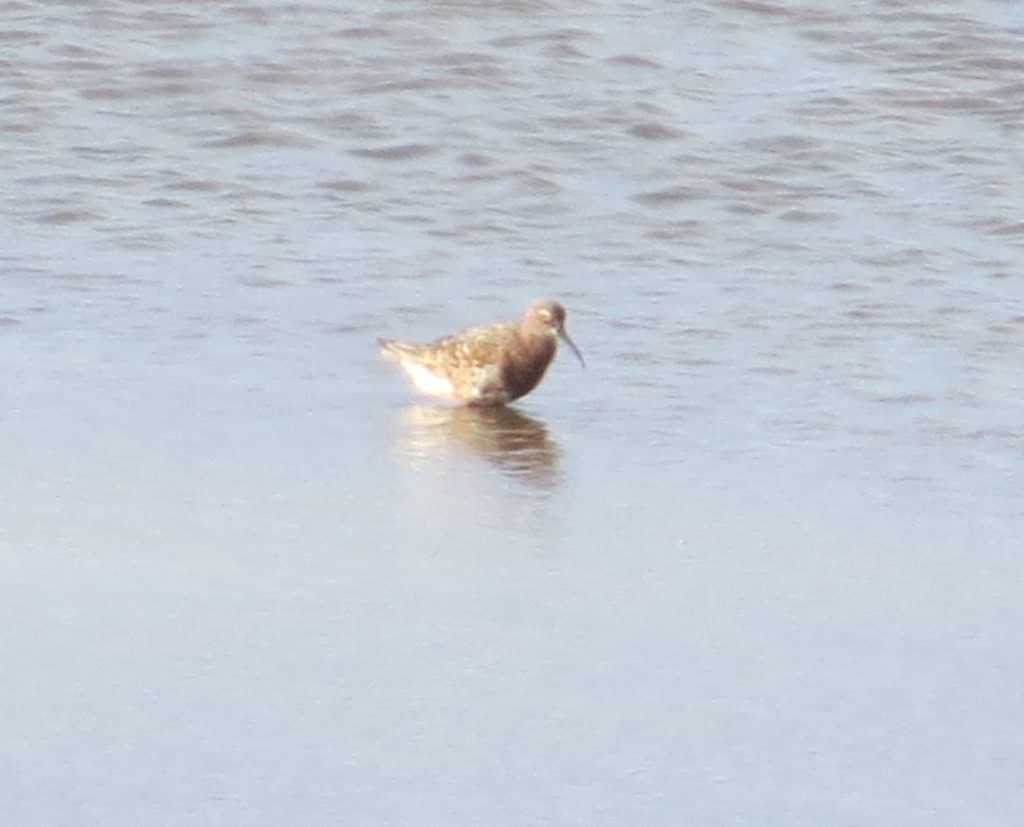 This story gets a little more interesting than just a really rare bird. There is a county listing married couple in the state, Barb and Denny Martin, who travel the entire state amassing tics everywhere they go. They’ve been at this awhile and have a very impressive total of 399 and 400 MN birds. The discrepancy bird? Curlew Sandpiper. Needless to say, they came screaming in from the Twin Cities and got on site while we were there. I wasn’t paying attention when Barb was telling someone else the backstory on how the discrepancy came to be, but regardless, there can be peace in the Martin household now that everything is tied up at 400 apiece.
This story gets a little more interesting than just a really rare bird. There is a county listing married couple in the state, Barb and Denny Martin, who travel the entire state amassing tics everywhere they go. They’ve been at this awhile and have a very impressive total of 399 and 400 MN birds. The discrepancy bird? Curlew Sandpiper. Needless to say, they came screaming in from the Twin Cities and got on site while we were there. I wasn’t paying attention when Barb was telling someone else the backstory on how the discrepancy came to be, but regardless, there can be peace in the Martin household now that everything is tied up at 400 apiece.
But wait, there’s more. The intrigue doesn’t stop with the Martins. Back on December 1, 2017, Garrett posted about the potential of this shorebird spot, and birding legend, Bob Dunlap, prophesied this very moment:
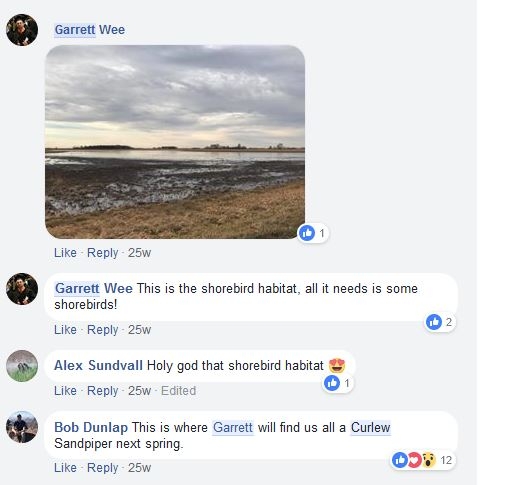
The fulfillment of the prophecy only served to heighten the lore of Bob and Garrett in the minds of us commoner birders. To stoke that sentiment even more, Garrett had another great find two days later with the discovery of 15 Smith’s Longspurs at the Echo sewage ponds, including several breeding plumage males. Even though this species passes through Minnesota (and likely Kandiyohi County) every year, I still have never seen one. Once again, Steve and I made an after work chase. This time we got a much later start and only had about 45 minutes of daylight to look. We turned up nothing when we walked the entirety of the small sewage ponds. Then, in a final last-ditch walk with barely any light, I detected the birds vocalizing in the corn stubble field adjacent to the ponds. Steve and I pursued them hoping to get visuals, but we were fighting low light and the bird’s good camouflage. Steve played a tape, and we had one sing in response. I did catch sight of one bird, seeing its buffy chest, but the look was fleeting and unsatisfying. Still, it was better than nothing.
On May 22, Steve and I were again on the chase when county-listing gurus, Andy Nyhus and Dedrick Benz, found 11 Whimbrels at the famed North Ottawa Impoundment in Grant County. North Ottawa put on a strong showing in 2017, coughing up rarity after rarity. One would think it would have nothing more to offer, but obviously the Whimbrel find proved that wrong. Steve and I almost didn’t complete the chase as we were in contact with another birder on site who wasn’t seeing them at the original location. Whimbrels are notorious for disappearing in a hurry, so I was skeptical. Steve thought we should complete the 1.5 hour trip there anyway. Once we got there, we ran into big year birder, Liz Harper, who came from the Cities hoping to add one more tic to her already 300+ year. None of us were optimistic. Steve and I decided we would just spend an hour birding the impoundment, which, even on a bad day, still beats birding most anywhere else. Liz decided she wasn’t giving up on the Whimbrels. Steve and I went on to find a Sanderling and some Avocets, leaving Liz behind. Then Liz called–she found them! Liz is, indeed, persistent. I mean, would you think to look at a pile of Mallards a half mile away in windy conditions? Because that’s where she found the Whimbrels were hiding.
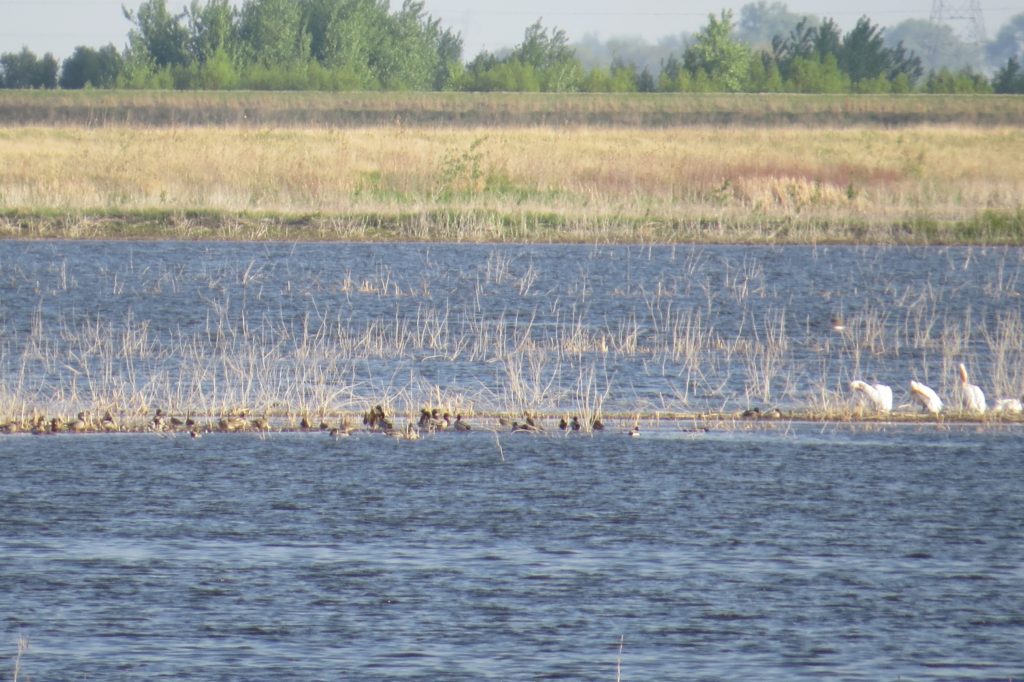 The views through the scopes shaking in the wind were tenuous but definitive enough to know what we were looking at. Liz was, appropriately, super pumped by resurrecting these birds and saving the day for all of us. Also, appropriately, she insisted we selfie with her to commemorate this great birding memory. Thanks, Liz, for digging this one out and changing the day’s narrative!
The views through the scopes shaking in the wind were tenuous but definitive enough to know what we were looking at. Liz was, appropriately, super pumped by resurrecting these birds and saving the day for all of us. Also, appropriately, she insisted we selfie with her to commemorate this great birding memory. Thanks, Liz, for digging this one out and changing the day’s narrative!
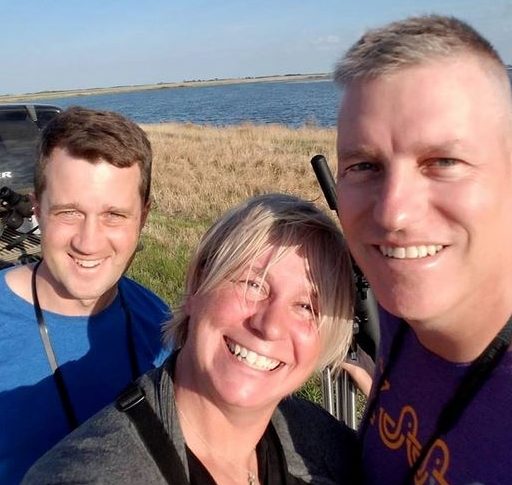 I was itching for a better look at these Whimbrels, so Steve and I headed to the road that bordered the basin on the east. Finally I got the look I was hoping for–seeing that tell-tale bill. It left me wanting more, but it was enough for now. Maybe someday I’d do better…
I was itching for a better look at these Whimbrels, so Steve and I headed to the road that bordered the basin on the east. Finally I got the look I was hoping for–seeing that tell-tale bill. It left me wanting more, but it was enough for now. Maybe someday I’d do better…
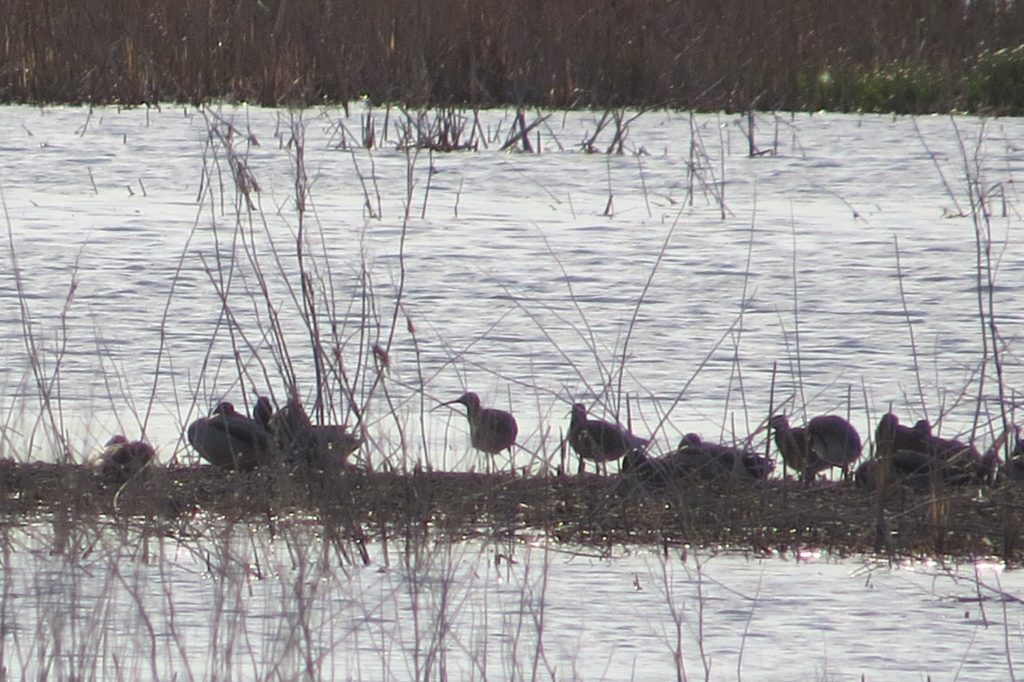 This brings us to this Memorial Day weekend where the family and I made a quick overnight trip to Duluth. Red-throated Loon is annual in Minnesota in both the late fall and spring on Lake Superior during migration. For whatever reason, I still haven’t made this bird a priority. Five years into my birding career, and I still hadn’t seen one. I decided to change that by going on this trip. RTLOs had been reported in good numbers off Park Point in Duluth the past few weeks. Memorial Day is one of the best times to look for them. We didn’t waste any time in Duluth, hitting the 12th St. beach access on Park Point immediately upon arriving in town. As the family played on the sandy beach and enjoyed the brisk 55-degree weather (mid 90s back home!), I scanned for this holdout to my life list. Nothing at 12 St., so we continued a few miles east down the Point to the beach house. There was a lot of chop and sun glare, but I eventually latched onto a trio of these constantly diving Loons. Seeing these Loons, in breeding plumage no less, felt good even if the photo leaves a lot to be desired.
This brings us to this Memorial Day weekend where the family and I made a quick overnight trip to Duluth. Red-throated Loon is annual in Minnesota in both the late fall and spring on Lake Superior during migration. For whatever reason, I still haven’t made this bird a priority. Five years into my birding career, and I still hadn’t seen one. I decided to change that by going on this trip. RTLOs had been reported in good numbers off Park Point in Duluth the past few weeks. Memorial Day is one of the best times to look for them. We didn’t waste any time in Duluth, hitting the 12th St. beach access on Park Point immediately upon arriving in town. As the family played on the sandy beach and enjoyed the brisk 55-degree weather (mid 90s back home!), I scanned for this holdout to my life list. Nothing at 12 St., so we continued a few miles east down the Point to the beach house. There was a lot of chop and sun glare, but I eventually latched onto a trio of these constantly diving Loons. Seeing these Loons, in breeding plumage no less, felt good even if the photo leaves a lot to be desired.
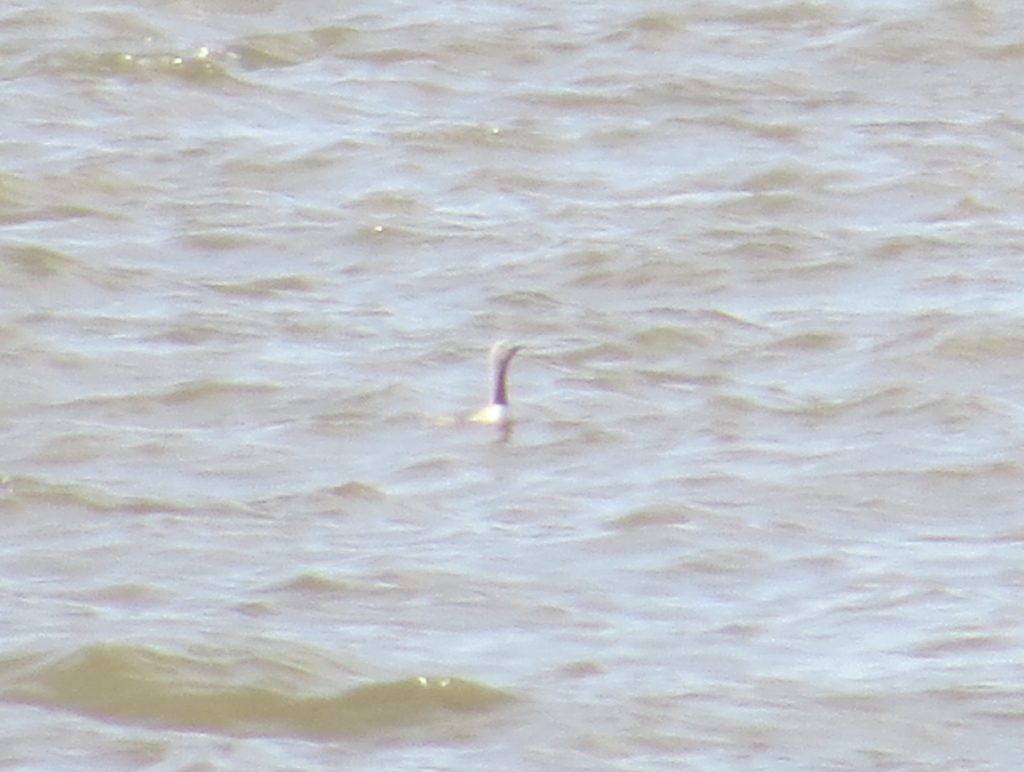 Since the main target of the trip was achieved, there was nothing left to do but have a relaxing time with the family. Of course, I’d be up and at ’em the next morning well before the family was awake. I decided to try for more/better visuals of the Loons. I had no luck with that this morning. What I lacked in the Loon-finding skills, I made up for in finding Duluth birding pal, John Richardson. It’s always good to see John. Not only is he a fun guy, but he is one skilled birder. He didn’t find a Red-throated Loon either. Instead, he found something just as good or even better:
Since the main target of the trip was achieved, there was nothing left to do but have a relaxing time with the family. Of course, I’d be up and at ’em the next morning well before the family was awake. I decided to try for more/better visuals of the Loons. I had no luck with that this morning. What I lacked in the Loon-finding skills, I made up for in finding Duluth birding pal, John Richardson. It’s always good to see John. Not only is he a fun guy, but he is one skilled birder. He didn’t find a Red-throated Loon either. Instead, he found something just as good or even better:
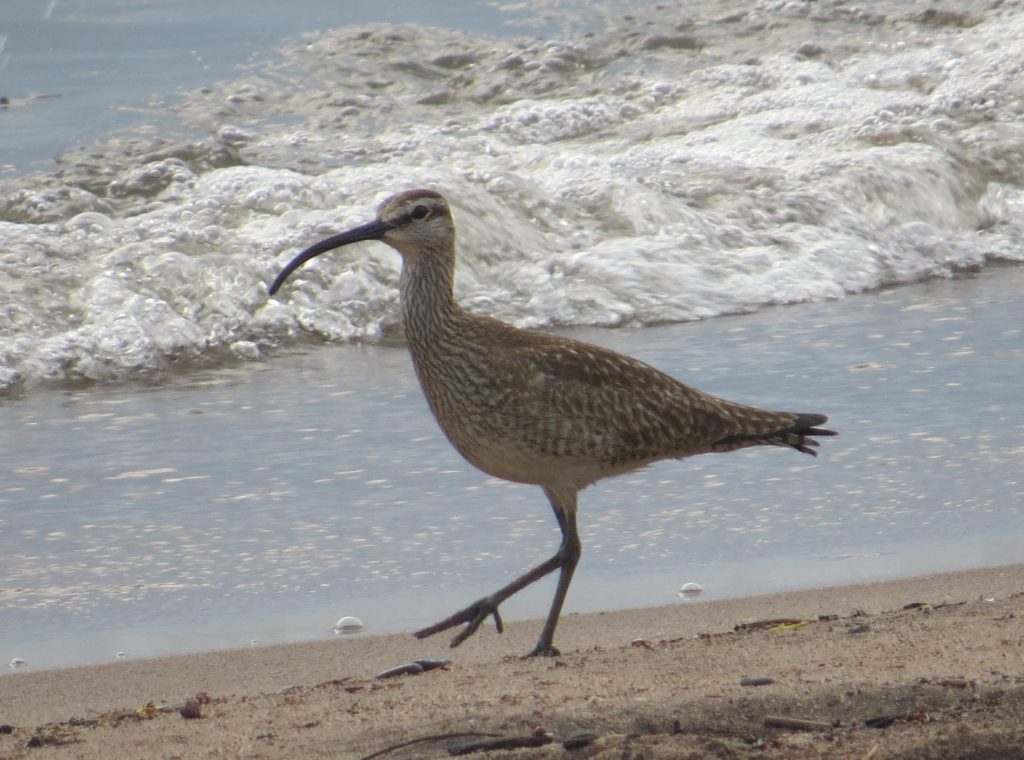
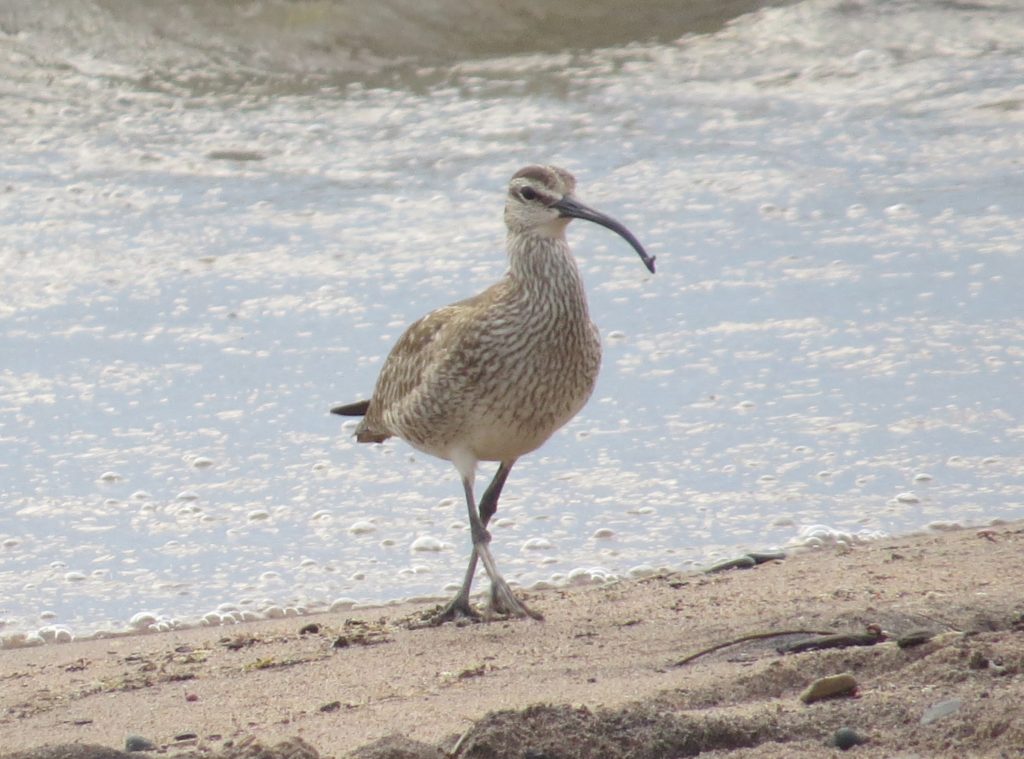 John and I spent the better part of an hour trying to relocate this single Whimbrel John had first found near the dune bridge at Park Point. It was time and effort well spent. Such a great-looking shorebird! Truly, not many other shorebirds excite birders as much as this one. It was as equal of a highlight as the RTLO, which I am now expecting to get crushing looks of any day at this rate.
John and I spent the better part of an hour trying to relocate this single Whimbrel John had first found near the dune bridge at Park Point. It was time and effort well spent. Such a great-looking shorebird! Truly, not many other shorebirds excite birders as much as this one. It was as equal of a highlight as the RTLO, which I am now expecting to get crushing looks of any day at this rate.
I’m putting off the other major trip reports again. Next post will be about the local birding scene. It’s been off the charts.

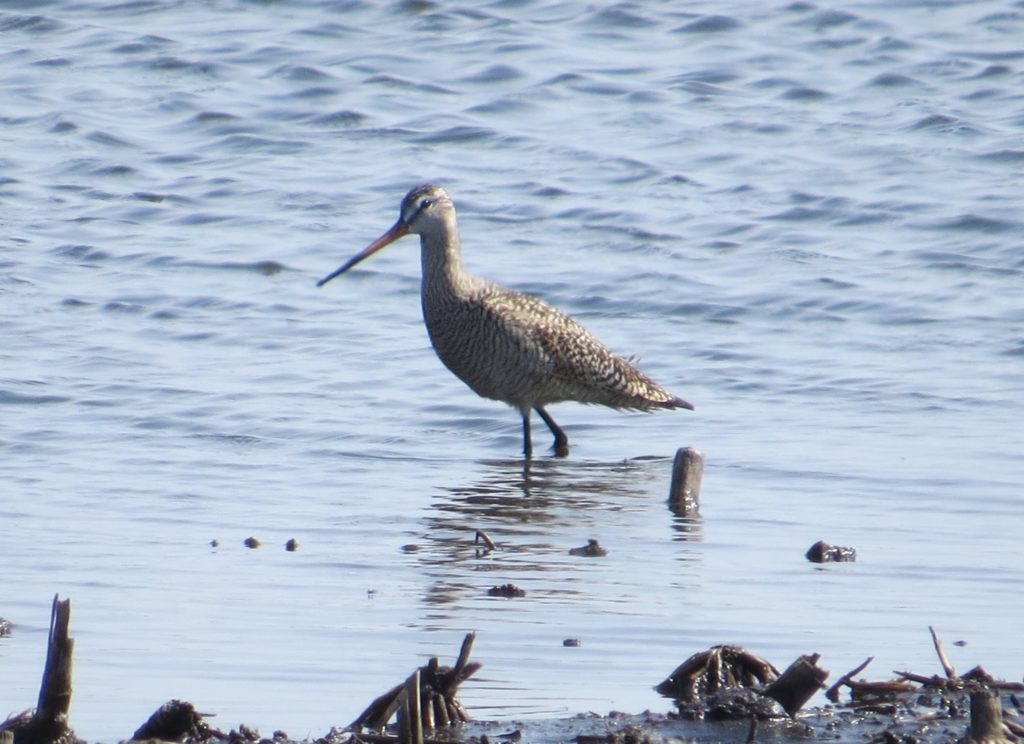
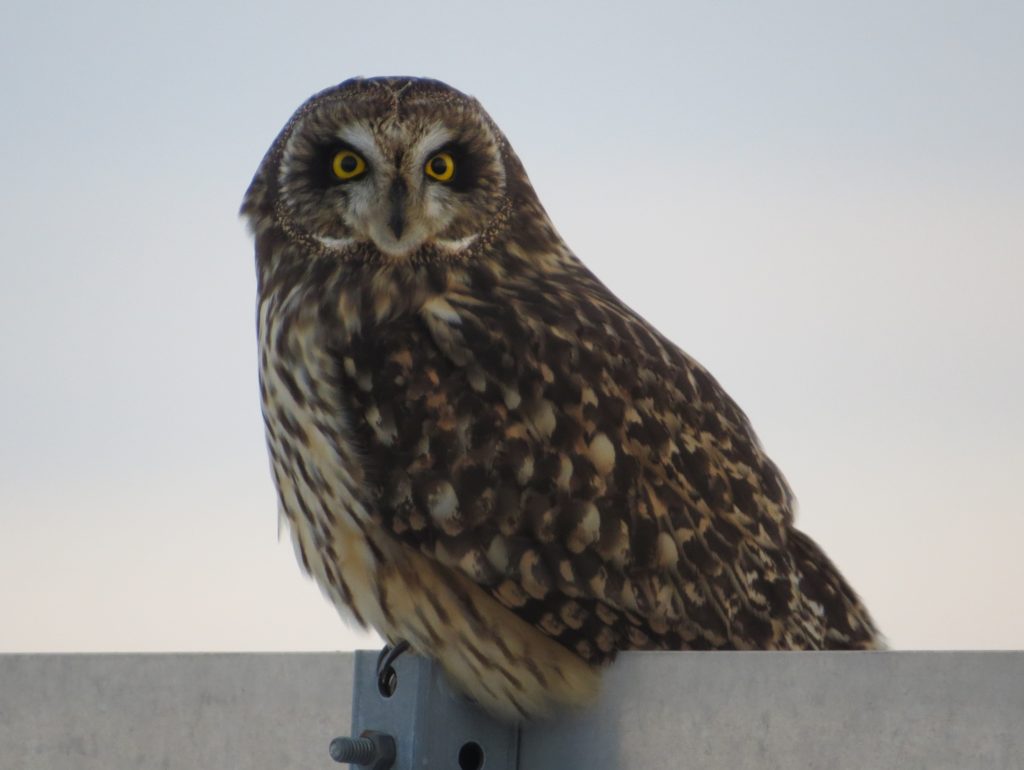
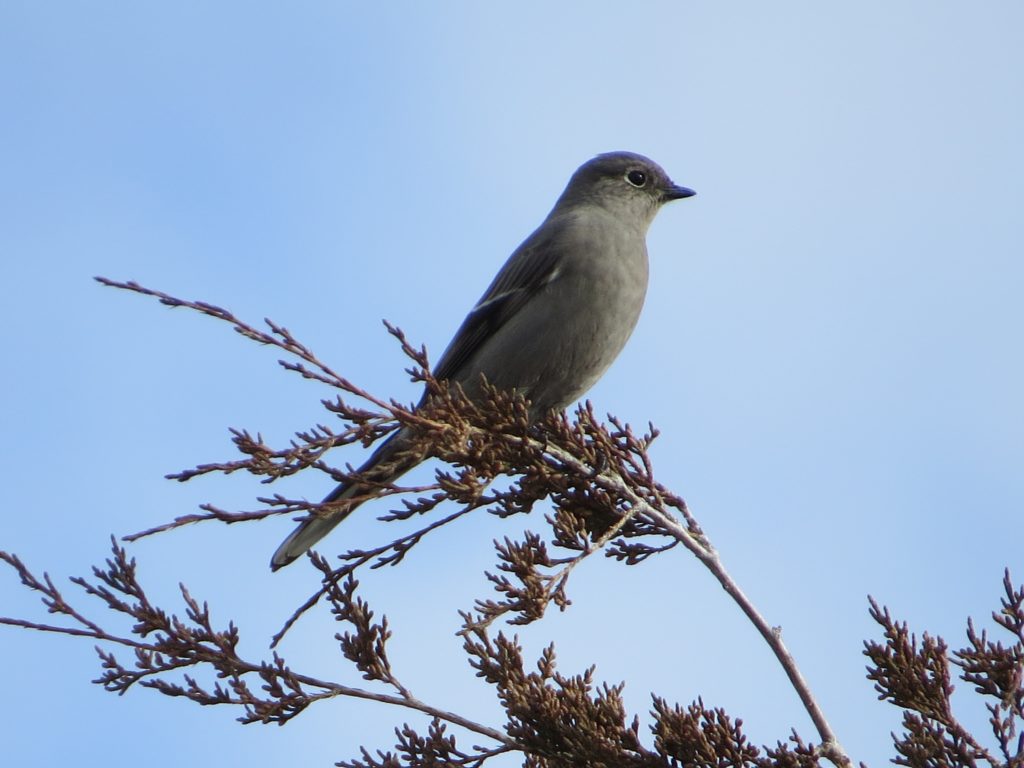
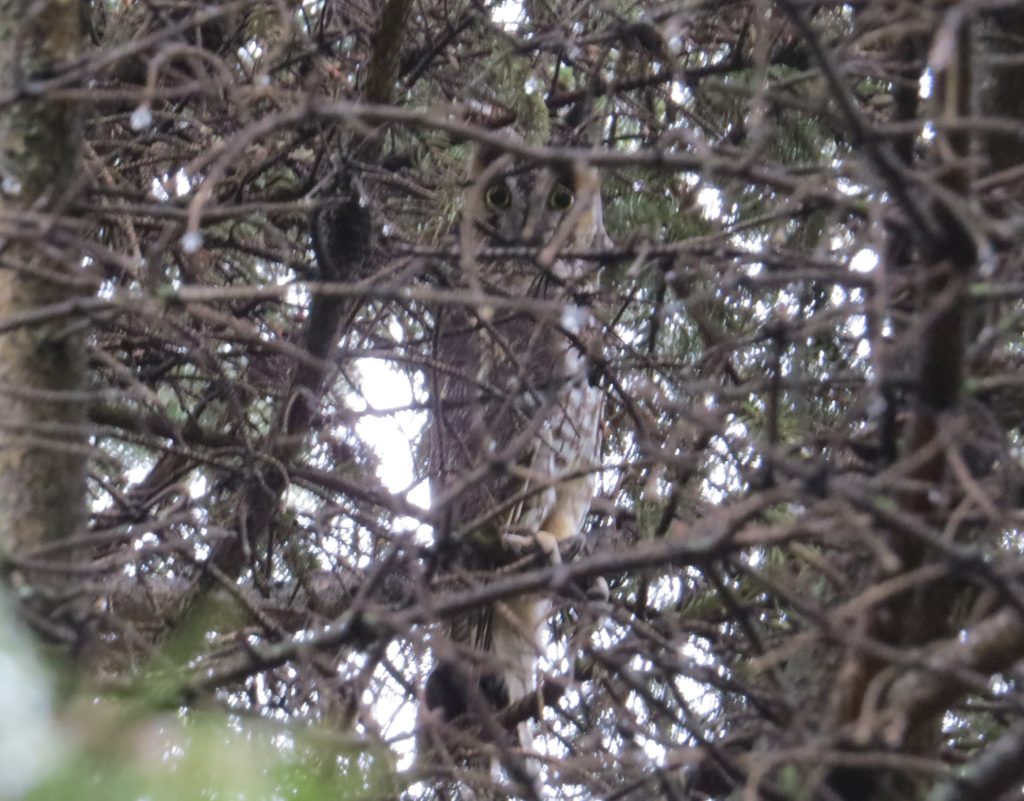
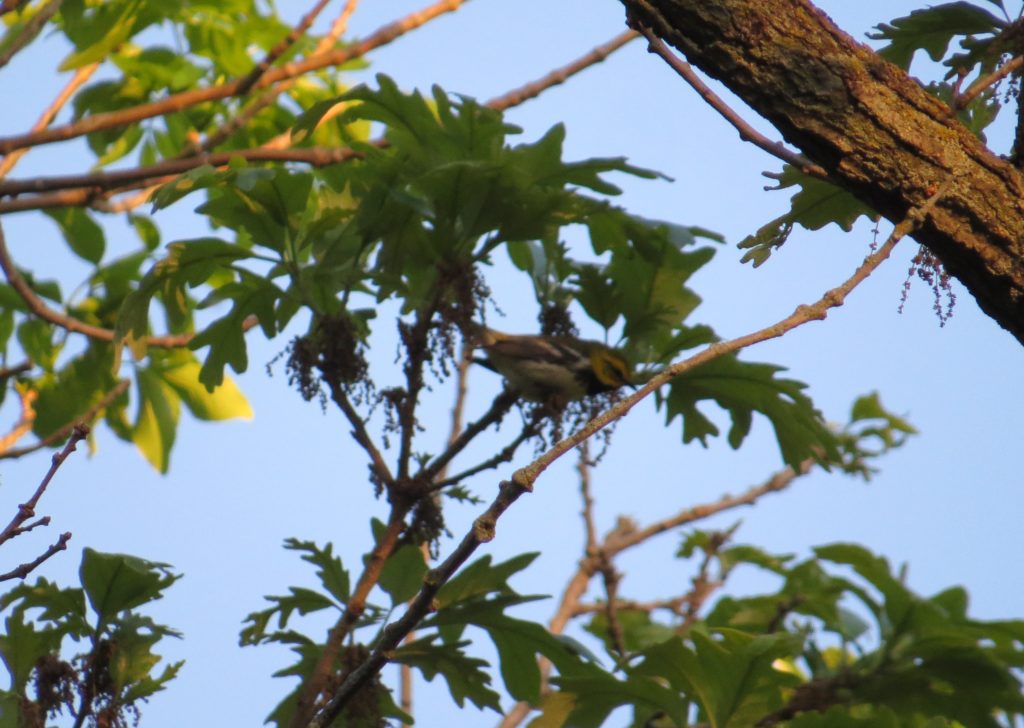
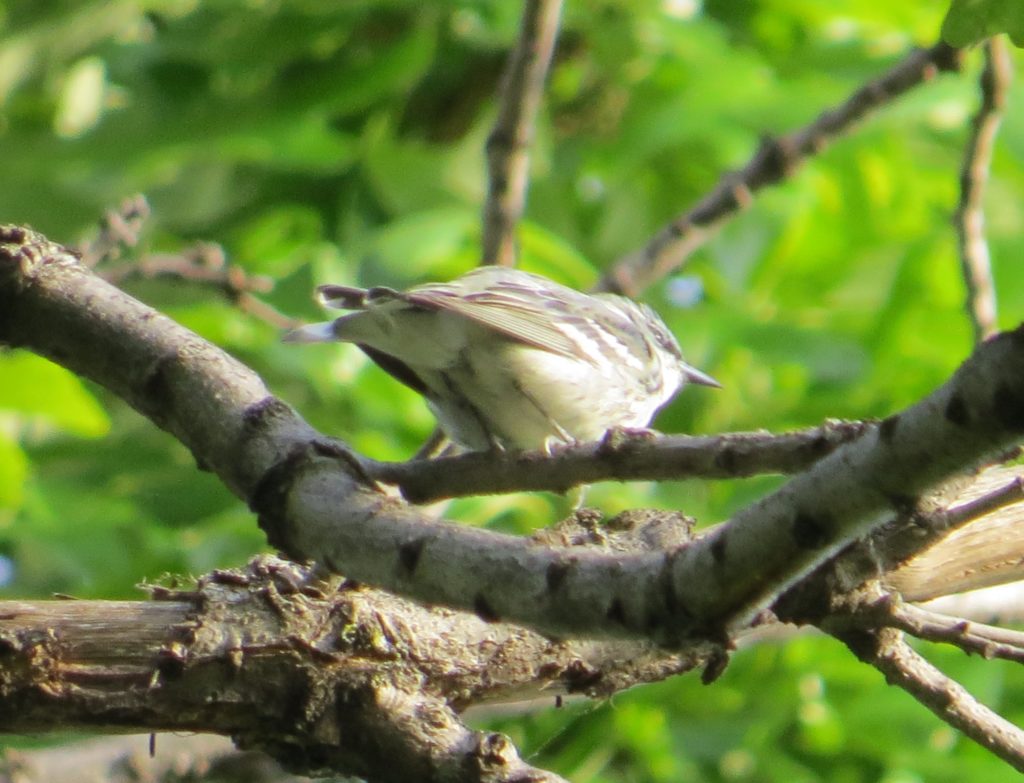
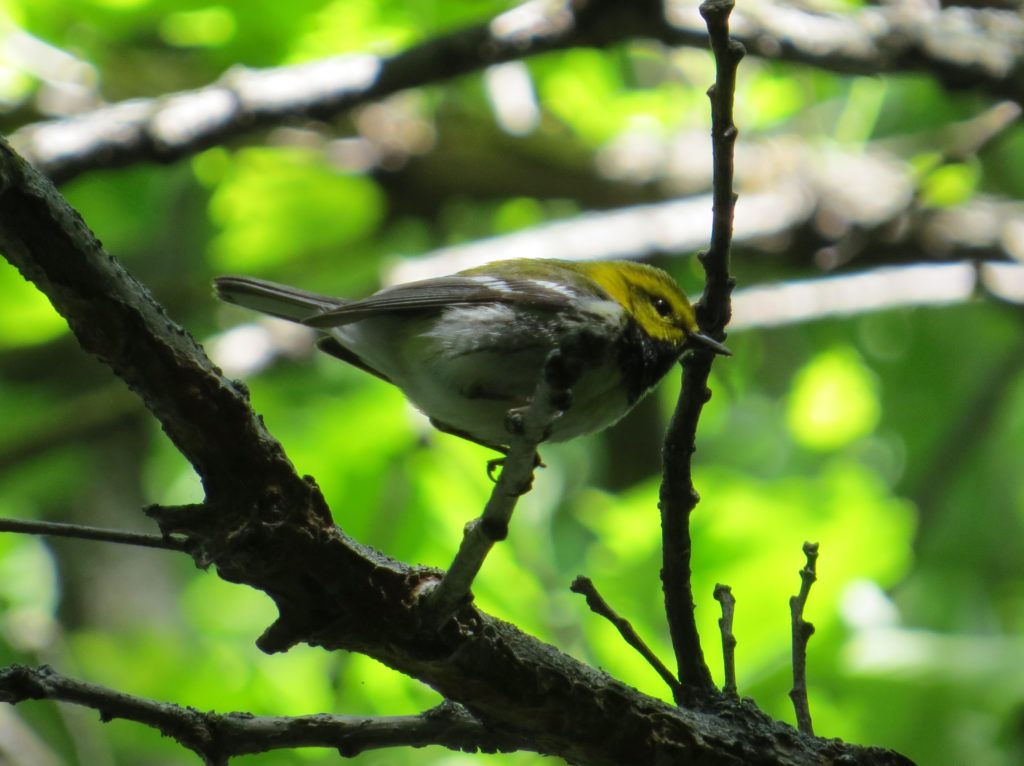
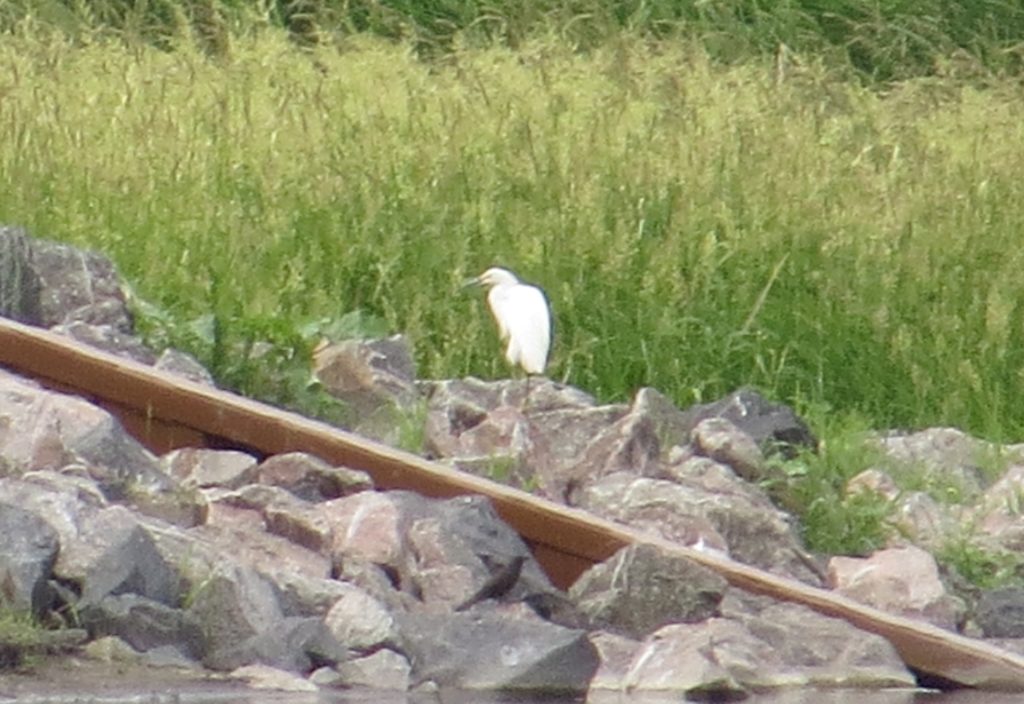 An Egret vs. Egret pic is always a nice assurance for an ID of such an important bird.
An Egret vs. Egret pic is always a nice assurance for an ID of such an important bird.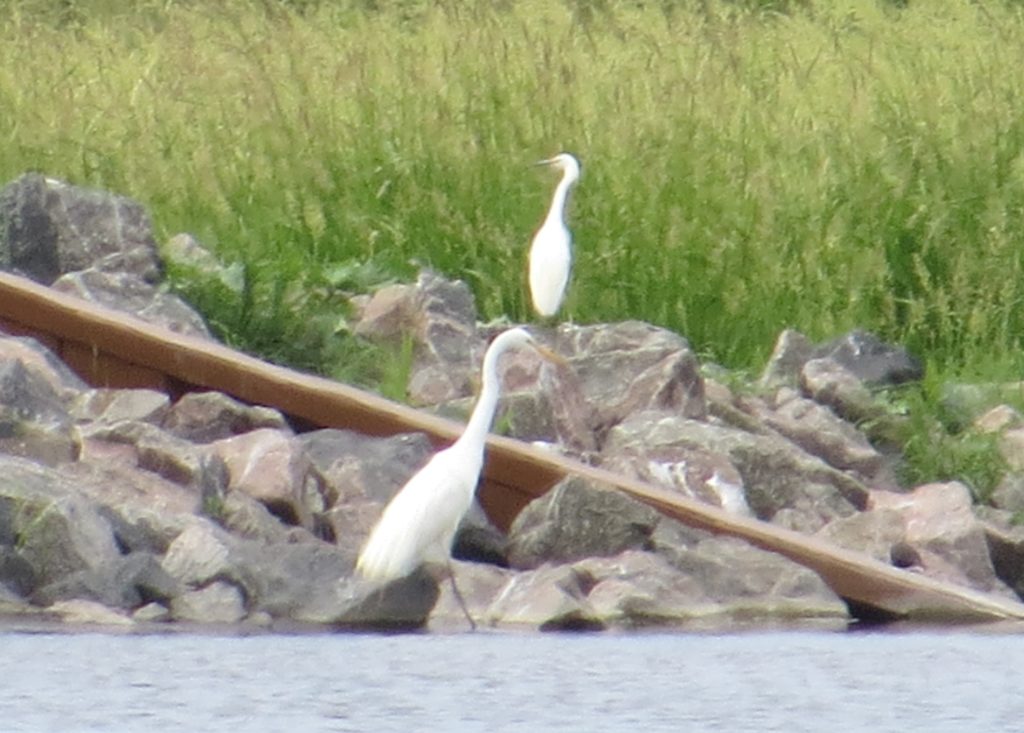 I was now tied with Bob. Wow. Some people get excited over reaching round-number milestones, like this 250, but not me. I wanted a crooked number. I wanted that #251 in the worst way. While my motivation in the beginning was to pass Bob’s number, my motivation was now about me meeting what I once thought was an unattainable goal. More than anything I wanted to do what my mind had declared an impossibility or at least a far-fetched possibility way back in December. I wanted that 7th bird in the worst way, more than a lifer even. And it was only June. I had averaged one new county bird for each month in 2017, and I still had 6 months left to get just one new county bird.
I was now tied with Bob. Wow. Some people get excited over reaching round-number milestones, like this 250, but not me. I wanted a crooked number. I wanted that #251 in the worst way. While my motivation in the beginning was to pass Bob’s number, my motivation was now about me meeting what I once thought was an unattainable goal. More than anything I wanted to do what my mind had declared an impossibility or at least a far-fetched possibility way back in December. I wanted that 7th bird in the worst way, more than a lifer even. And it was only June. I had averaged one new county bird for each month in 2017, and I still had 6 months left to get just one new county bird.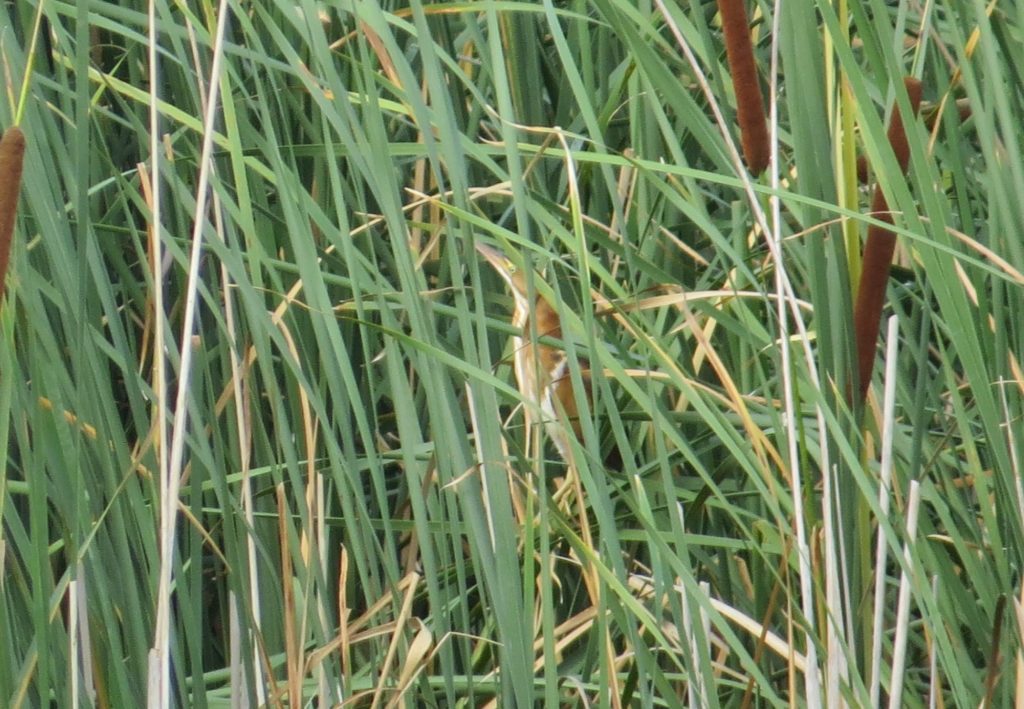
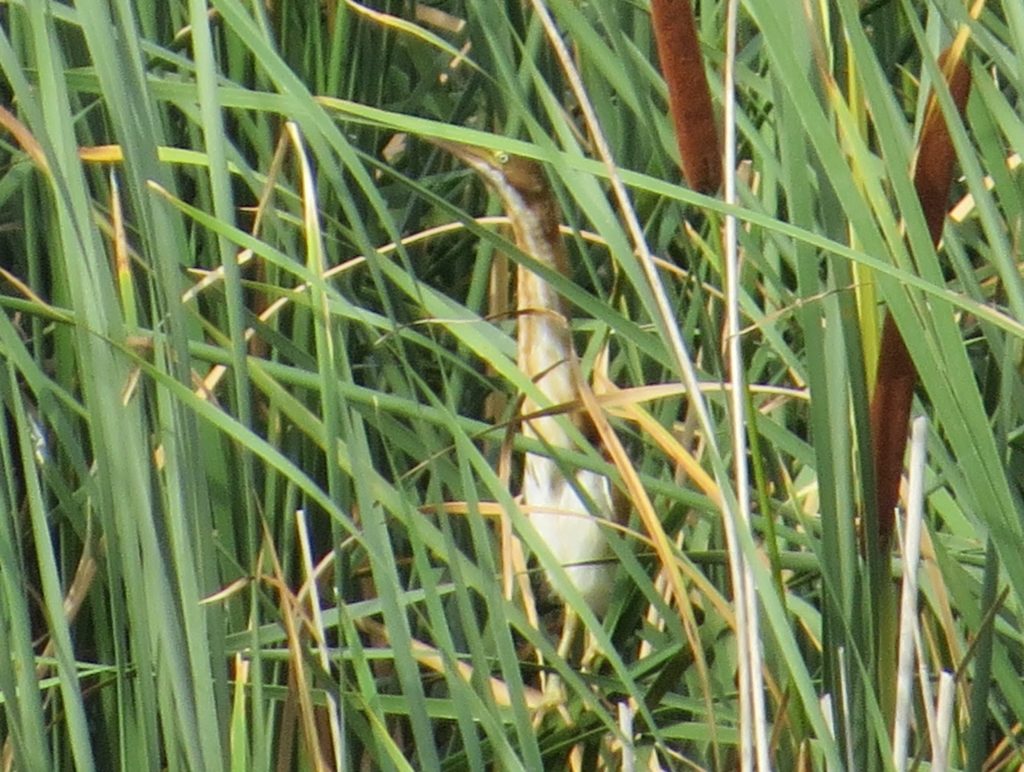 The Bittern was a fun find, but I wanted to see those Gallinules bad. I did hear one of the adults vocalize at one point, so it was officially notched. Since it was such a monumental bird, though, I really wanted to see it. Finally, patience paid off as I spotted one of the babies.
The Bittern was a fun find, but I wanted to see those Gallinules bad. I did hear one of the adults vocalize at one point, so it was officially notched. Since it was such a monumental bird, though, I really wanted to see it. Finally, patience paid off as I spotted one of the babies.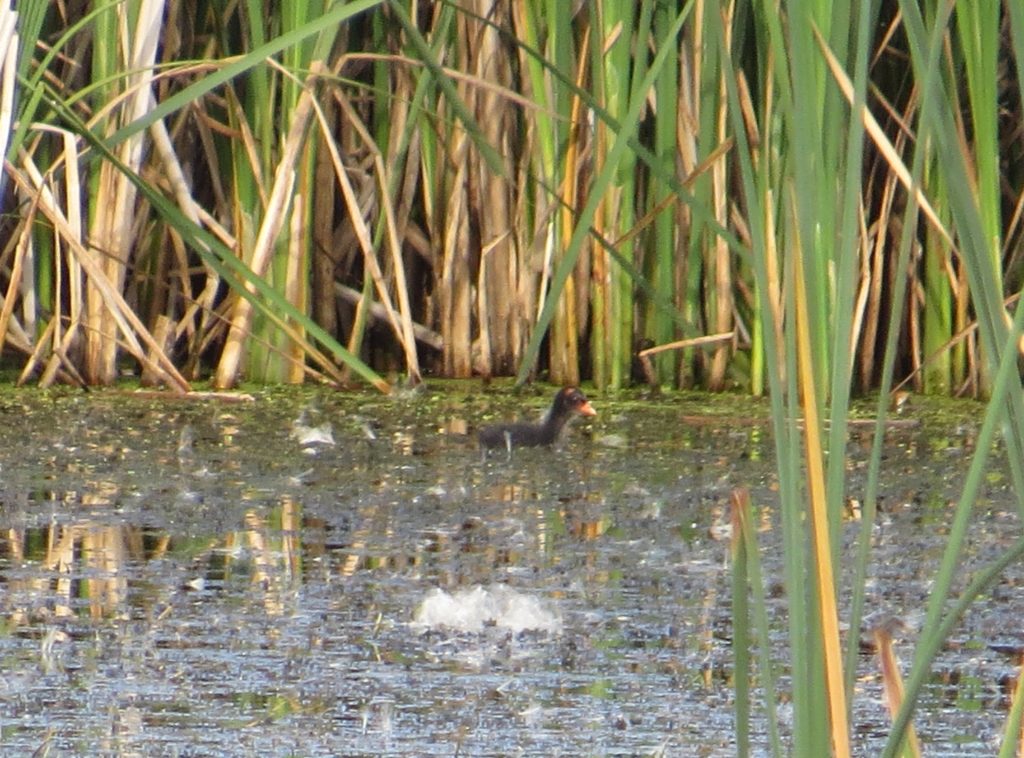 And then I saw two of the babies with one of the parents.
And then I saw two of the babies with one of the parents.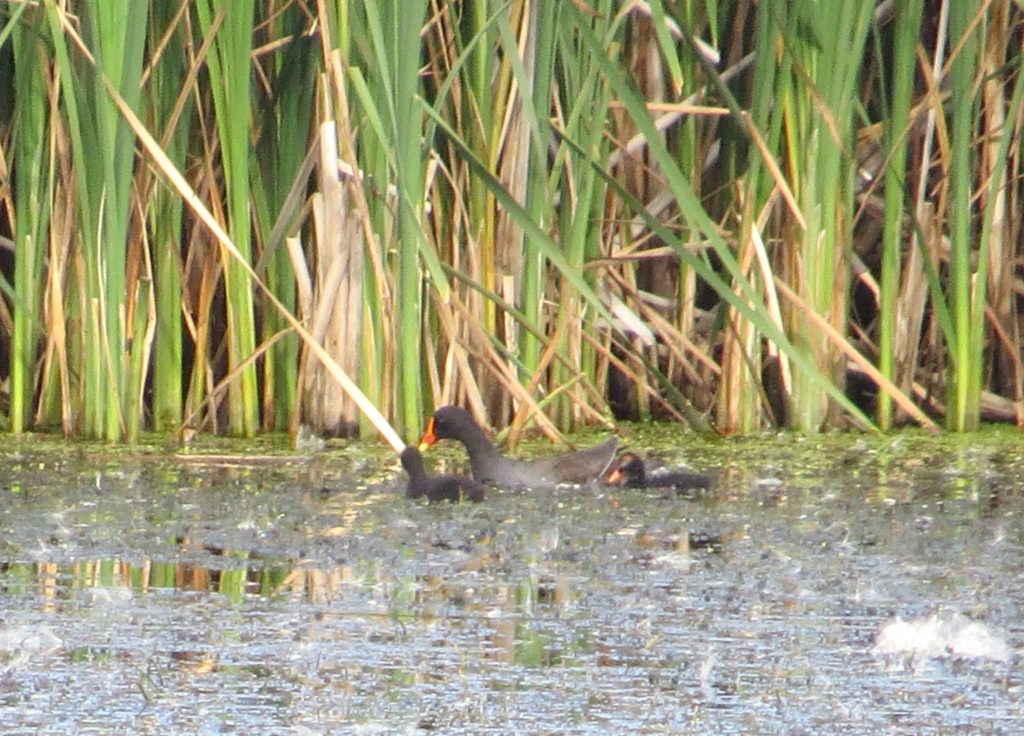 It was finished. I was ecstatic. The impossible had been achieved with a whopping 5 months left on the year. I had made it. Kathleen, if you’re reading, thank you very much for your great find!
It was finished. I was ecstatic. The impossible had been achieved with a whopping 5 months left on the year. I had made it. Kathleen, if you’re reading, thank you very much for your great find!
 Of course, no boys take this more seriously than the male Warblers of the island. With nearly twenty different species being present on the island, one cannot escape these singing sensations as they belt out their territorial songs telling rival males and the whole world that this is their house.
Of course, no boys take this more seriously than the male Warblers of the island. With nearly twenty different species being present on the island, one cannot escape these singing sensations as they belt out their territorial songs telling rival males and the whole world that this is their house.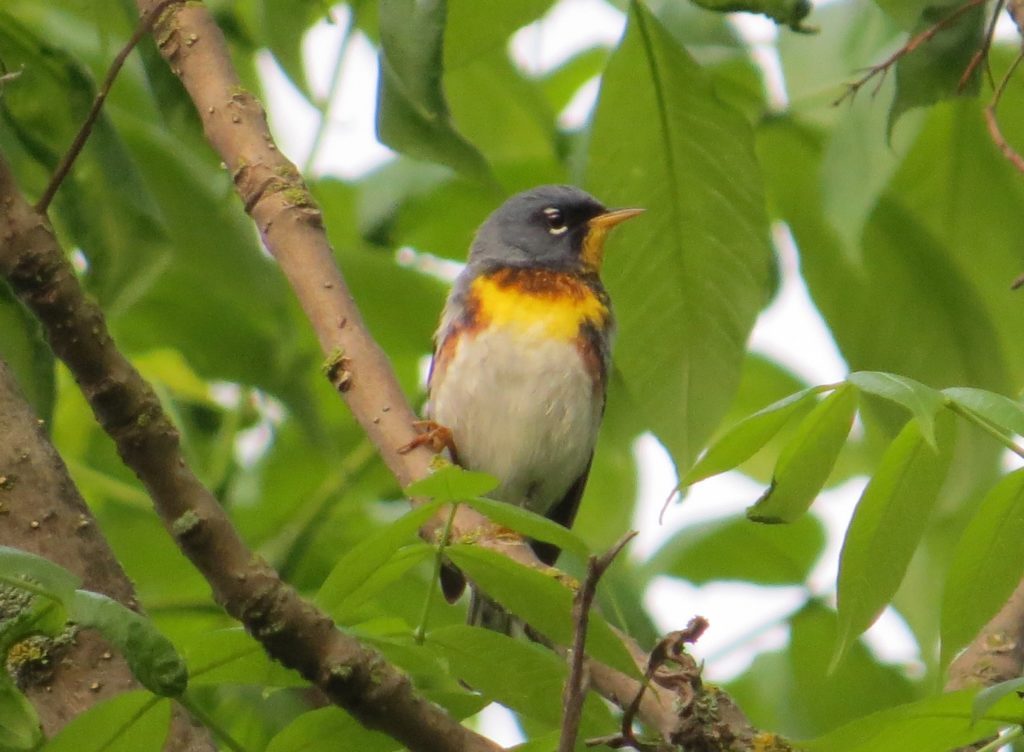
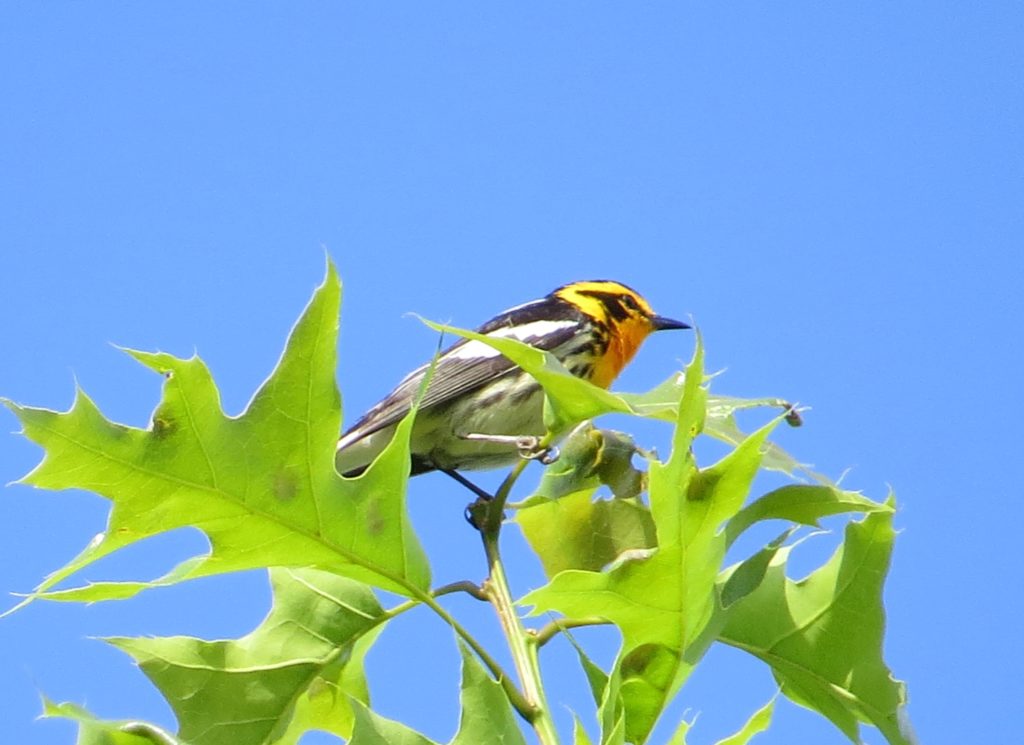 Photographing Warblers in their natural habitat is the best. Here this Blackburnian is posing where he is most comfortable–atop a Black Spruce in a decent-sized (and only) bog on the island.
Photographing Warblers in their natural habitat is the best. Here this Blackburnian is posing where he is most comfortable–atop a Black Spruce in a decent-sized (and only) bog on the island.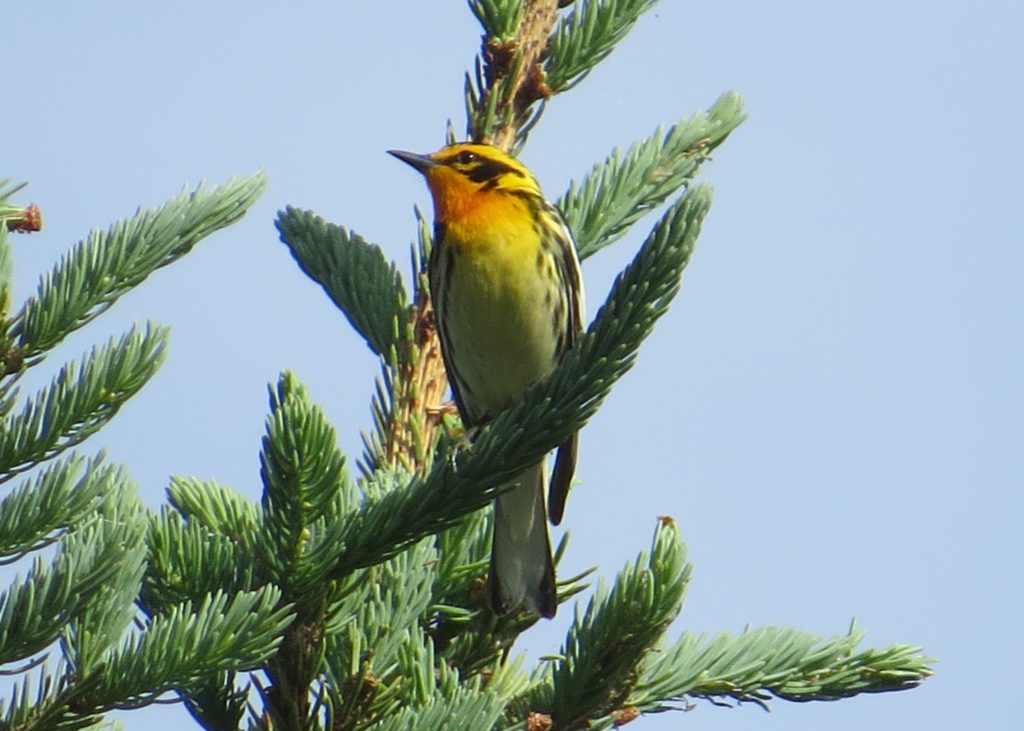
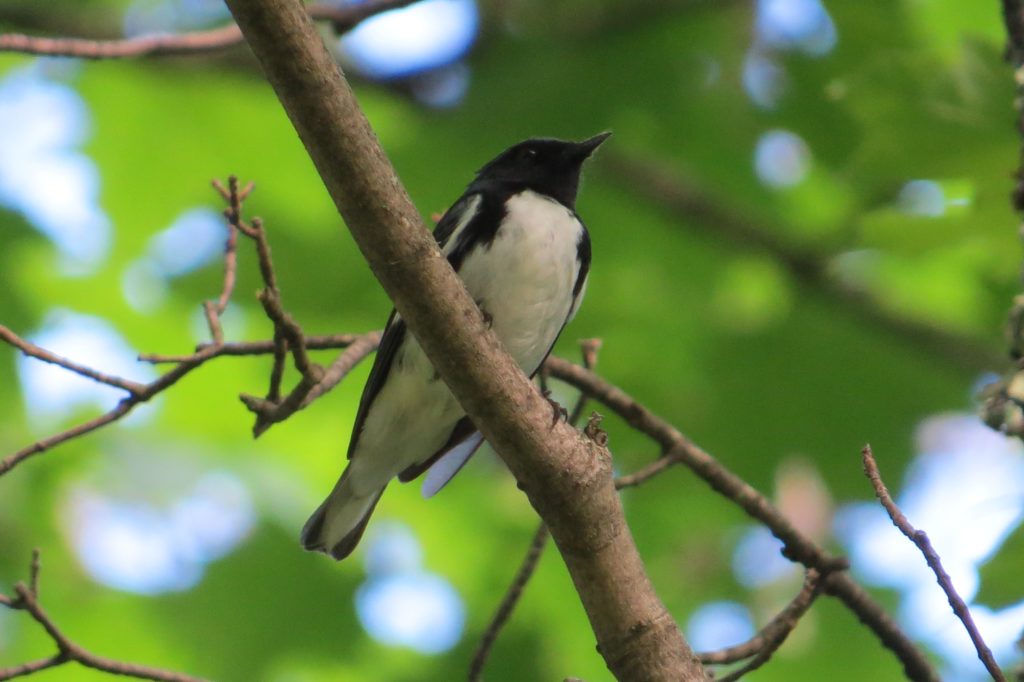
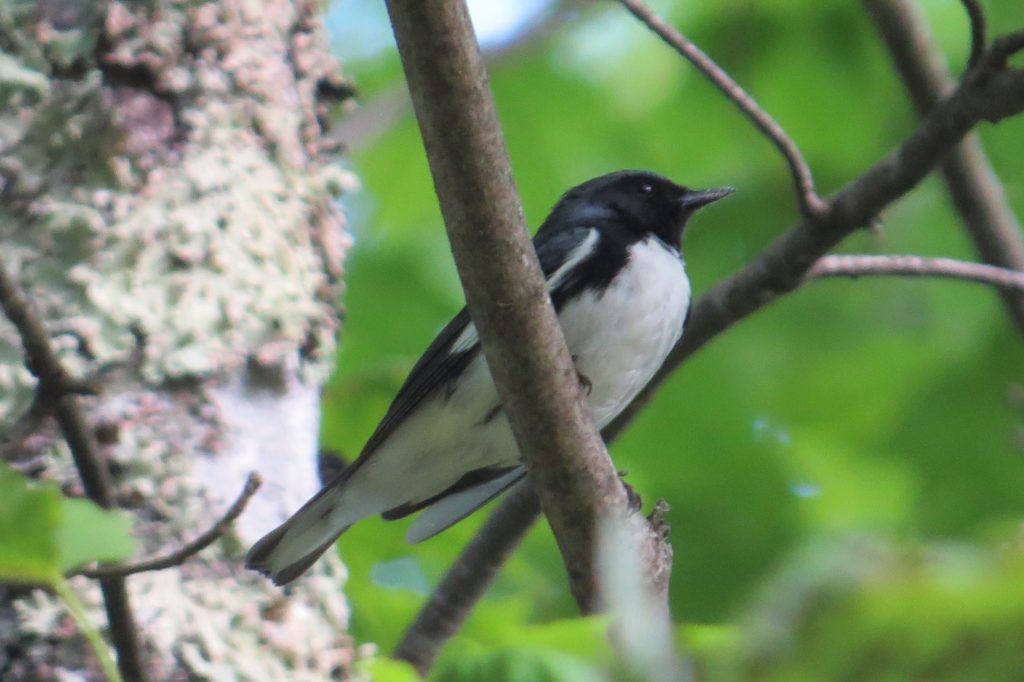
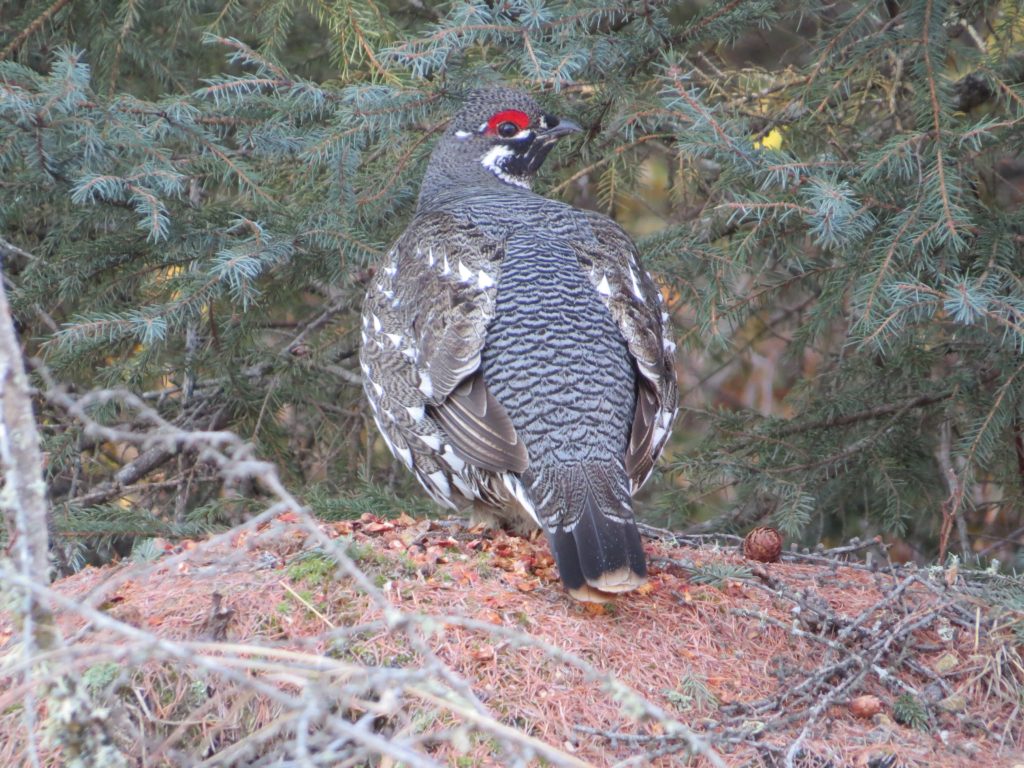
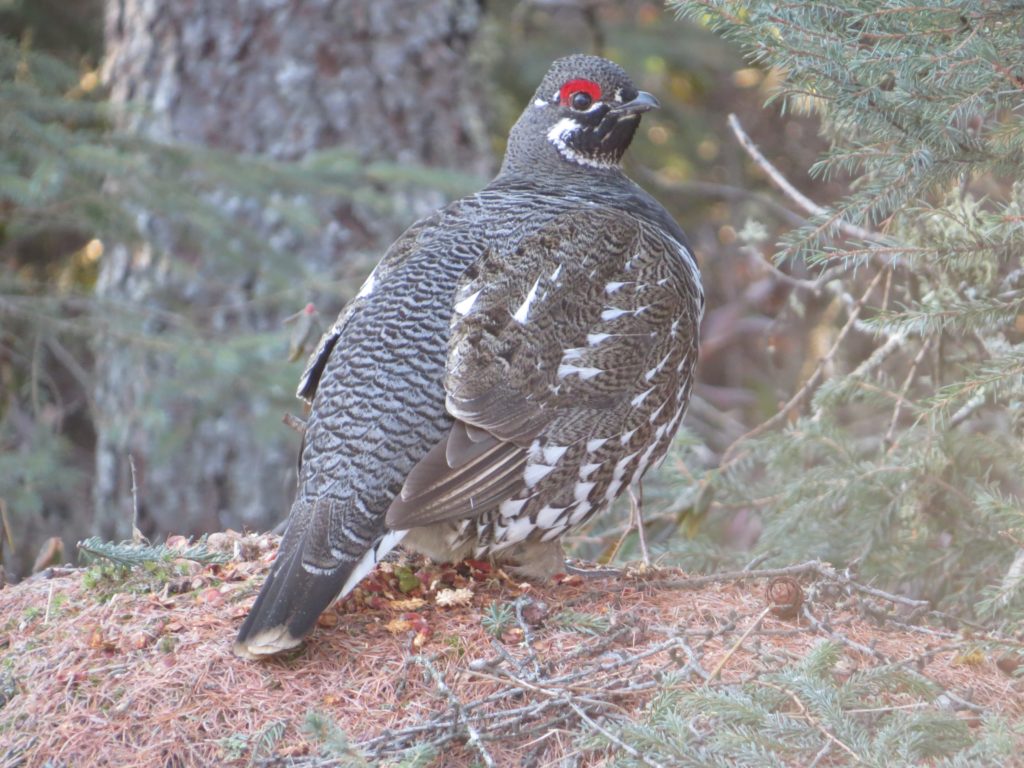
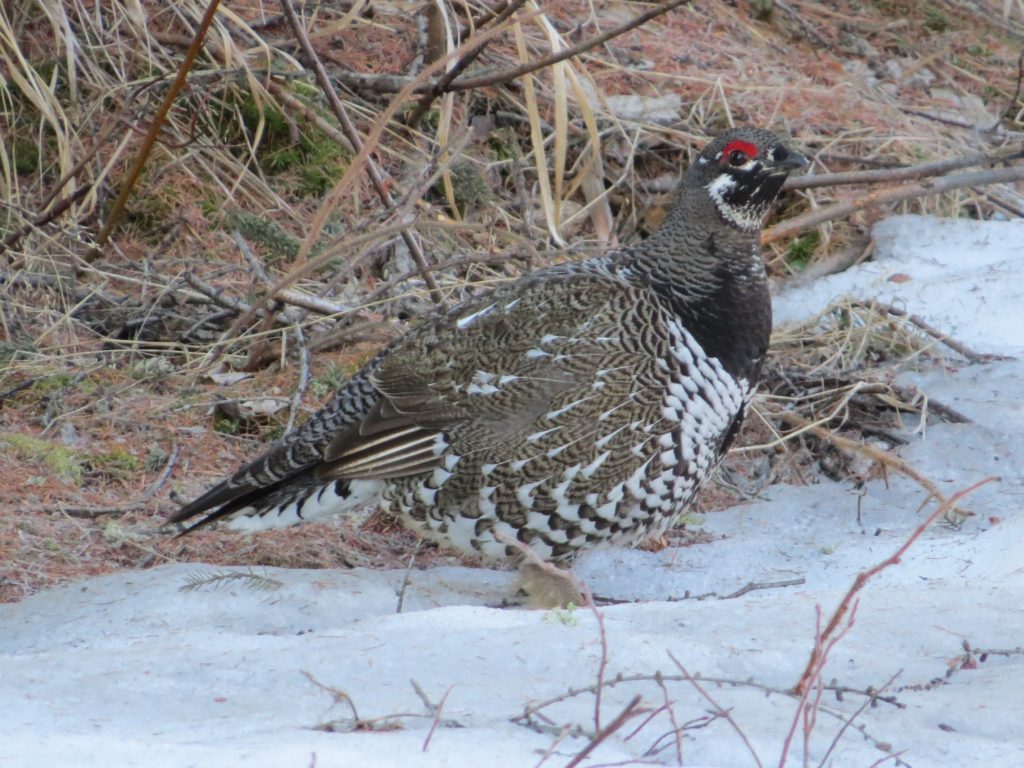 This male Spruce Grouse was the first bird my local birding friend Julie Grahn spied while we hunted for the life bird that Julie had found weeks earlier on this same road. I was thankful that this Grouse finally flew off so we could get back to the more important search at hand. But doggone it, an hour later I looked behind me and saw that another male had come out to the road.
This male Spruce Grouse was the first bird my local birding friend Julie Grahn spied while we hunted for the life bird that Julie had found weeks earlier on this same road. I was thankful that this Grouse finally flew off so we could get back to the more important search at hand. But doggone it, an hour later I looked behind me and saw that another male had come out to the road.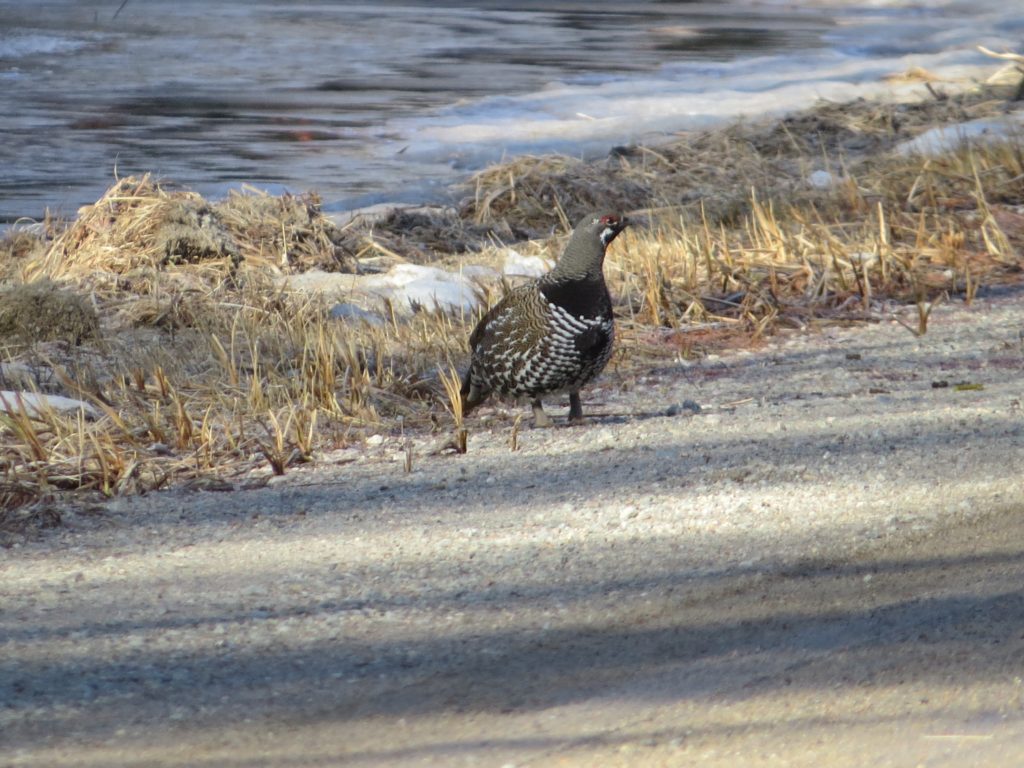 I had actually been looking behind me to see if another friend, John Richardson, was coming. This was good timing because John was hoping to see this bird too.
I had actually been looking behind me to see if another friend, John Richardson, was coming. This was good timing because John was hoping to see this bird too.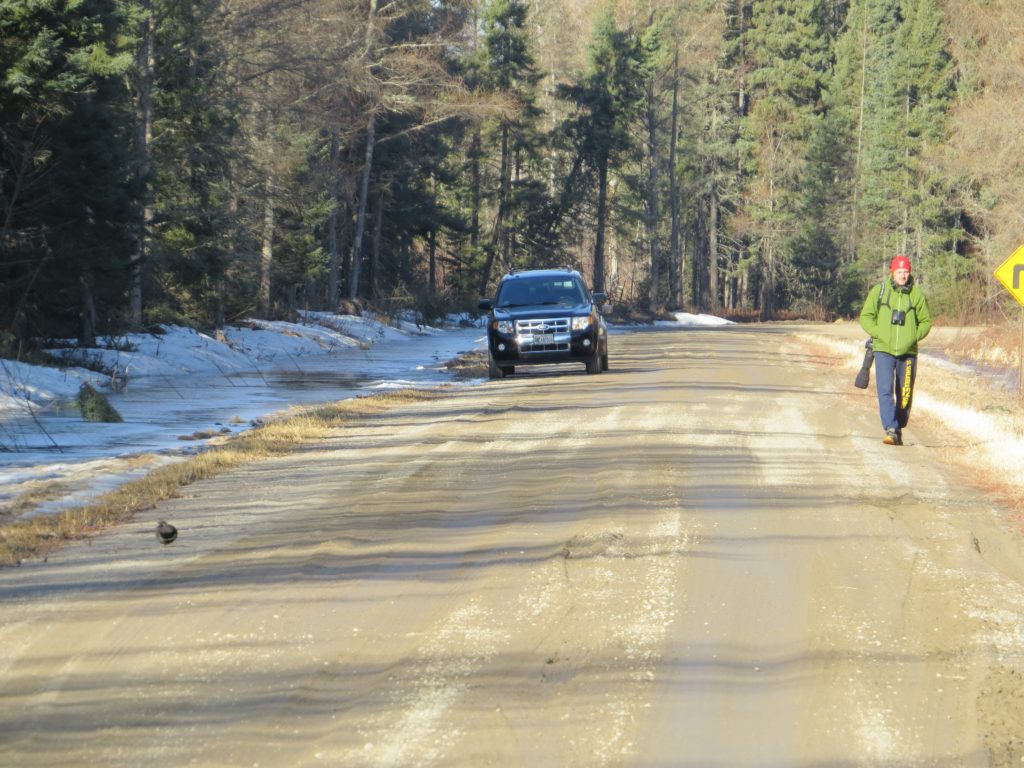
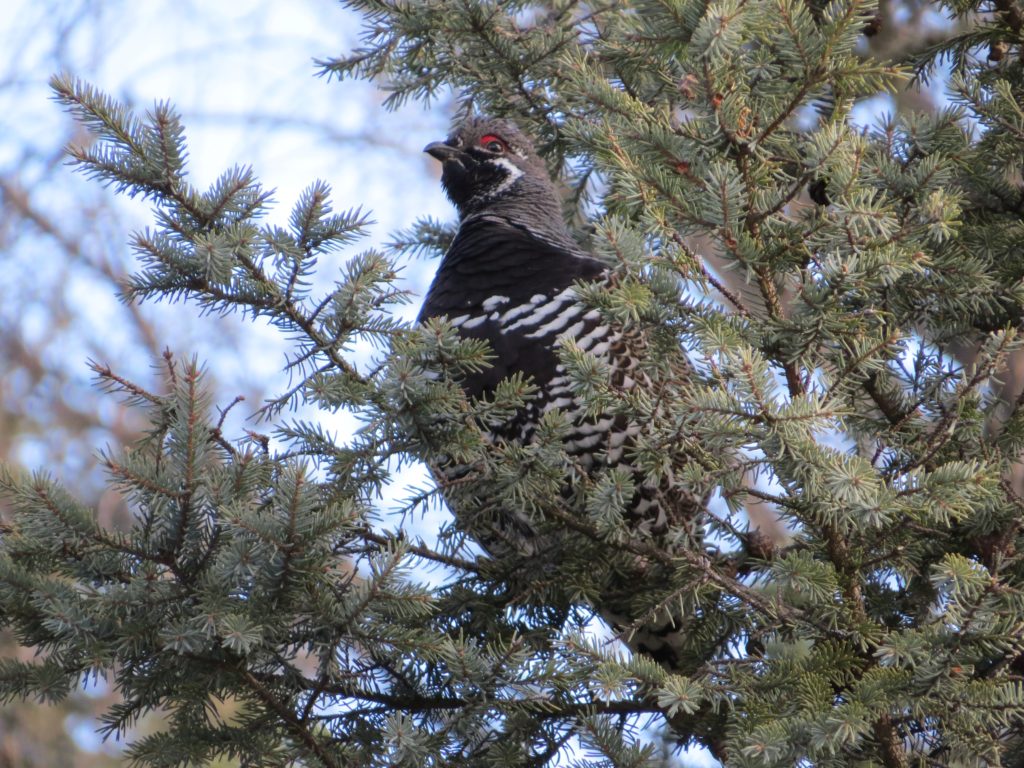
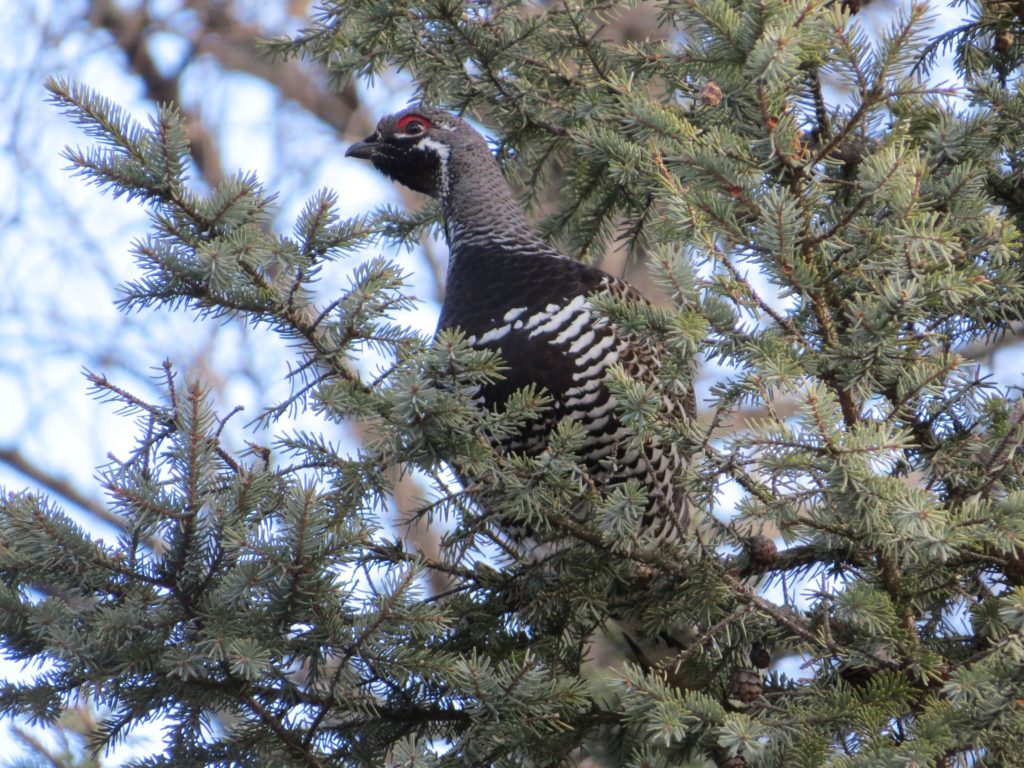 You want to know why so many people have trouble finding this bird?
You want to know why so many people have trouble finding this bird?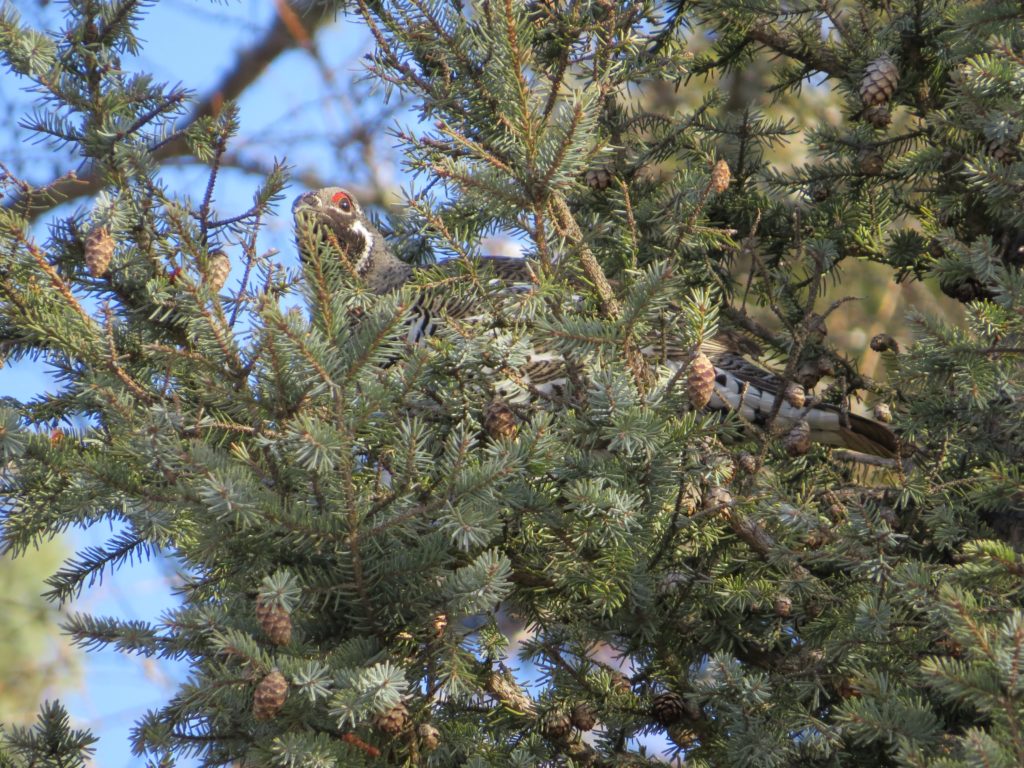 That is actually a fairly conspicuous shot. There were times that it was so well hidden, camouflaged, and motionless at the top of this small tree that we would not have known it was there had we not just been observing it. Only the slightest rustle of the boughs gave away its presence as it consumed the Black Spruce needles. We were treated to full monty looks as well and could just not pull ourselves away…
That is actually a fairly conspicuous shot. There were times that it was so well hidden, camouflaged, and motionless at the top of this small tree that we would not have known it was there had we not just been observing it. Only the slightest rustle of the boughs gave away its presence as it consumed the Black Spruce needles. We were treated to full monty looks as well and could just not pull ourselves away…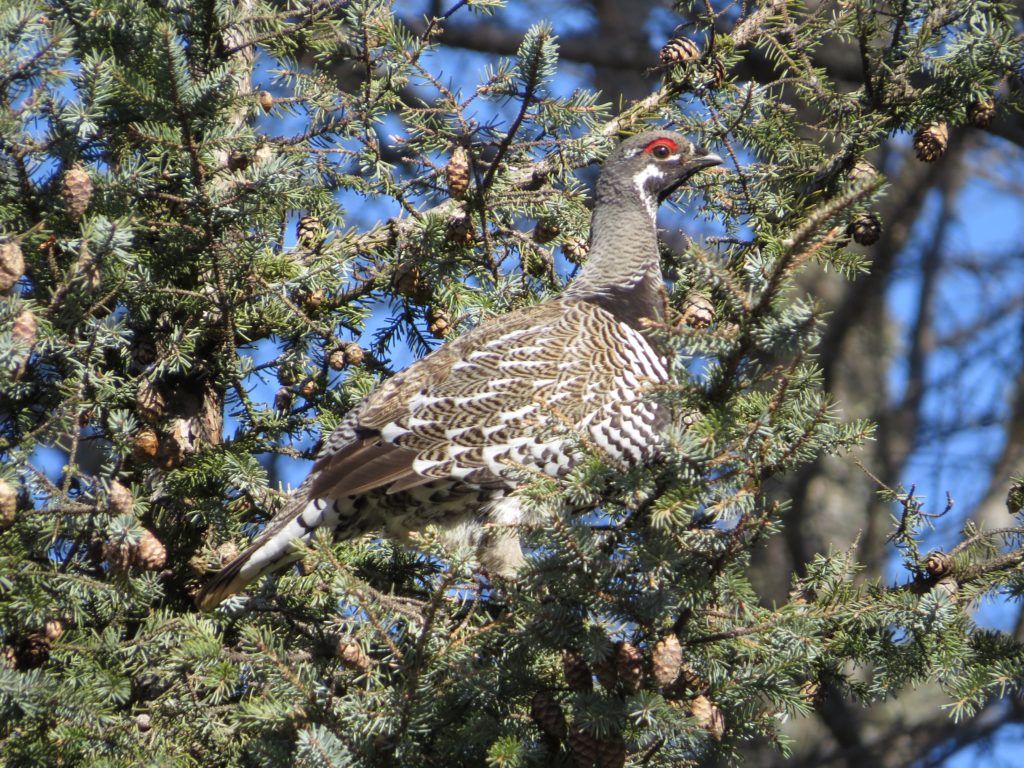
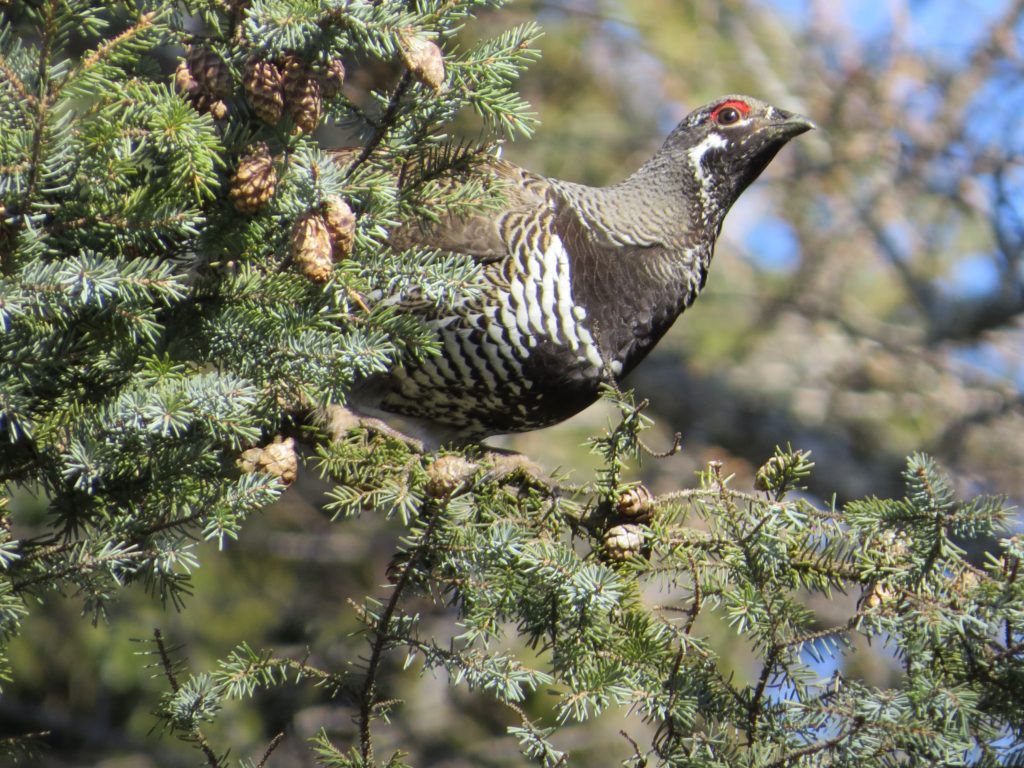
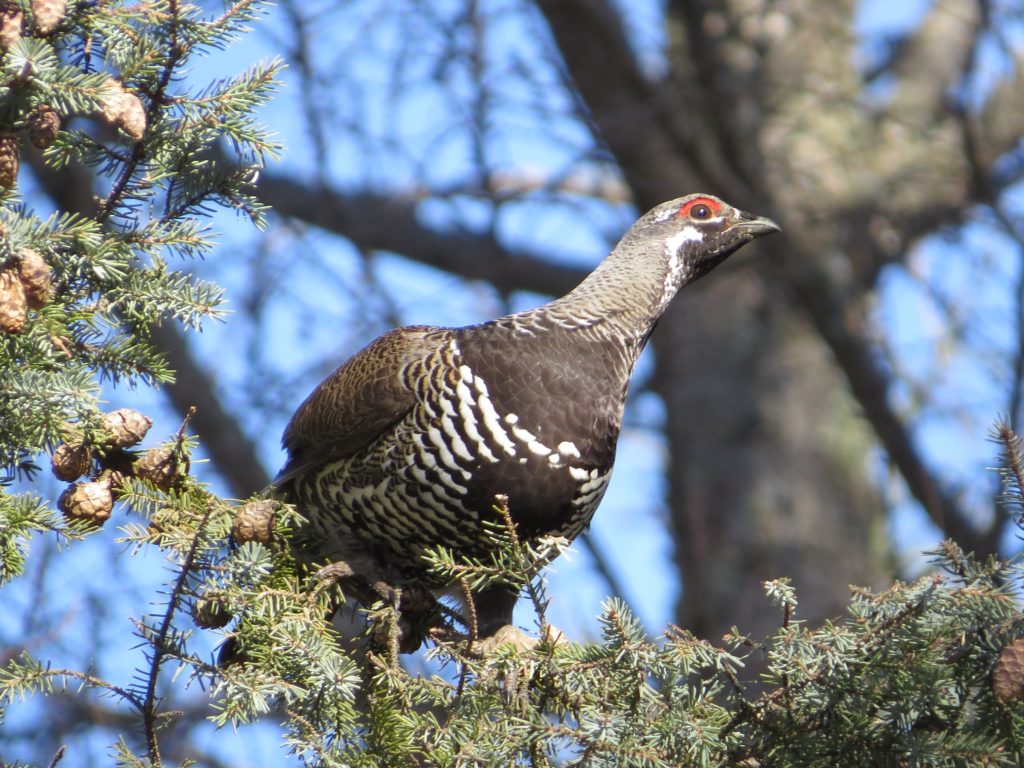 We finally managed to leave this incredibly accommodating bird and get back to our priority of lifer-searching. But one lifer and one day later, I was back on this road birding again just to see what I could see. Though I started the day alone, I bumped into fellow birders Sparky Stensaas, Dee Kuder, and Julie Grahn. At one point I was bushwhacking to join Sparky in the heart of the Spruce bog when the ground fluttered in front of me. Spruce Grouse–again! This was much later in the day than the sighting the previous day, and the bird was not gritting out on the road. I had stumbled upon it just relaxing in the dark recesses of the bog for the day. Known by locals as the Fool’s Hen, this Sprucie was not overly concerned about me and settled back down under his Spruce bough.
We finally managed to leave this incredibly accommodating bird and get back to our priority of lifer-searching. But one lifer and one day later, I was back on this road birding again just to see what I could see. Though I started the day alone, I bumped into fellow birders Sparky Stensaas, Dee Kuder, and Julie Grahn. At one point I was bushwhacking to join Sparky in the heart of the Spruce bog when the ground fluttered in front of me. Spruce Grouse–again! This was much later in the day than the sighting the previous day, and the bird was not gritting out on the road. I had stumbled upon it just relaxing in the dark recesses of the bog for the day. Known by locals as the Fool’s Hen, this Sprucie was not overly concerned about me and settled back down under his Spruce bough.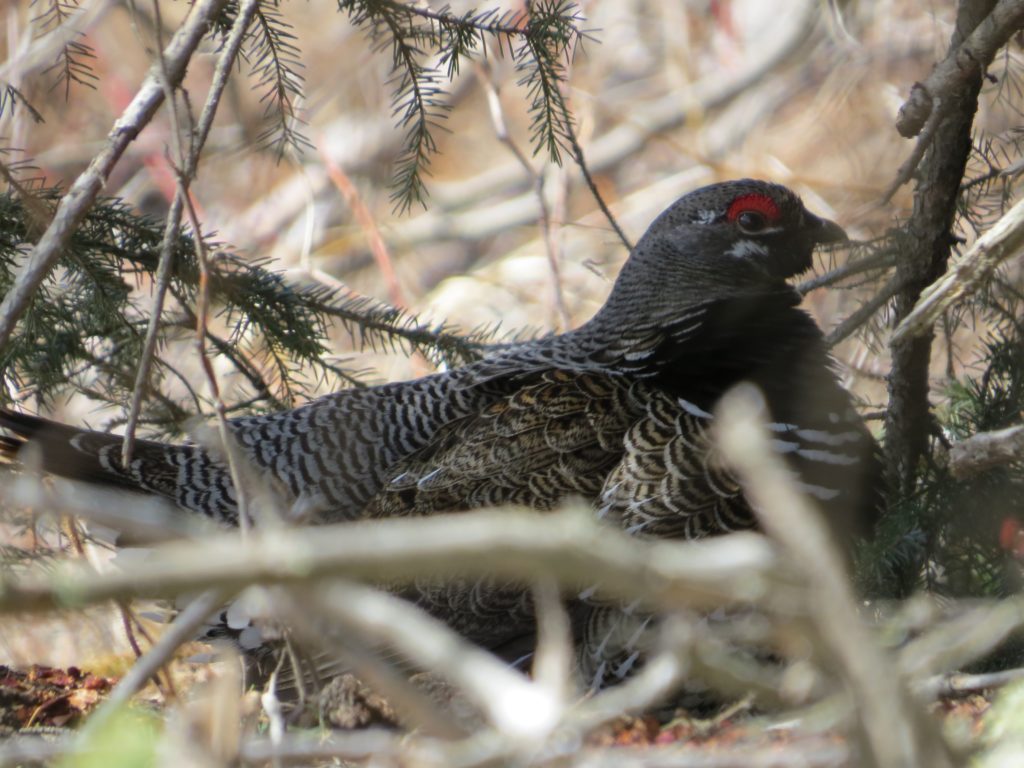 As I observed the Grouse, it began displaying! While I quietly watched from 15 feet away, I spied a hen Spruce Grouse near the male. She made little clucks that would cause the male to puff up and fan his tail straight up. Then a third Spruce Grouse flew in and landed 20 feet up in a Spruce Tree! This sound of the second one fluttering its wings also excited the male on the ground. The birds and I were both in obstructed quarters which didn’t allow for the best viewing, but I was eventually able to get in a position to better capture the displaying male.
As I observed the Grouse, it began displaying! While I quietly watched from 15 feet away, I spied a hen Spruce Grouse near the male. She made little clucks that would cause the male to puff up and fan his tail straight up. Then a third Spruce Grouse flew in and landed 20 feet up in a Spruce Tree! This sound of the second one fluttering its wings also excited the male on the ground. The birds and I were both in obstructed quarters which didn’t allow for the best viewing, but I was eventually able to get in a position to better capture the displaying male.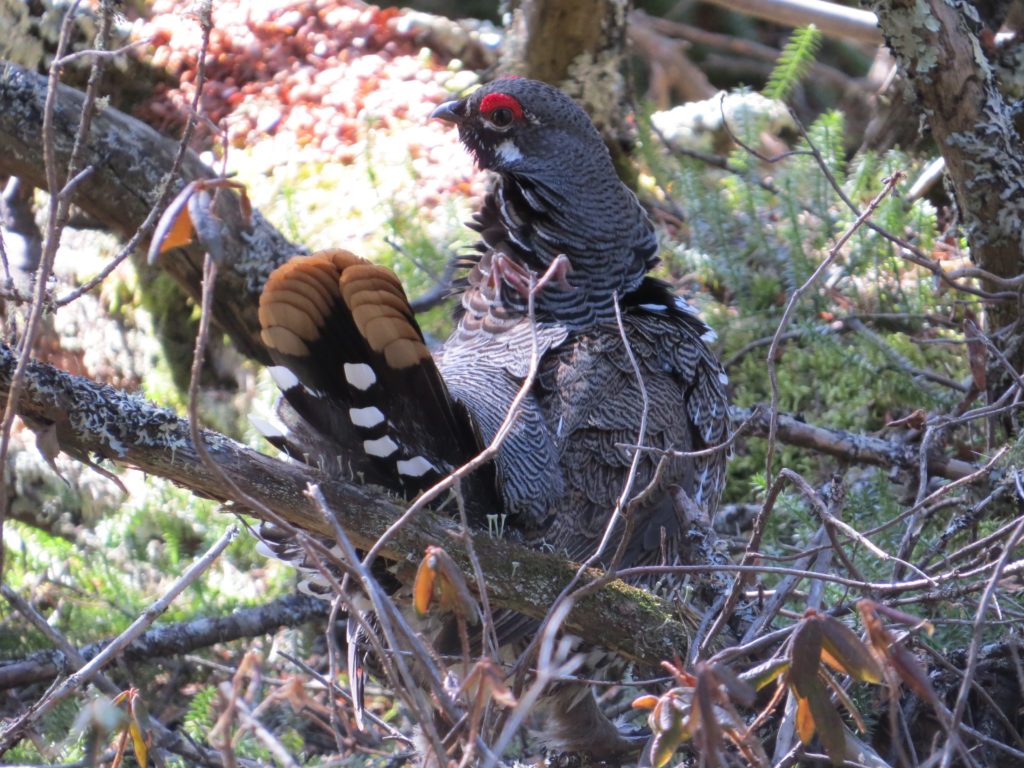
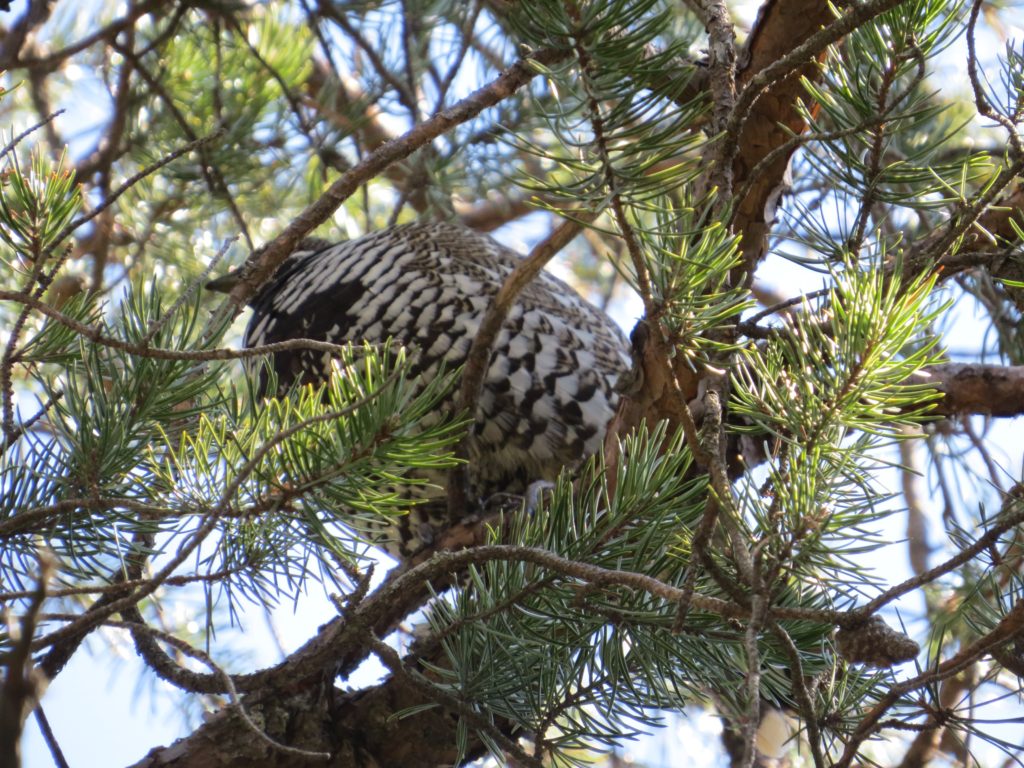 This bird did not mind that we were standing underneath him, nor did the female mind when we eventually got into a better position to check her out. We got to enjoy her taking a dust bath in the afternoon sun. I’d say she cleaned up pretty nice.
This bird did not mind that we were standing underneath him, nor did the female mind when we eventually got into a better position to check her out. We got to enjoy her taking a dust bath in the afternoon sun. I’d say she cleaned up pretty nice.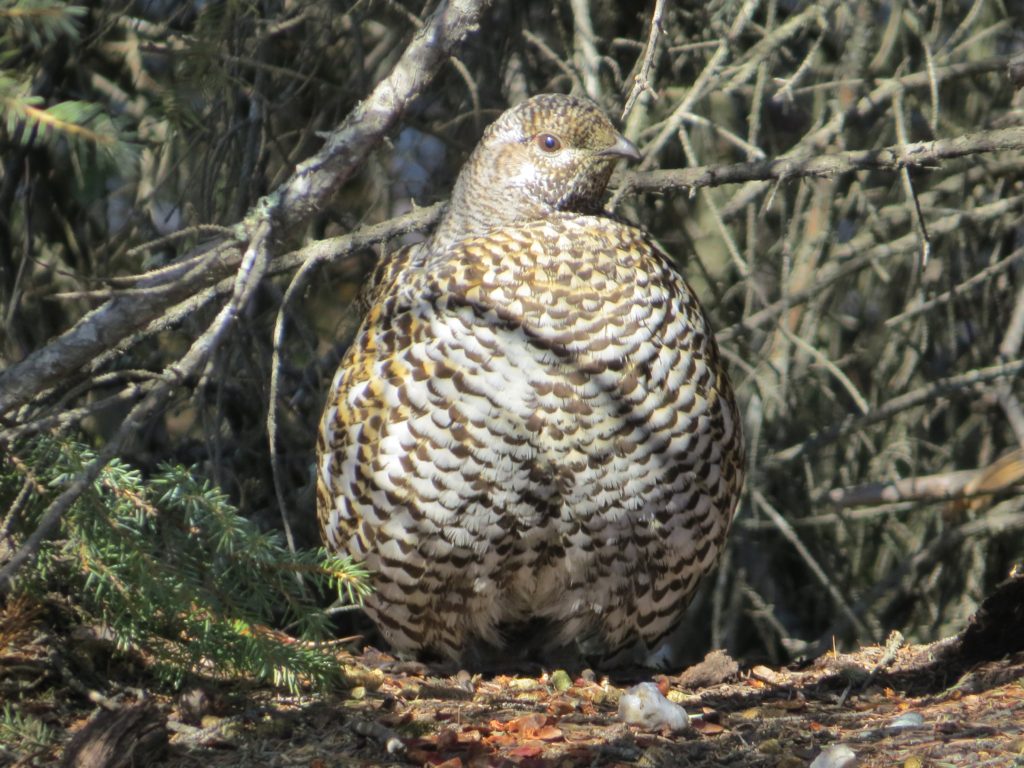 Each encounter I have with a Spruce Grouse is special and never taken for granted. I am still awestruck by this bird and may have finally gotten my fill, at least for a little while. And now, NOW, that we have dealt with the horribly distracting Spruce Grouse, we can move on to that incredible lifer in the next post.
Each encounter I have with a Spruce Grouse is special and never taken for granted. I am still awestruck by this bird and may have finally gotten my fill, at least for a little while. And now, NOW, that we have dealt with the horribly distracting Spruce Grouse, we can move on to that incredible lifer in the next post.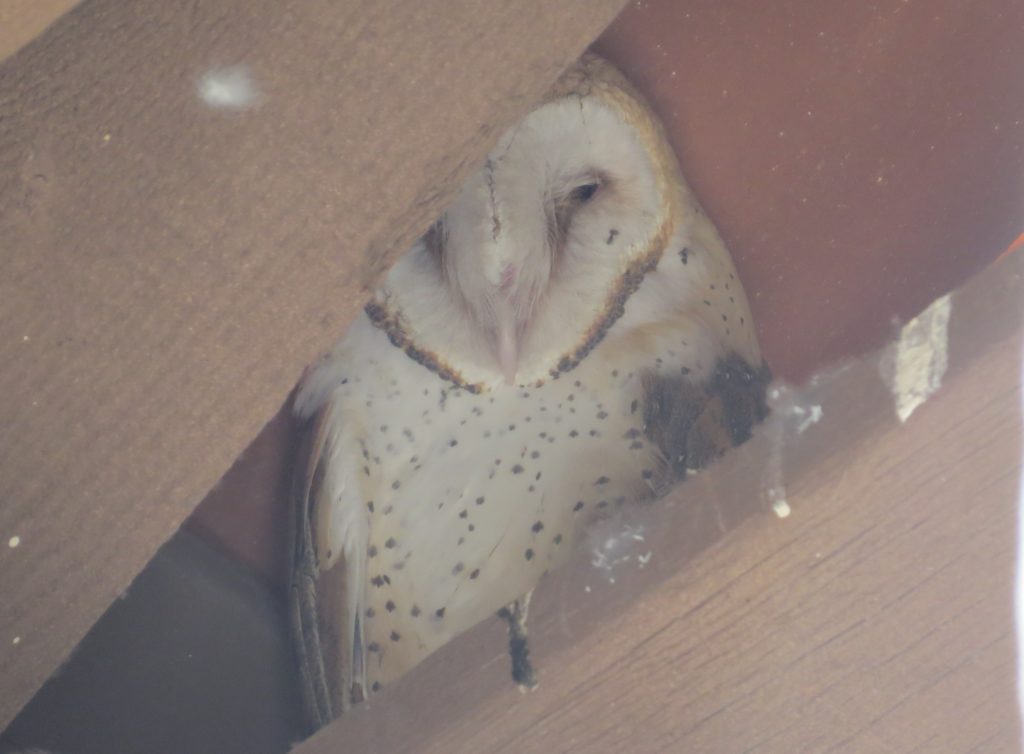
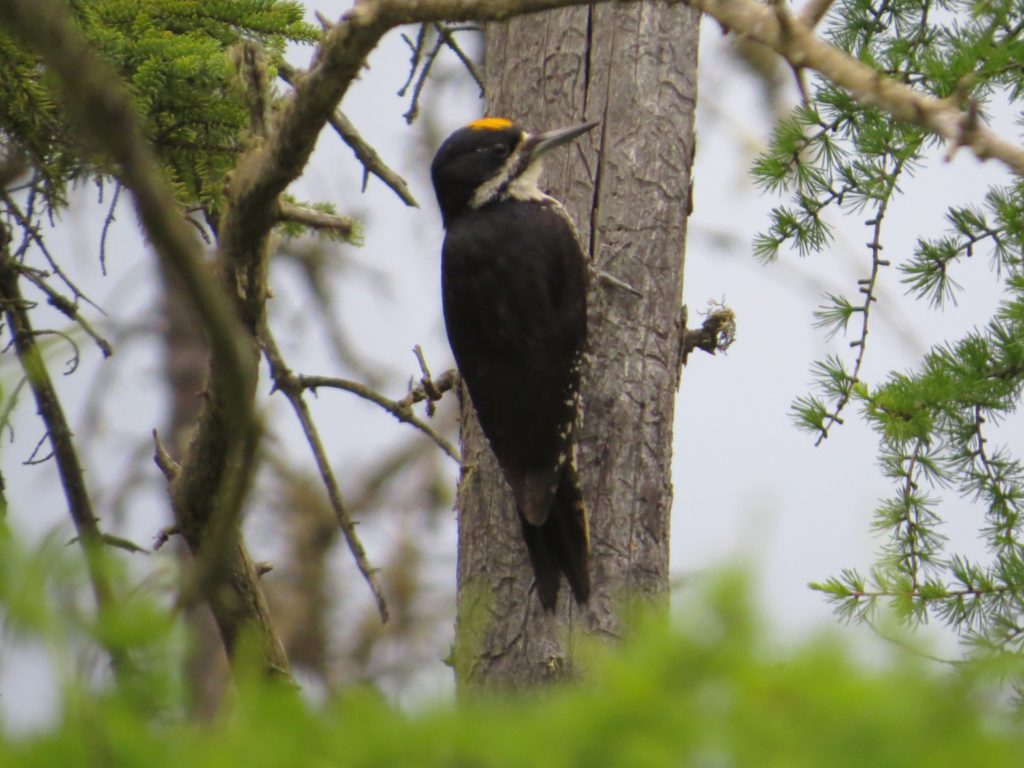 8.
8. 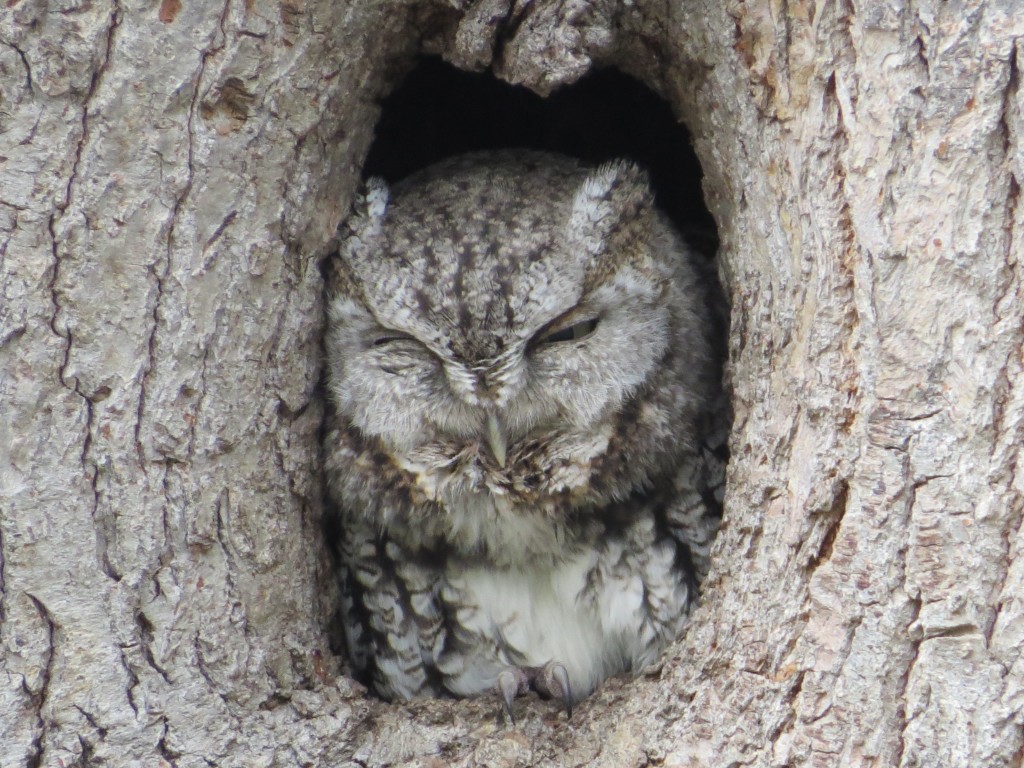 I actually scouted this bird twice, and it took just a slight amount of arm-twisting to convince Tommy to do what probably no other birder had ever done before–fly in to Minneapolis from Phoenix for less than 24 hours to see an Eastern Screech-Owl. But Tommy is an intrepid Owler and often does what no one else does. And because of that, Owling is always better with Tommy. The view of the Screech in the hole above is what 95% of the Owl paparazzi saw; Tommy and I were in the othe 5. As it has been said, when you think like everyone else, you aren’t really thinking. So rather than show up midday like everyone else to look for a sleeping Owl, Tommy and I were at Lake Harriet before the light of day completely by ourselves. In the emerging pre-dawn light, Tommy discovered the Screech Owl as it flew right by him, and once again I got to hear him say that adrenaline-pumping phrase, “Hey Josh!!” Tommy and I then enjoyed an extremely active Eastern Screech-Owl that wasn’t confined to a hole! The combination of helping Tommy get this life bird and getting Owl #16 for his Big Year along with the show this Owl put on made it feel like a lifer experience even though it wasn’t for me.
I actually scouted this bird twice, and it took just a slight amount of arm-twisting to convince Tommy to do what probably no other birder had ever done before–fly in to Minneapolis from Phoenix for less than 24 hours to see an Eastern Screech-Owl. But Tommy is an intrepid Owler and often does what no one else does. And because of that, Owling is always better with Tommy. The view of the Screech in the hole above is what 95% of the Owl paparazzi saw; Tommy and I were in the othe 5. As it has been said, when you think like everyone else, you aren’t really thinking. So rather than show up midday like everyone else to look for a sleeping Owl, Tommy and I were at Lake Harriet before the light of day completely by ourselves. In the emerging pre-dawn light, Tommy discovered the Screech Owl as it flew right by him, and once again I got to hear him say that adrenaline-pumping phrase, “Hey Josh!!” Tommy and I then enjoyed an extremely active Eastern Screech-Owl that wasn’t confined to a hole! The combination of helping Tommy get this life bird and getting Owl #16 for his Big Year along with the show this Owl put on made it feel like a lifer experience even though it wasn’t for me.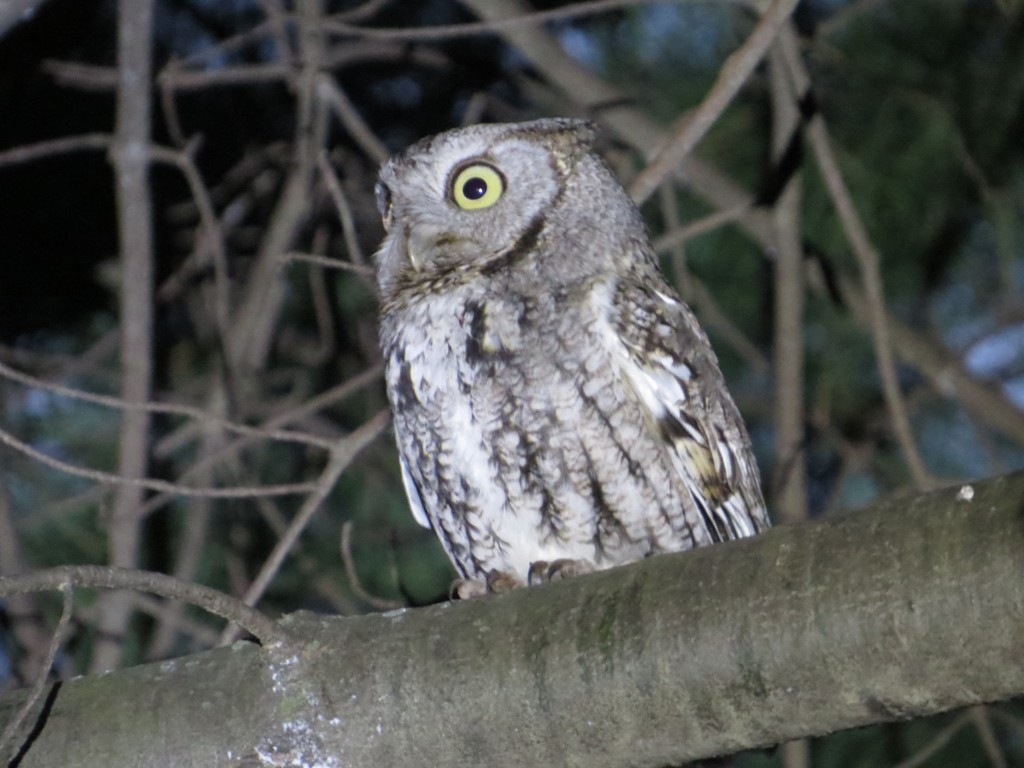 7.
7. 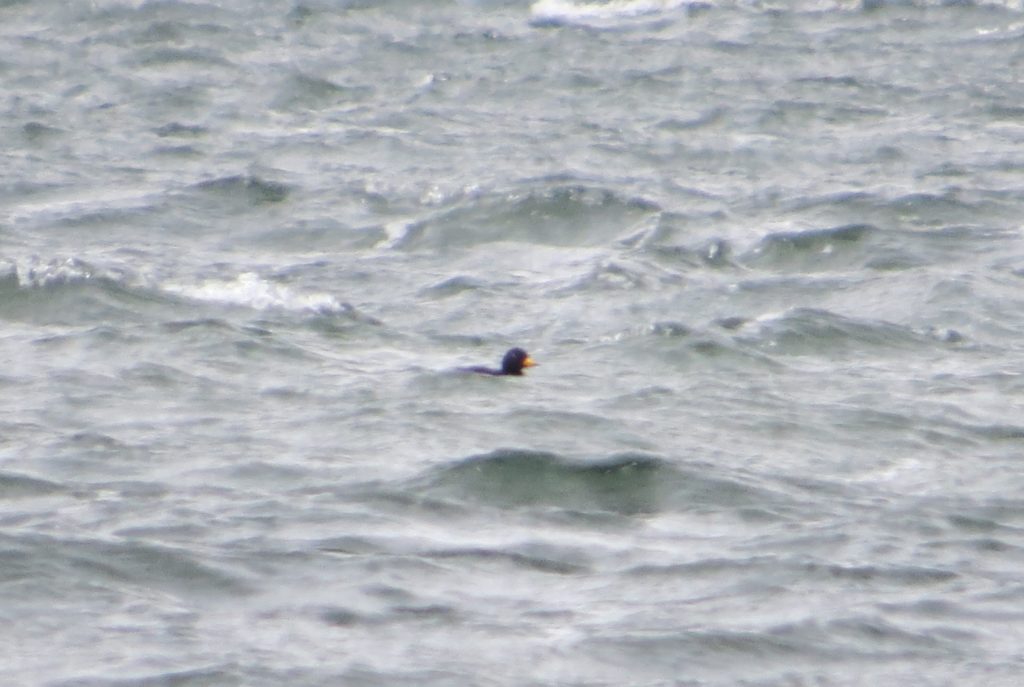 6.
6. 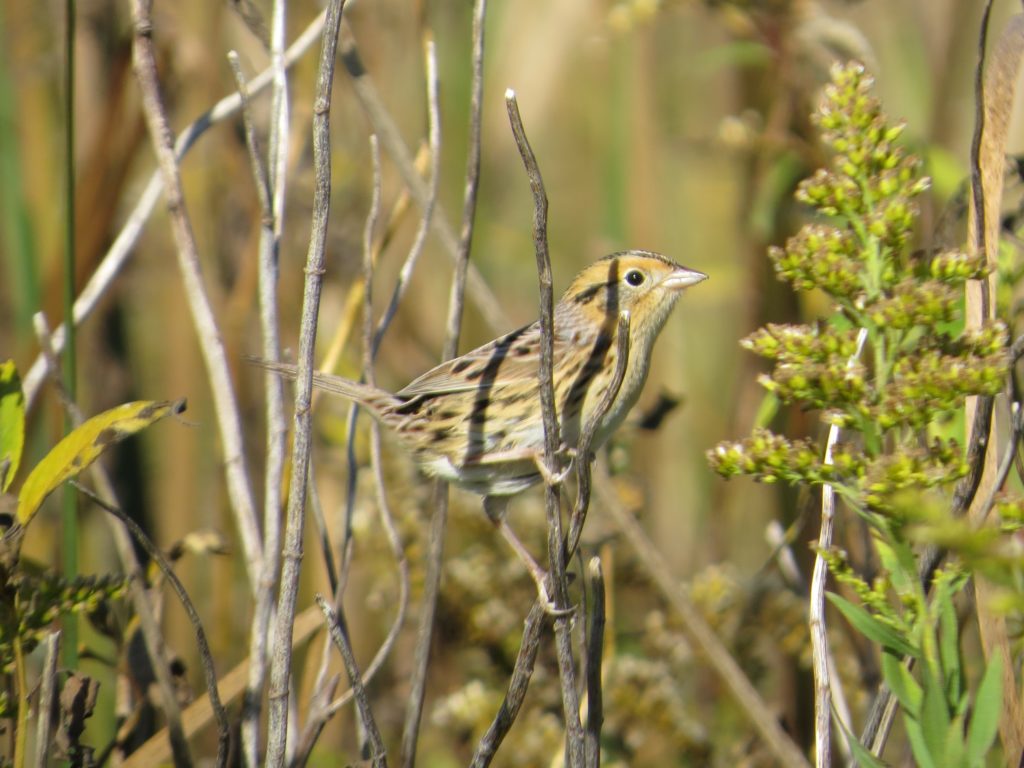 5.
5. 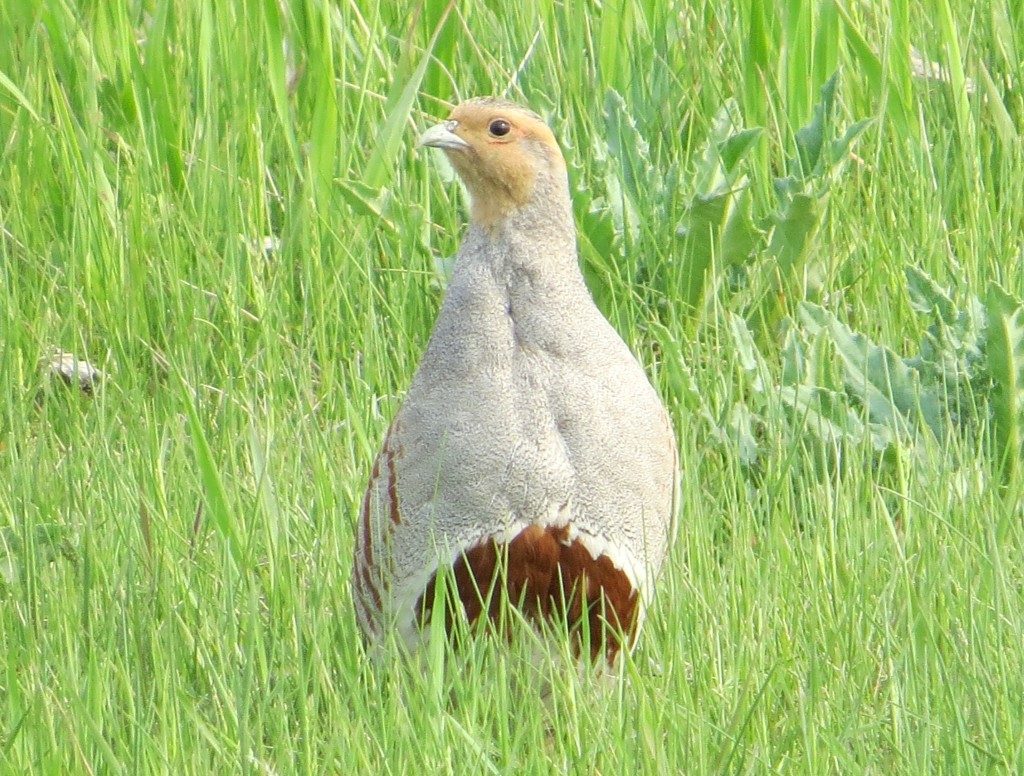 4.
4. 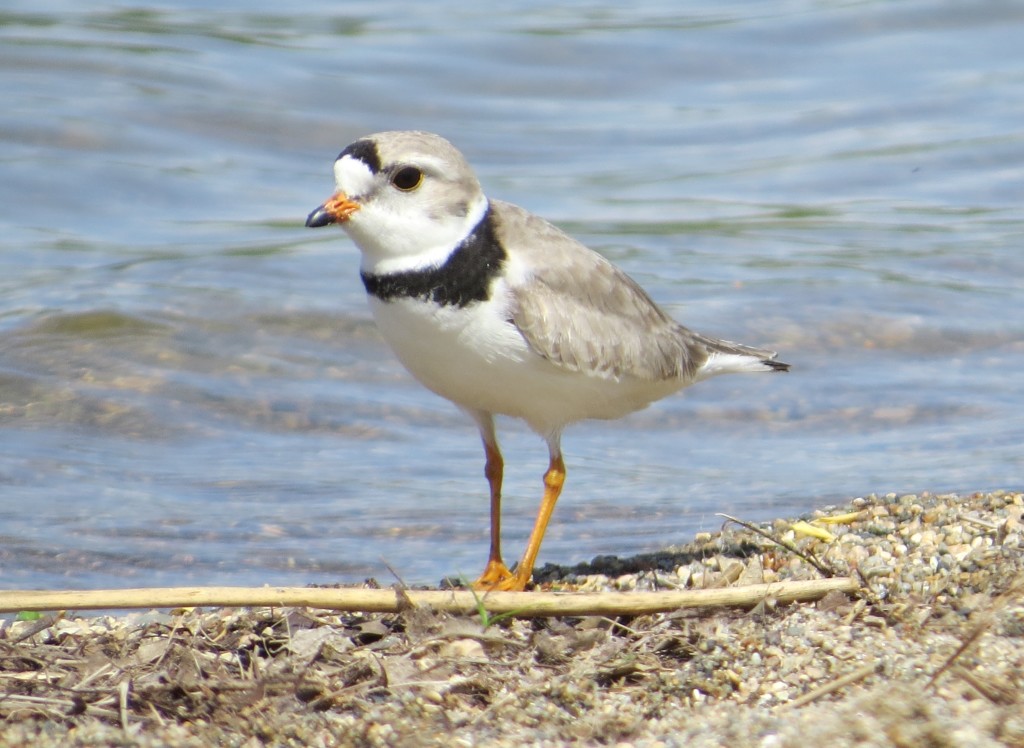 3.
3. 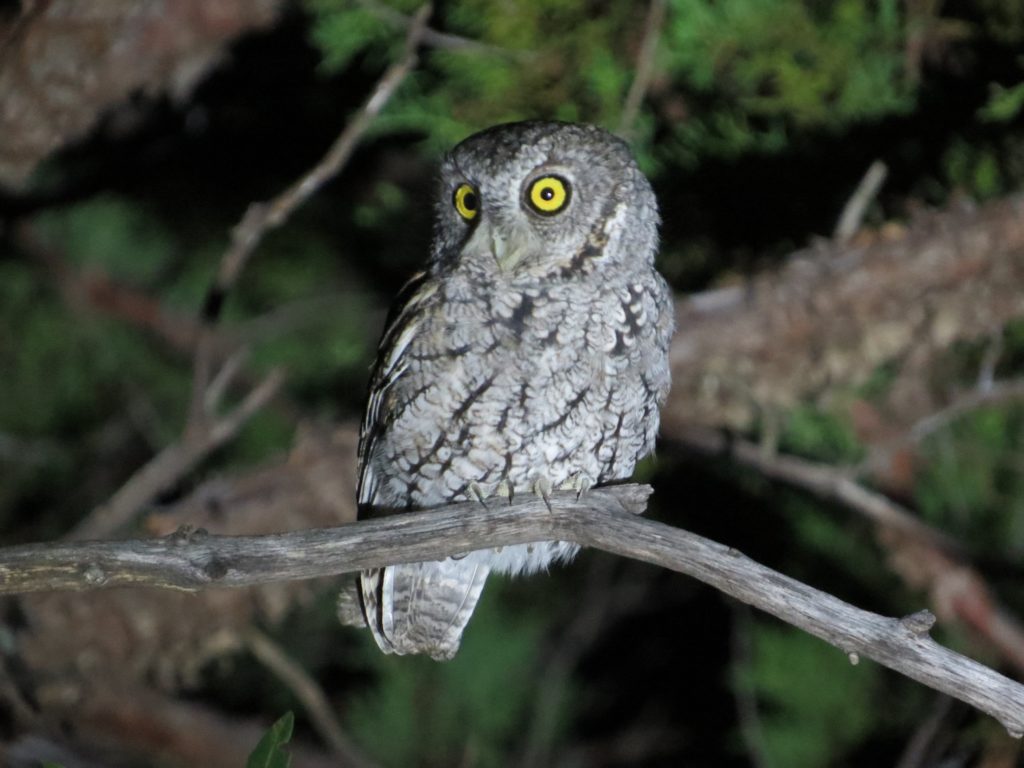 2.
2. 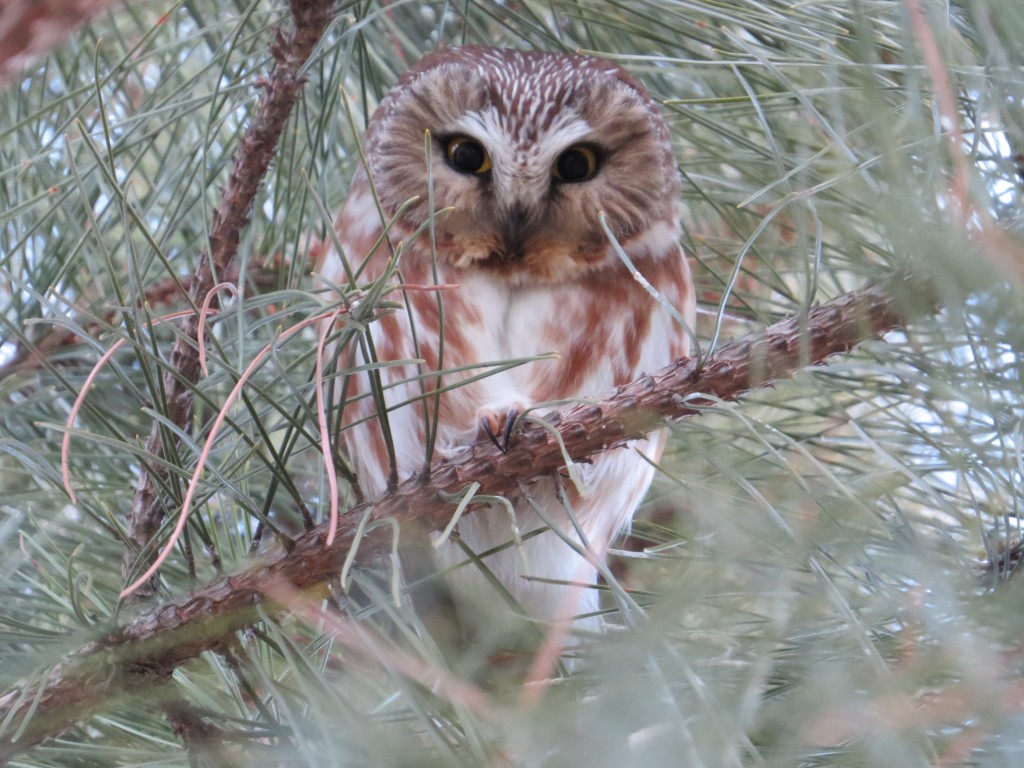 1. So here we are at #1. What is it you might ask? A lifer? A state bird? A vagrant? A colorful bird? None of the above! In my never ending studies of Kandiyohi County birding, I had learned that Kandiyohi County had no record of a Surf Scoter. It didn’t make sense to me since our county is full of lakes, and this species shows up regularly throughout the state during their migration window. So I made it my personal mission to get out there and find one. Besides, I just really love sea ducks. For weeks this fall I checked soooo many lakes and always got the same result–until one day when I got a different result:
1. So here we are at #1. What is it you might ask? A lifer? A state bird? A vagrant? A colorful bird? None of the above! In my never ending studies of Kandiyohi County birding, I had learned that Kandiyohi County had no record of a Surf Scoter. It didn’t make sense to me since our county is full of lakes, and this species shows up regularly throughout the state during their migration window. So I made it my personal mission to get out there and find one. Besides, I just really love sea ducks. For weeks this fall I checked soooo many lakes and always got the same result–until one day when I got a different result: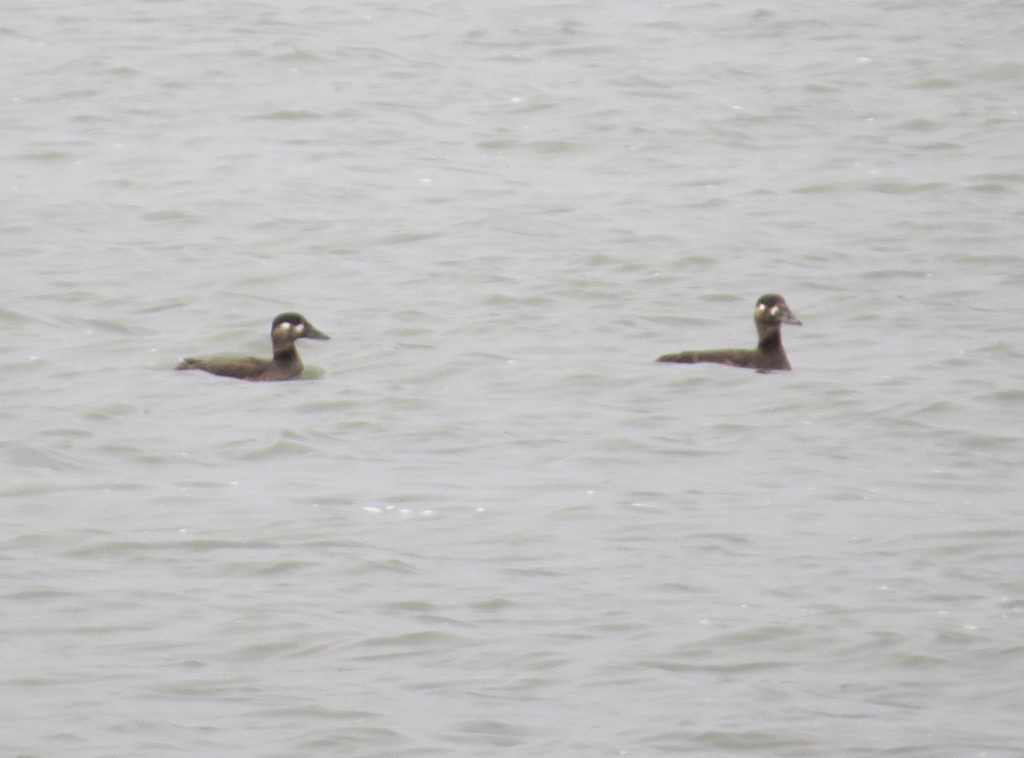 It was a brand new bird for our county which is not an easy task these days. In a county with 311 recorded species, of which Randy Frederickson has seen 292 of them, there are very few birding frontiers on the home turf. One of the great things about this sighting was that my Kandiyohi County birding friends Randy Frederickson, Ron Erpelding, Joel Schmidt, and Steve Gardner all got to add this bird to their county lists too. For Joel it was even a state bird, and for Steve it was life bird.
It was a brand new bird for our county which is not an easy task these days. In a county with 311 recorded species, of which Randy Frederickson has seen 292 of them, there are very few birding frontiers on the home turf. One of the great things about this sighting was that my Kandiyohi County birding friends Randy Frederickson, Ron Erpelding, Joel Schmidt, and Steve Gardner all got to add this bird to their county lists too. For Joel it was even a state bird, and for Steve it was life bird.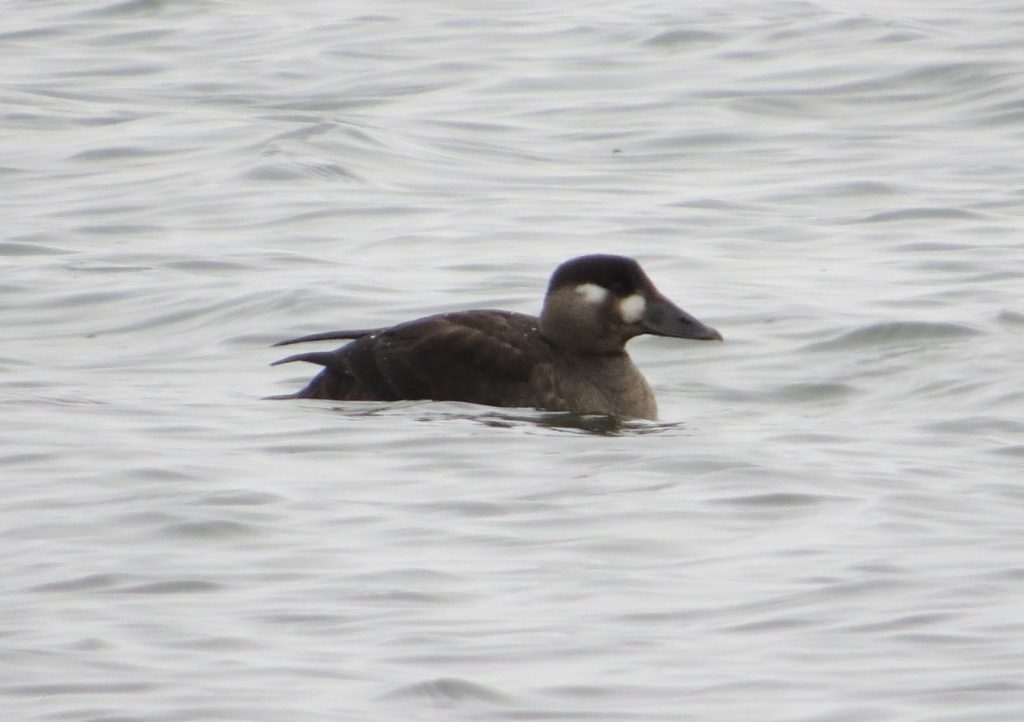
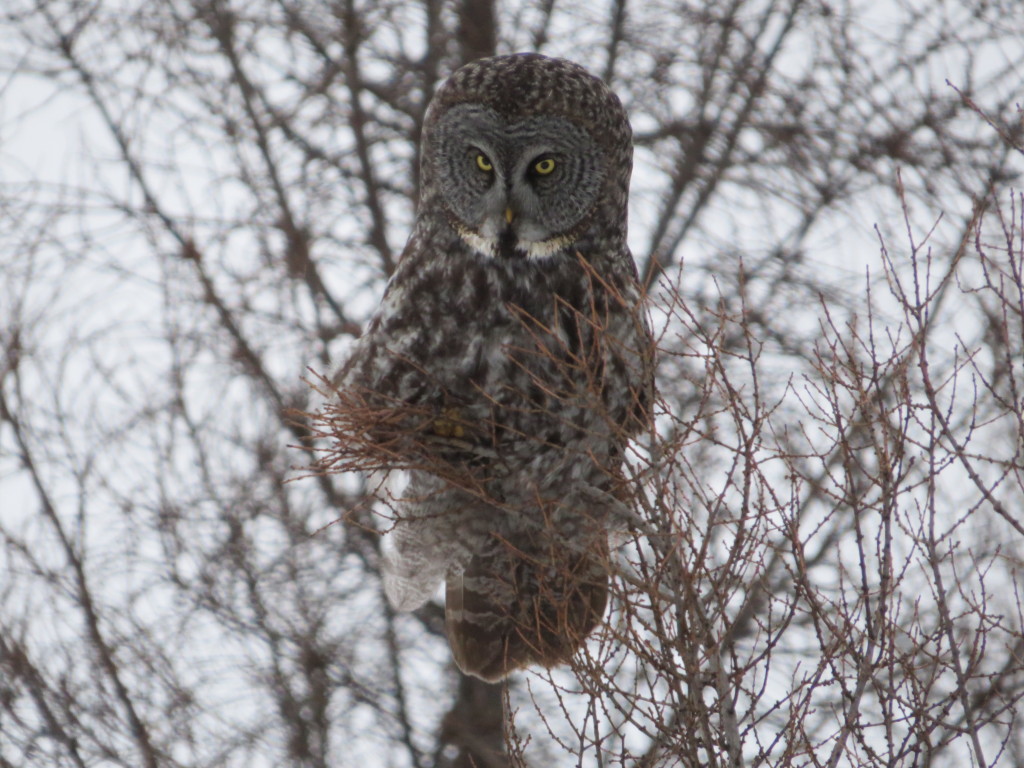
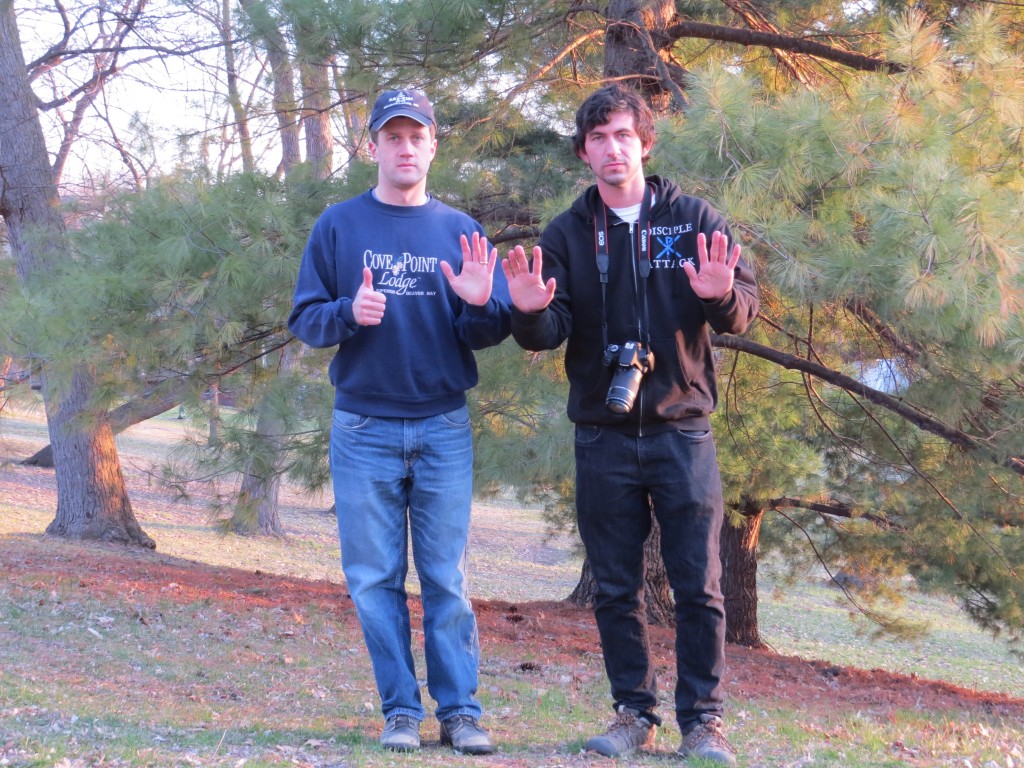
 When I pulled up to the boat launch at Lake Waconia Regional Park, I saw a Carver County Sheriff truck trailering a patrol boat. I thought it was odd since no one would be on the lake on a day like this nor could a boat be launched in the rapidly building ice. Strange. I didn’t think about it much more and set about my business of finding my target. Watching the sea swells and facing into the sub-zero windchills was brutal even for being dressed for the elements. Scans of the big lake were intermittent and necessitated warm-up sessions in the car. Having no luck seeing the duck (which was there that morning), I asked Julie for any tips on where to stare into that blue abyss to find this duck. In giving me directions, Julie also reminded me of the ongoing search for a paddleboarder that went missing two week prior. The dots started connecting in my head regarding the Sheriff’s trailered boat, trucks driving slowly along the shoreline who I had thought were also looking for the Scoter, and my own vague recollection of a news report I had seen. It was suddenly a grim realization that I should be looking for more than just my bird.
When I pulled up to the boat launch at Lake Waconia Regional Park, I saw a Carver County Sheriff truck trailering a patrol boat. I thought it was odd since no one would be on the lake on a day like this nor could a boat be launched in the rapidly building ice. Strange. I didn’t think about it much more and set about my business of finding my target. Watching the sea swells and facing into the sub-zero windchills was brutal even for being dressed for the elements. Scans of the big lake were intermittent and necessitated warm-up sessions in the car. Having no luck seeing the duck (which was there that morning), I asked Julie for any tips on where to stare into that blue abyss to find this duck. In giving me directions, Julie also reminded me of the ongoing search for a paddleboarder that went missing two week prior. The dots started connecting in my head regarding the Sheriff’s trailered boat, trucks driving slowly along the shoreline who I had thought were also looking for the Scoter, and my own vague recollection of a news report I had seen. It was suddenly a grim realization that I should be looking for more than just my bird.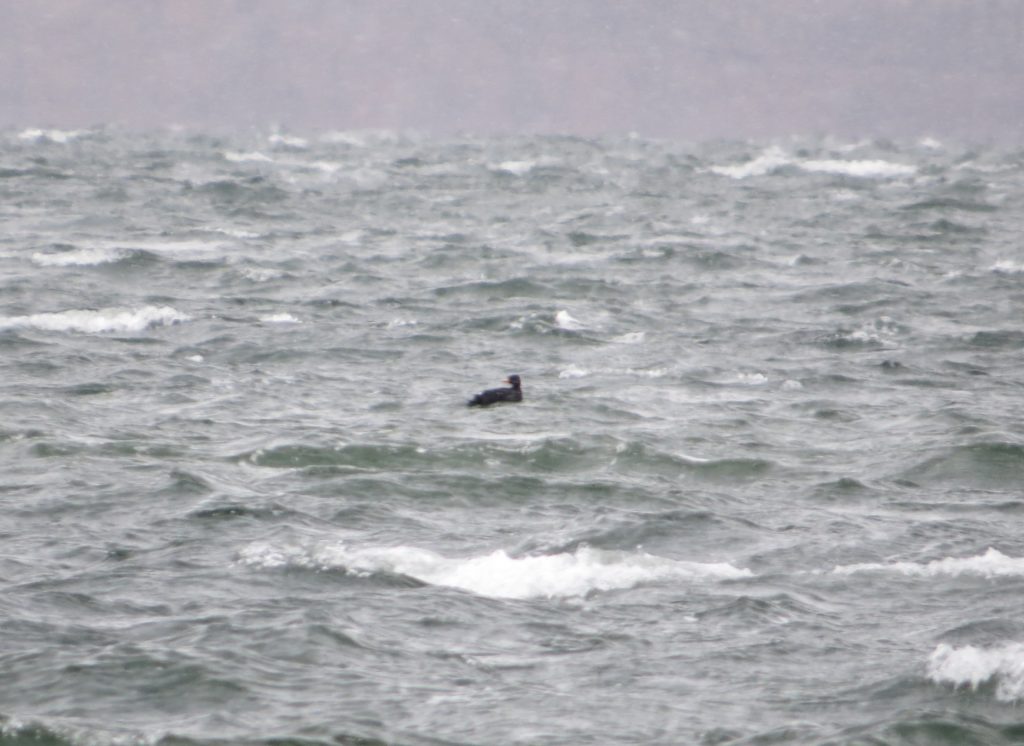 The incredible distance, the numb fingers, and disappearing/reappearing bird made picture-taking a nightmare. Regardless, I was thrilled to finally add this bird and see an adult male at that, a gender/plumage combo that is rarely ever seen in the state.
The incredible distance, the numb fingers, and disappearing/reappearing bird made picture-taking a nightmare. Regardless, I was thrilled to finally add this bird and see an adult male at that, a gender/plumage combo that is rarely ever seen in the state.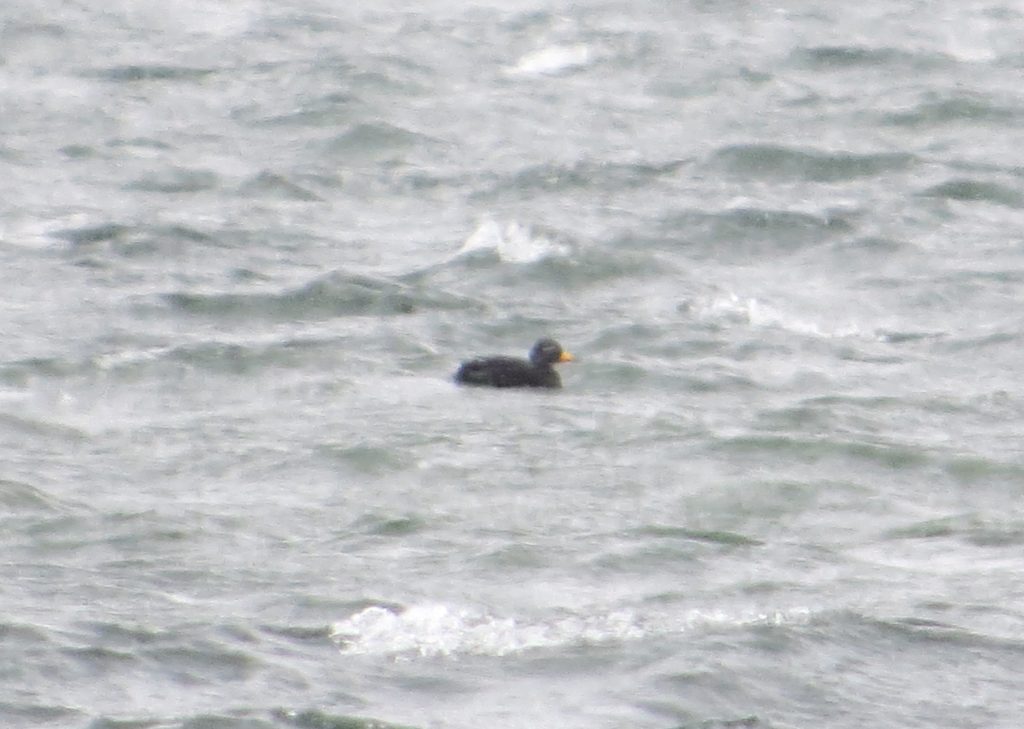
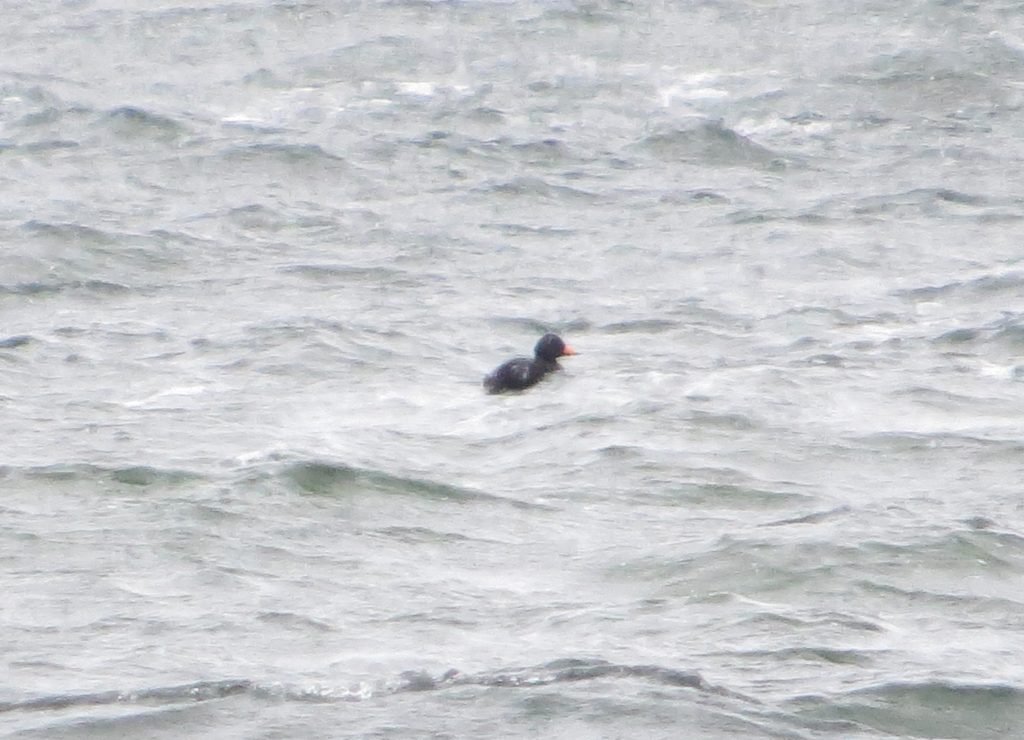 The excitement of this new addition was tempered by a Sheriff’s helicopter making constant circles around the lake the whole time I was there, undoubtedly desperate to find this man on this last day of open water. The man was just a couple years younger than me with two young kids and another on the way. He had gone out to pursue his passion of wildlife photography from his paddleboard. And here I was at the same body of water just a couple weeks later pursuing mine. Life really is unfair. The whole ride back to work it was hard not to wonder if I sometimes take unnecessary risks in the pursuit of my hobby. Then again, a life lived with no adventure is a life not fully lived. Seize the day.
The excitement of this new addition was tempered by a Sheriff’s helicopter making constant circles around the lake the whole time I was there, undoubtedly desperate to find this man on this last day of open water. The man was just a couple years younger than me with two young kids and another on the way. He had gone out to pursue his passion of wildlife photography from his paddleboard. And here I was at the same body of water just a couple weeks later pursuing mine. Life really is unfair. The whole ride back to work it was hard not to wonder if I sometimes take unnecessary risks in the pursuit of my hobby. Then again, a life lived with no adventure is a life not fully lived. Seize the day.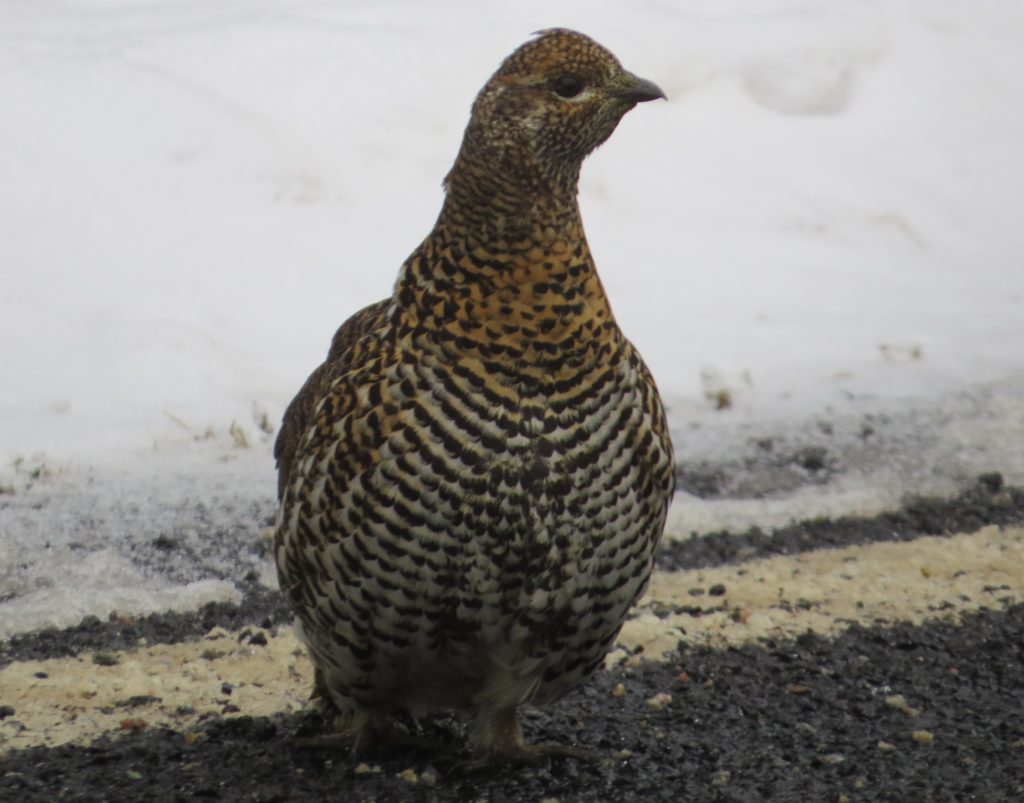 I couldn’t believe my luck. This happened once two years ago in this same spot but with just one bird. The female (lifer gender) above and the male below stood motionless on the road as I crept the vehicle closer and closer to them.
I couldn’t believe my luck. This happened once two years ago in this same spot but with just one bird. The female (lifer gender) above and the male below stood motionless on the road as I crept the vehicle closer and closer to them.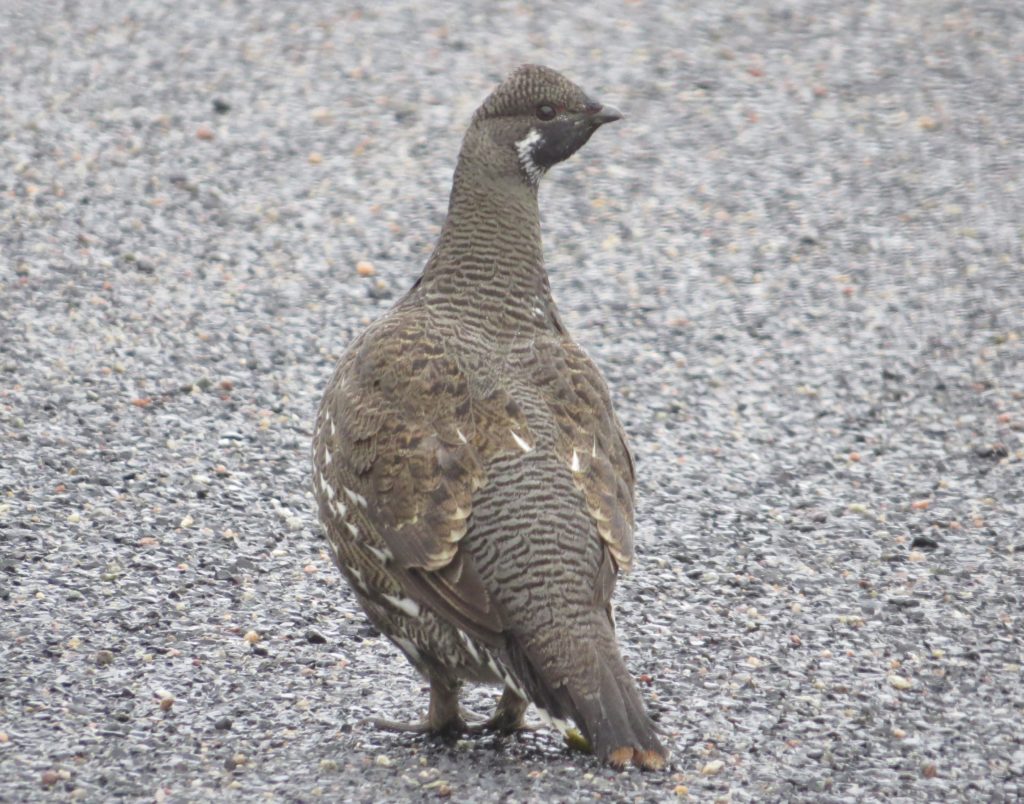 As I watched, I spotted a second male just on the edge of the woods who wanted nothing to do with me.
As I watched, I spotted a second male just on the edge of the woods who wanted nothing to do with me.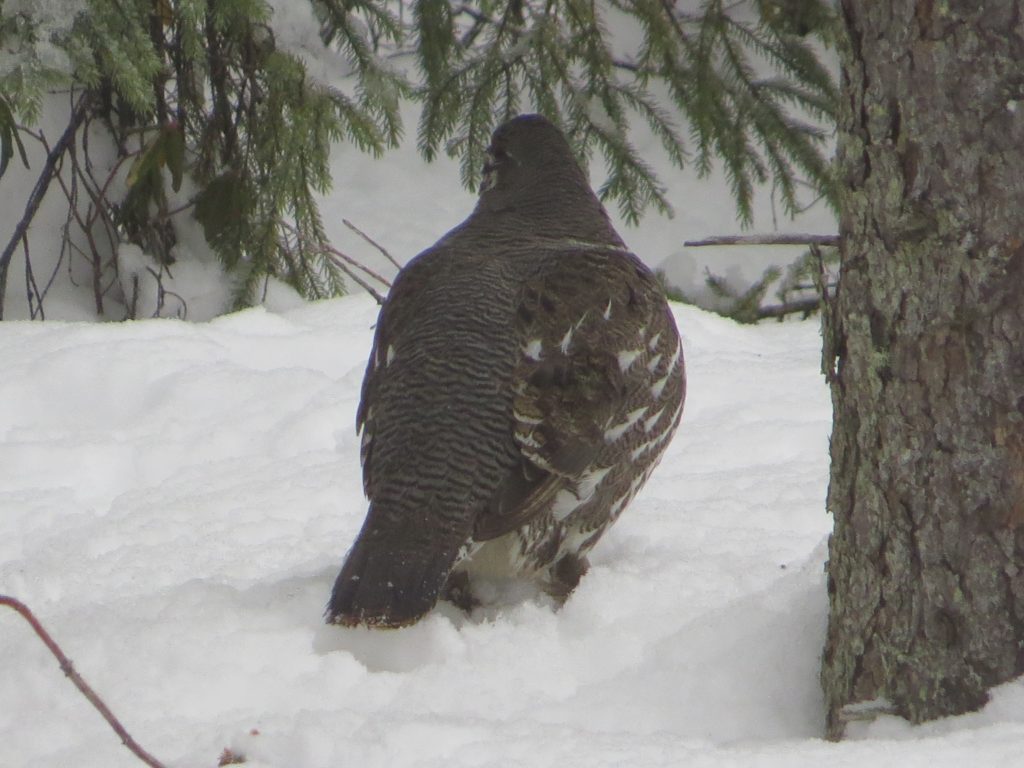 I wanted to creep by the birds and get around them by driving on the shoulder so that I could view these dark, male statues from the front, their better side. As I did so, another car came down the highway and now I was worried these dumb things would get killed. I wasn’t going to let that happen, so I planned to shoo them off the road. But I didn’t have to because my close presence at this point and the approaching car thankfully activated them. I was able to snap another pic of the male on the road before he flew off. The birds barely flew into the edge of the woods and never re-flushed, yet try as I might, I could not pick them out of the Spruce trees. Their camouflage and ability to sit motionless are amazing.
I wanted to creep by the birds and get around them by driving on the shoulder so that I could view these dark, male statues from the front, their better side. As I did so, another car came down the highway and now I was worried these dumb things would get killed. I wasn’t going to let that happen, so I planned to shoo them off the road. But I didn’t have to because my close presence at this point and the approaching car thankfully activated them. I was able to snap another pic of the male on the road before he flew off. The birds barely flew into the edge of the woods and never re-flushed, yet try as I might, I could not pick them out of the Spruce trees. Their camouflage and ability to sit motionless are amazing.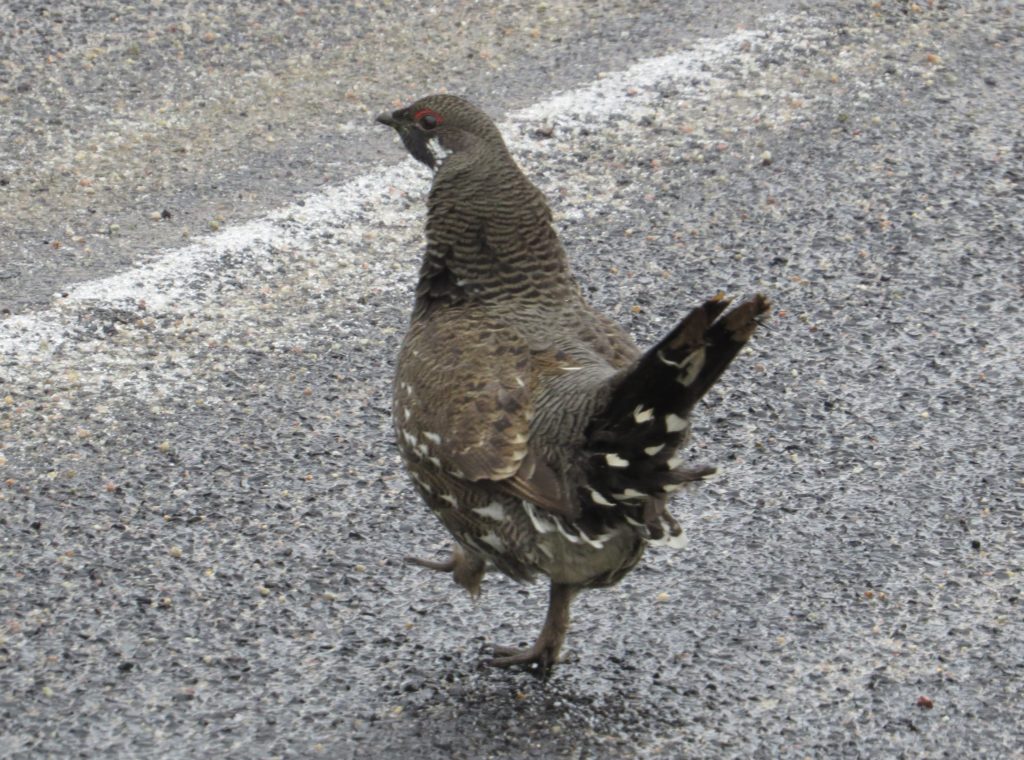
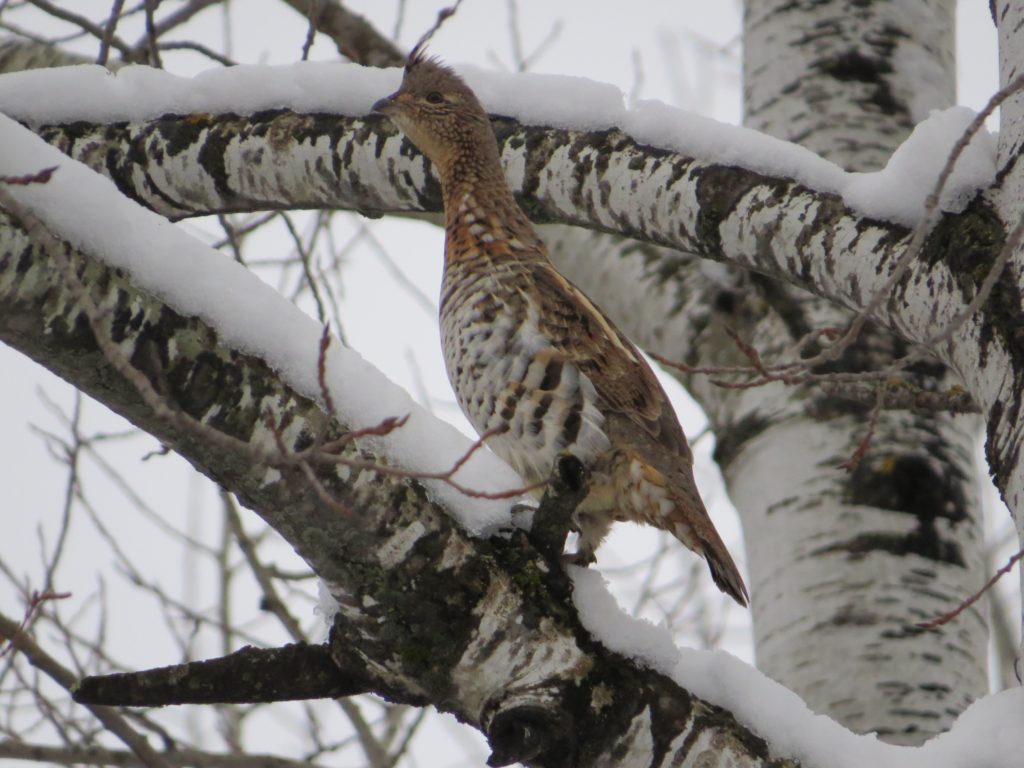 and Birch catkins…
and Birch catkins…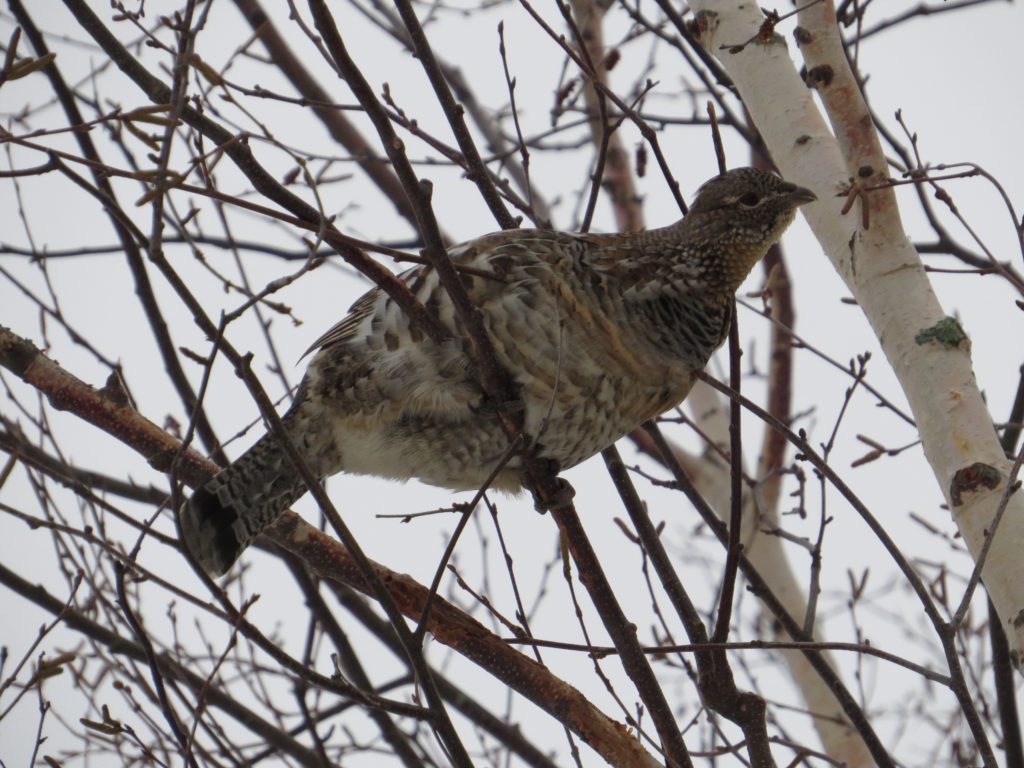 Everyone eats well at Grandma’s house and goes home stuffed.
Everyone eats well at Grandma’s house and goes home stuffed.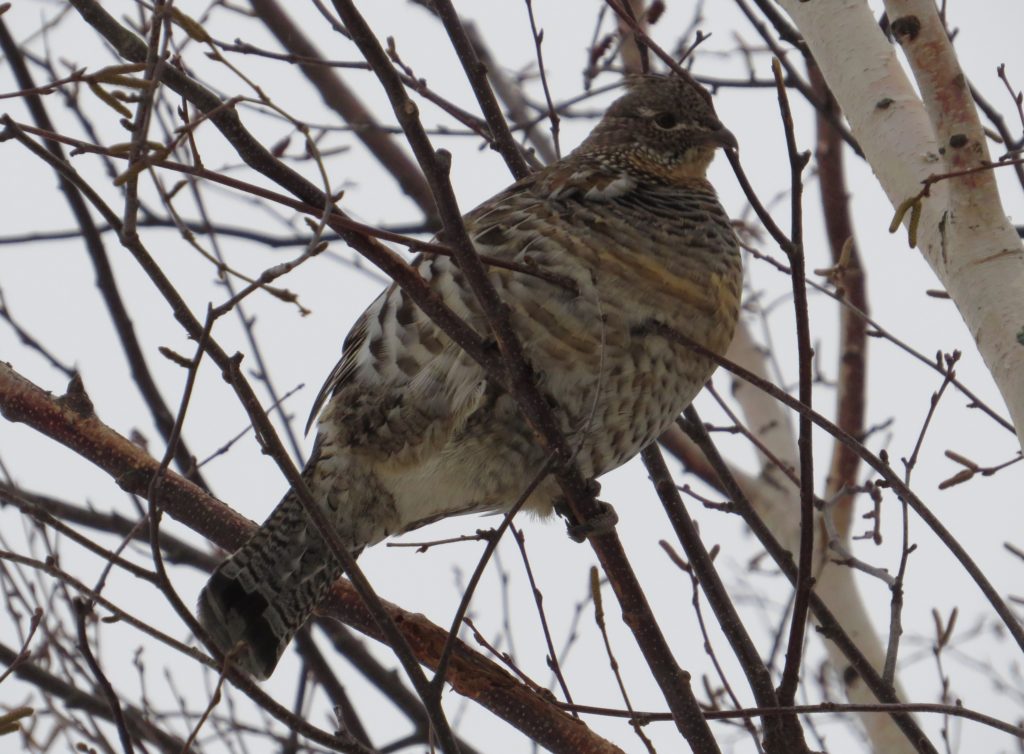
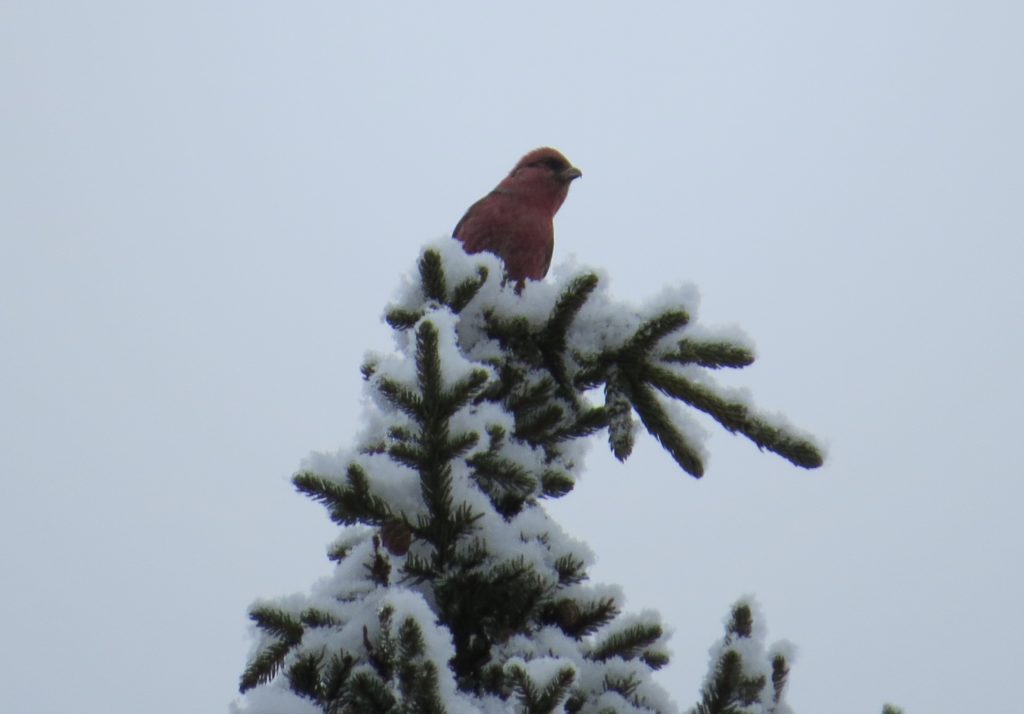
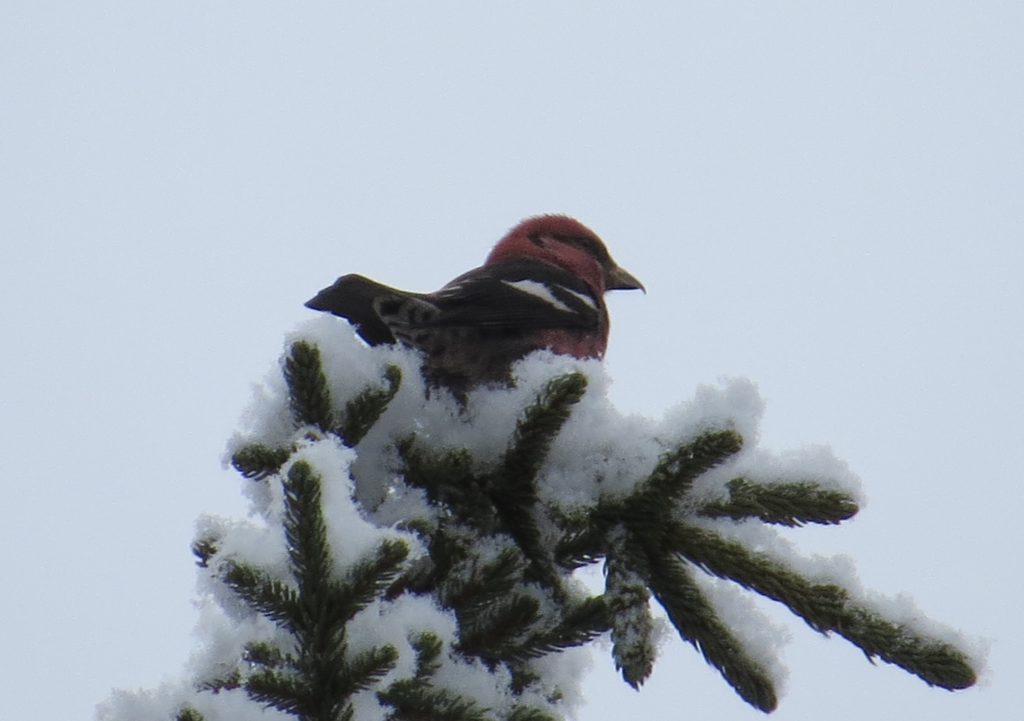 A little while later, Julie asked me to stop the car to check out a bird I had dismissed as a Raven. This instance is proof of why two birders are better than one because Julie had spotted a juvenile Northern Goshawk! Like the Crossbill, this was another photographic first for me. I have had several probable NOGOs in the area but had never had one sit still before to know for sure.
A little while later, Julie asked me to stop the car to check out a bird I had dismissed as a Raven. This instance is proof of why two birders are better than one because Julie had spotted a juvenile Northern Goshawk! Like the Crossbill, this was another photographic first for me. I have had several probable NOGOs in the area but had never had one sit still before to know for sure.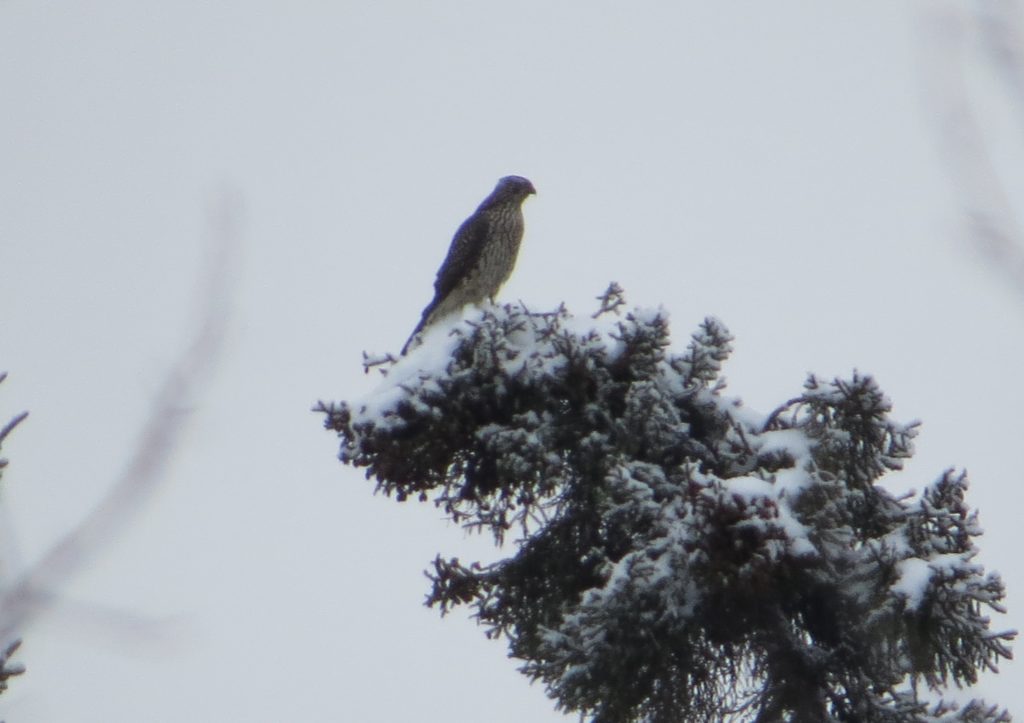 To end my birding for this trip, I later went into the town of Cook and found the Bohemian Waxwing flock Julie had told me about.
To end my birding for this trip, I later went into the town of Cook and found the Bohemian Waxwing flock Julie had told me about.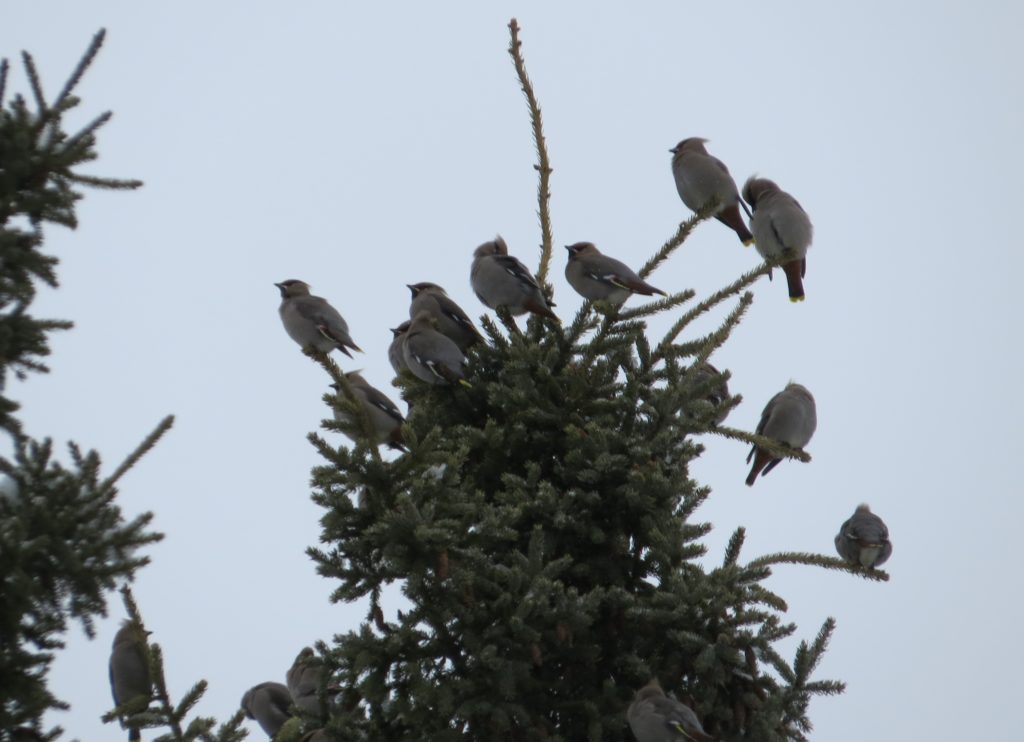 This holiday’s birds were off the charts. It ended up being some of the best birding I’ve ever had at home up north and certainly gives the birder in me much to be thankful for. Unfortunately gratitude has a time limit before greed kicks in…how many more days until we go home for Christmas?
This holiday’s birds were off the charts. It ended up being some of the best birding I’ve ever had at home up north and certainly gives the birder in me much to be thankful for. Unfortunately gratitude has a time limit before greed kicks in…how many more days until we go home for Christmas?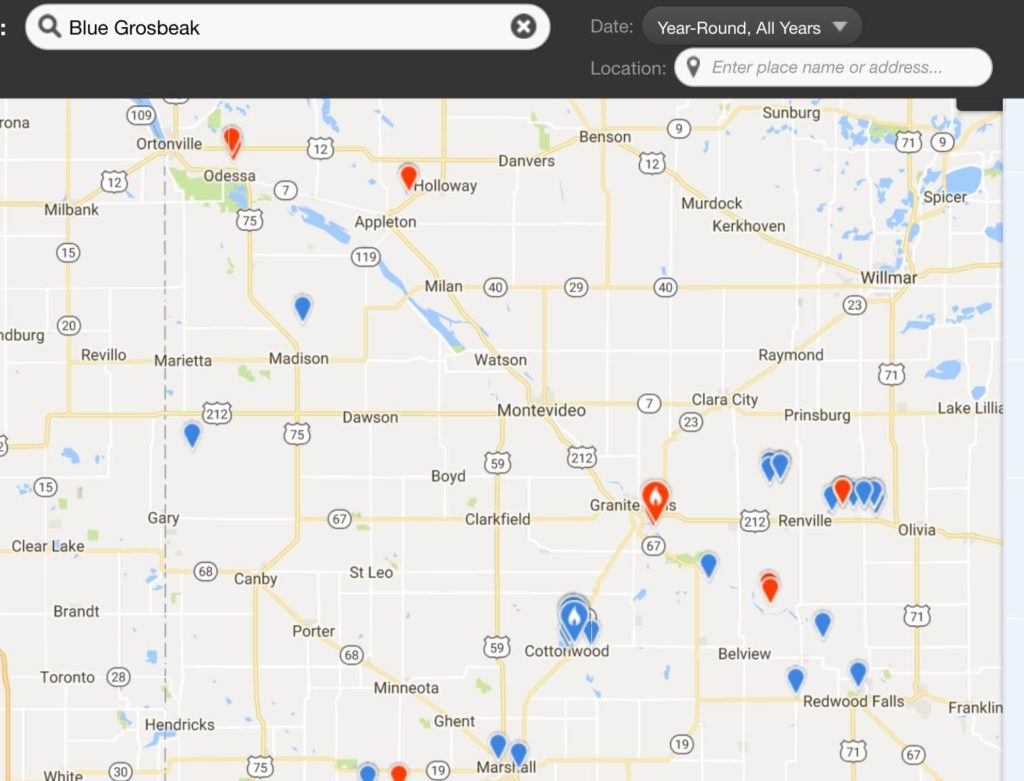
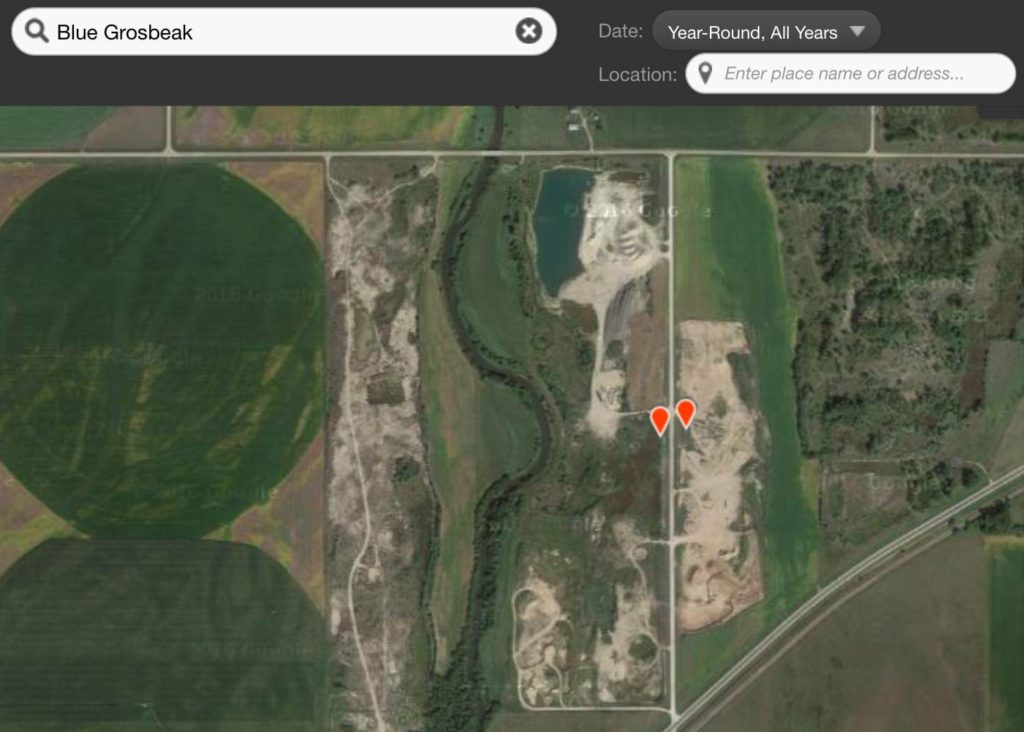
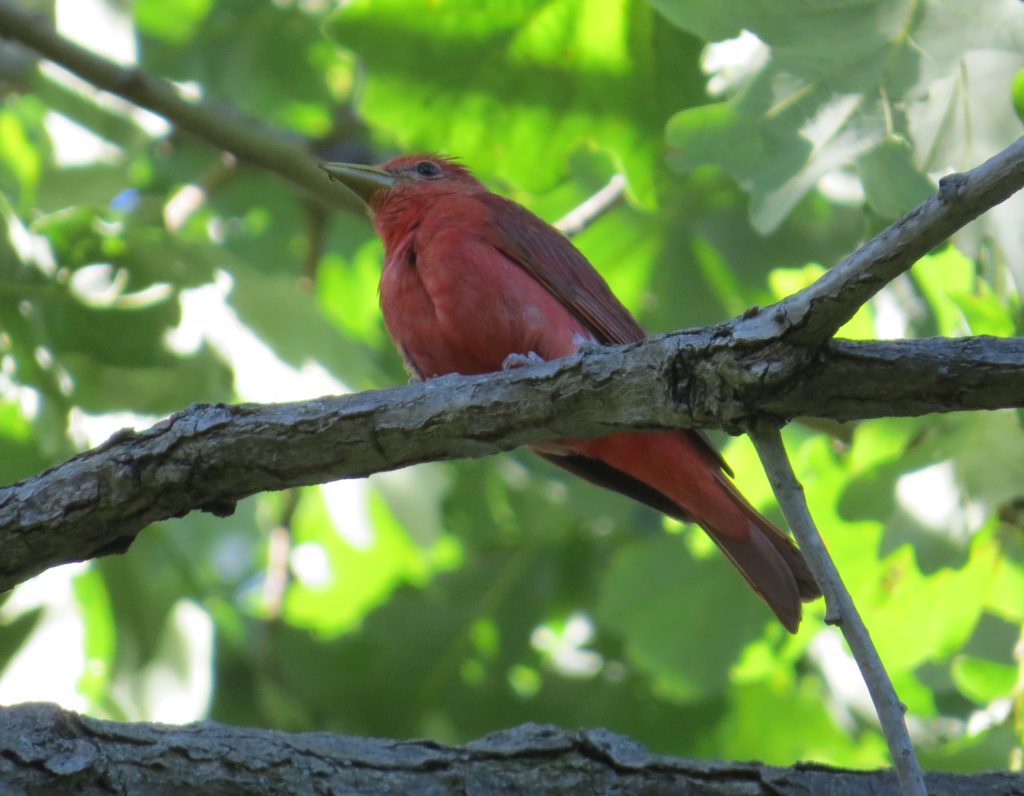 One of the most popular birds in Minnesota this summer has been the Summer Tanager discovered by Wilmer Fernandez at the University of Minnesota’s Landscape Arboretum in Chanhassen. Summer Tanager is rare-regular in the state, but the fact that this bachelor bird was in the Twin Cities and singing endlessly on territory made it all the rage for the better part of a week. Not even the Arboretum’s steep per person entry fee could keep birders away, including yours truly.
One of the most popular birds in Minnesota this summer has been the Summer Tanager discovered by Wilmer Fernandez at the University of Minnesota’s Landscape Arboretum in Chanhassen. Summer Tanager is rare-regular in the state, but the fact that this bachelor bird was in the Twin Cities and singing endlessly on territory made it all the rage for the better part of a week. Not even the Arboretum’s steep per person entry fee could keep birders away, including yours truly.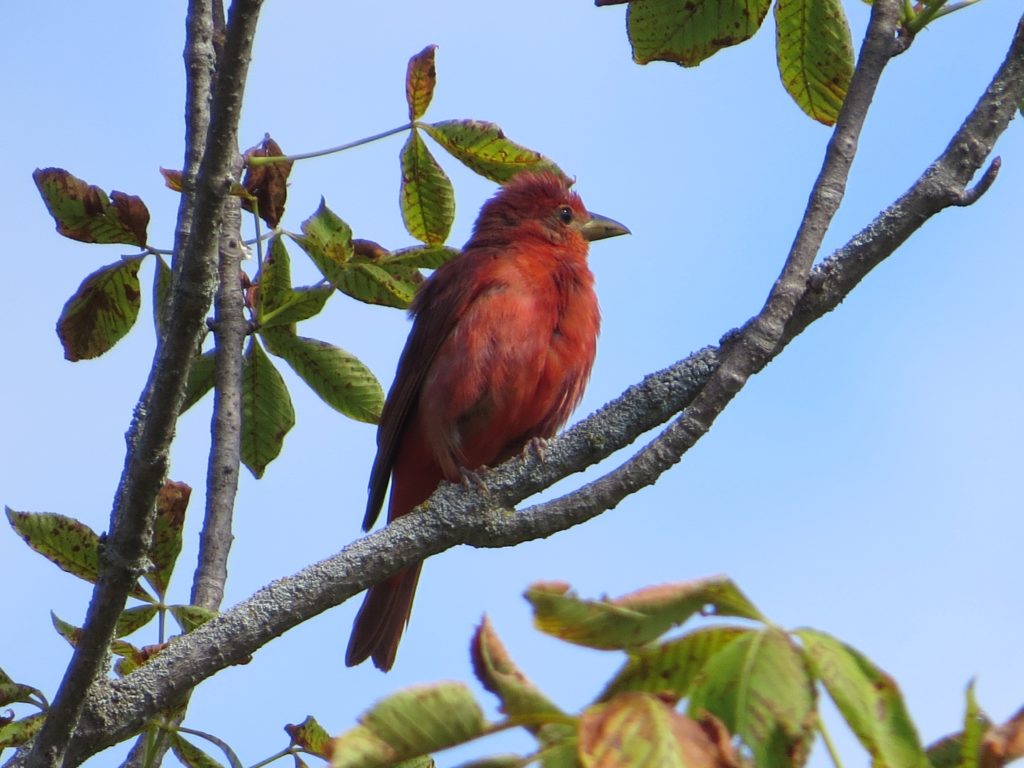 If you’ve been following ABWCH this past spring, you may recall that I already made a Summer Tanager chase to get my lifer. So why did I go after another if I’m not a county lister? Two reasons: this bird was solid red, unlike that tye-died creature I saw earlier this year, and this bird was singing on territory. I wanted the full SUTA experience. That quick migrant sighting didn’t fill the void. Plus this bird was relatively close to home, and I had the time off.
If you’ve been following ABWCH this past spring, you may recall that I already made a Summer Tanager chase to get my lifer. So why did I go after another if I’m not a county lister? Two reasons: this bird was solid red, unlike that tye-died creature I saw earlier this year, and this bird was singing on territory. I wanted the full SUTA experience. That quick migrant sighting didn’t fill the void. Plus this bird was relatively close to home, and I had the time off.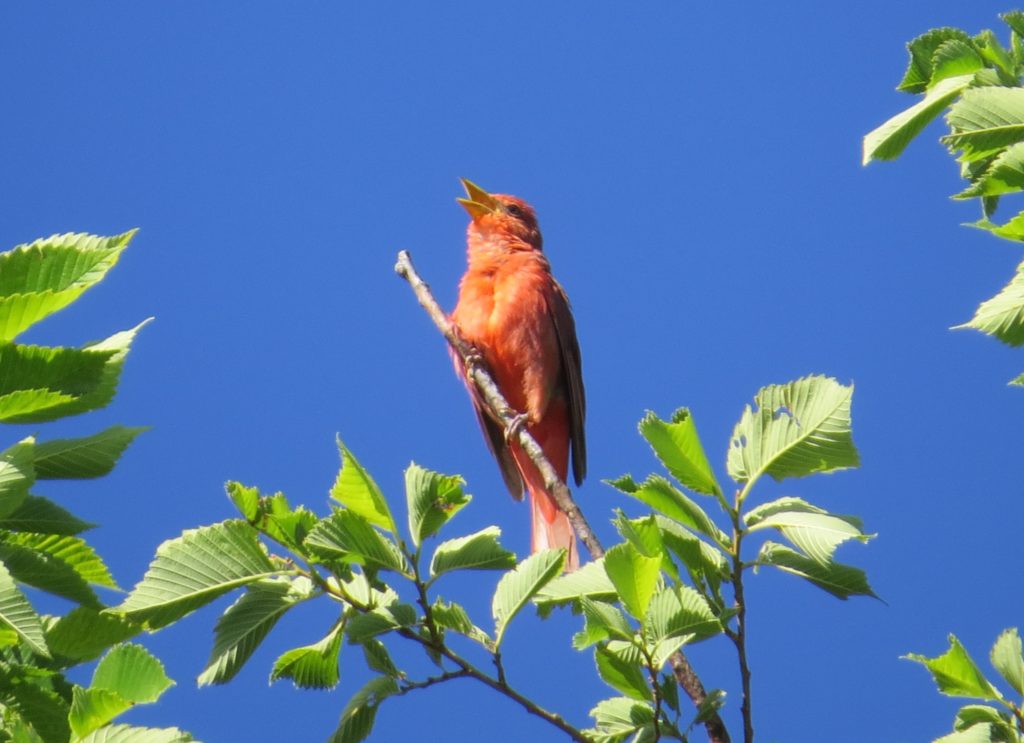 A couple of others who had the time off were teaching colleagues Brad Nelson and Theresa Nelson. The mother-son Nelson duo joined me on this little excursion. Our semi-annual birding get-togethers are always productive and fun–the last time the three of us met up was over a Snowy Owl near one of the towns in our district. Just like we had no problem getting that Owl, seeing this Tanager was a piece of cake. We could hear it singing immediately once we got out of the car at the nut trees section of the Arboretum where it apparently has set up shop for the season. We spent the better part of an hour following it around as it sang endlessly from its various perches, not even stopping its song while it feasted on insects:
A couple of others who had the time off were teaching colleagues Brad Nelson and Theresa Nelson. The mother-son Nelson duo joined me on this little excursion. Our semi-annual birding get-togethers are always productive and fun–the last time the three of us met up was over a Snowy Owl near one of the towns in our district. Just like we had no problem getting that Owl, seeing this Tanager was a piece of cake. We could hear it singing immediately once we got out of the car at the nut trees section of the Arboretum where it apparently has set up shop for the season. We spent the better part of an hour following it around as it sang endlessly from its various perches, not even stopping its song while it feasted on insects: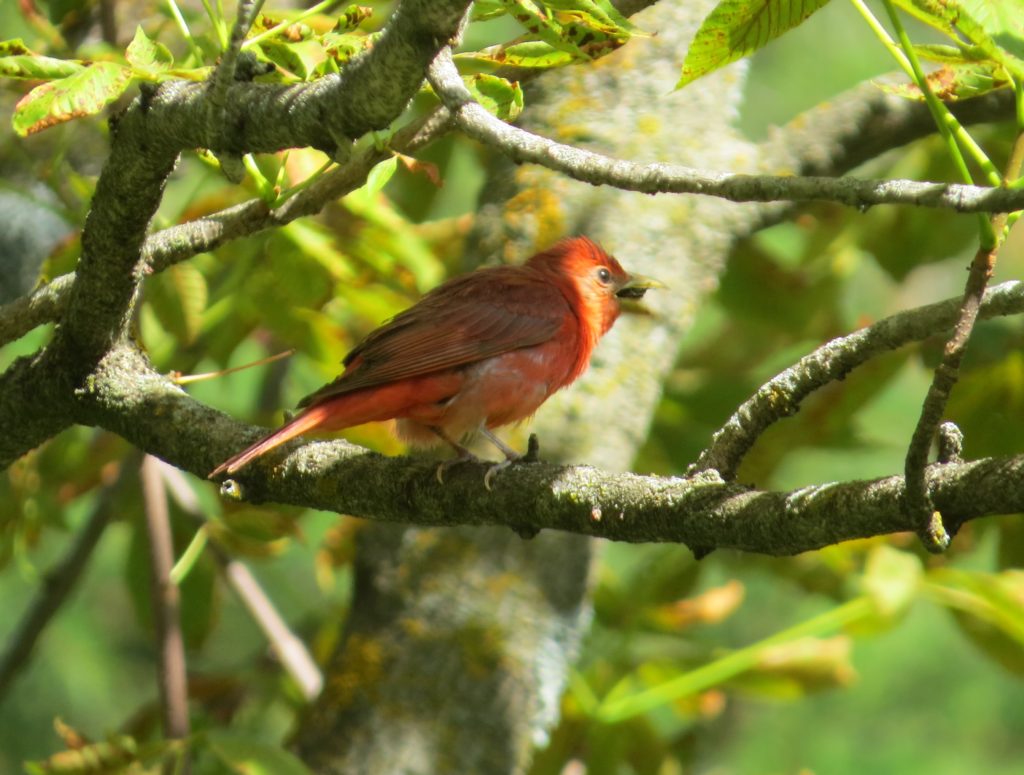
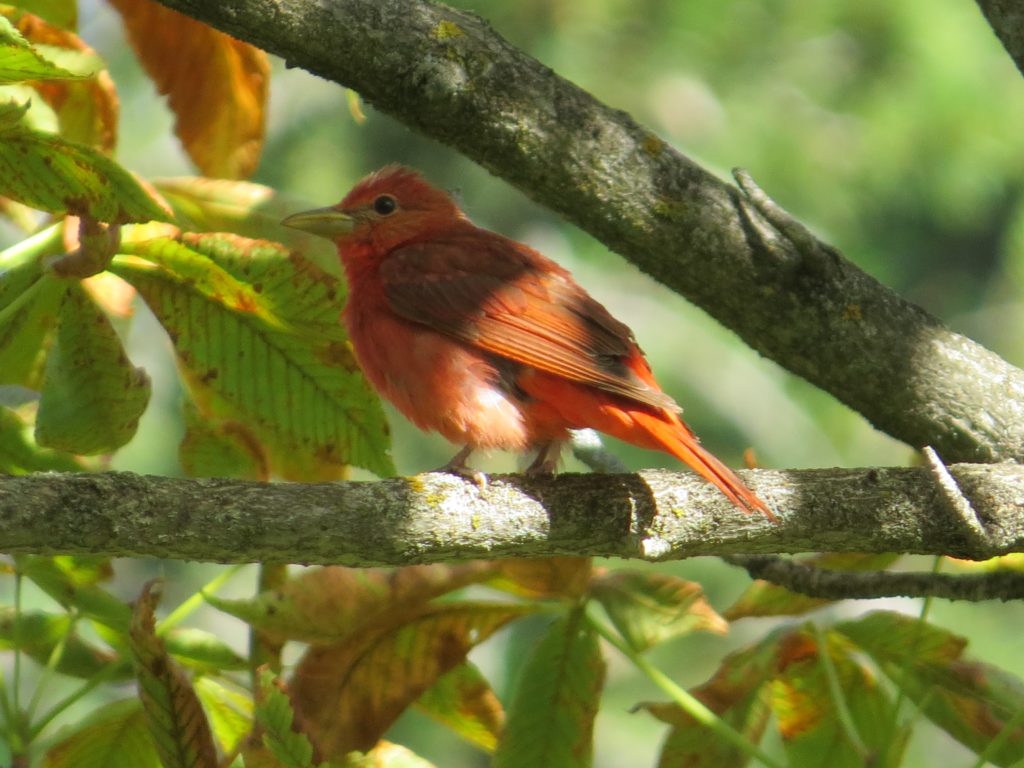 It’s been the year of the Tanager here in MN. To close out this post, here’s a pic of each of the two rare-regular Tanagers and a brand new Scarlet Tanager all seen in state this year. Sorry for turning the Scarlet into a trash bird on this blog. No, I’m not–they are still an exciting bird and this post celebrates all things Tanager.
It’s been the year of the Tanager here in MN. To close out this post, here’s a pic of each of the two rare-regular Tanagers and a brand new Scarlet Tanager all seen in state this year. Sorry for turning the Scarlet into a trash bird on this blog. No, I’m not–they are still an exciting bird and this post celebrates all things Tanager.